Sagem Wireless 95S2004 Tri Band GPRS/GSM Phone User Manual Megas User EN Revised
Sagem Wireless Tri Band GPRS/GSM Phone Megas User EN Revised
Revised Manual

User’s Manual
Revision: V.03
April, 2004

Trademarks
All brand and product names are trademarks or registered trademarks of their respective
companies.
Note
The information in this manual is subject to change without notice.

i
Safety Precautions
General Guidelines for Your Smartphone
Avoid placing the Smartphone in a location subject to extreme temperatures, high
humidity, or heavy dust.
The Smartphone and its accessories are not waterproof. Please keep them in a dry place.
Do not knock, shake, or toss the Smartphone. Doing so may cause leakage, overheating,
or fire.
Do not disassemble the Smartphone or its accessories without authorized permission.
Do not place the Smartphone near the edge of a surface, especially when the vibration
function of the Smartphone is turned on. The Smartphone may move and drop due to the
vibration.
Keep the Smartphone in place when driving. Do not place it on the passenger seat or
where it can break loose in a collision or sudden stop.
Do not delete files in the Windows folder of the Smartphone. Doing so may cause
malfunction.
Guidelines for Using the Phone Feature
Use the Smartphone in a normal position. Do not cover the antenna unnecessarily; doing
so may affect the communication quality and consume more power.
Use a phone headset or pull over your car first if using the Smartphone when driving.
Your Smartphone produces the electromagnetic wave with the specific absorption rate
(SAR) of 0.427 W/kg, lower than the standard value of 1.6W/kg. However, to reduce the
effects of the electromagnetic wave on the human body, please use the phone feature with
care. For example, make short calls as possible as you can.
Your Smartphone is a low-power RF (radio frequency) device. It receives and sends out
RF signals when the phone feature is turned on. Therefore, be careful of the following:
• Most RF devices are shielded from RF signals. However, your Smartphone may still
interfere with or get interfered by nearby devices, such as a TV set, radio, or
computer.
• Turn off the phone feature where posted notices are set up to avoid interference or
danger.
• Turn off the phone feature near hospitals or medical equipment (such as pacemakers
or hearing aids) to avoid interference.
• Turn off the phone feature near gas stations, fuel depots, chemical factories, or
blasting areas.
• Turn off the phone feature on an aircraft to avoid interference with the flight
instruments for possible danger.

ii
Guidelines for Using the AC Adapter
Use only the AC adapter (PHIHONG, PSC05R-050) supplied with your Smartphone. Use
of another type of AC adapter will result in malfunction and/or danger.
This product is intended to be supplied by a LISTED Power Unit marked with “LPS”,
“Limited Power Source” and output rated + 5 V dc / 1 A.
Do not use the adapter in a high moisture environment. Never touch the adapter when
your hands or feet are wet.
Allow adequate ventilation around the adapter. Avoid locations with restricted airflow.
Connect the adapter to a proper power source. The voltage and grounding requirements
are found on the product case and/or packaging.
Do not use the adapter if the cord becomes damaged.
Do not attempt to service the unit. There are no serviceable parts inside. Replace the unit if
it is damaged or exposed to excess moisture.
Guidelines for Using the Battery
CAUTION: Risk of explosion if battery is replaced by an incorrect type.
Dispose of used batteries according to the instructions.
Replace only with the same or equivalent type recommended by the manufacturer.
Do not mutilate, puncture, or dispose of battery in fire. The battery can burst or explode,
releasing hazardous chemicals.
Do not short-circuit the battery terminals.
Do not immerse, throw the battery in water or seawater.
Do not use, charge and leave the battery at high temperature.
The temperature during charging/discharging periods must be kept within 0℃ (32℉) to
40℃ (104 ℉). Otherwise the battery might be damaged.
Must be recycled or disposed of properly.
Use the battery only in the specified equipment.
Use a specified charger approved by the manufacturer.
Use only a specified battery (eMore, MIFES-ISTO) in the Smartphone.
Use only a specified USB cradle approved by the manufacturer.

iii
Preface
Welcome
Congratulations on purchasing Sagem My S-7, a Windows Mobile™ Smartphone.
Your Smartphone is more than a mobile phone. It not only provides the full features of a
GPRS mobile phone, but also allows you to take photos, record videos, browse the Internet
and WAP web pages, receive and send messages (such as emails, instant messages and MMS
multimedia messages), listen to music, play JAVA games, and lots more. Whenever you need
to communicate, capture images, search for information, send messages or enjoy yourself, the
Smartphone can help you get what you want any time any place.
With the Windows Mobile™ for Smartphone operating system, you can always use
Microsoft® ActiveSync® to synchronize your personal Microsoft Outlook data between the
Smartphone and desktop computer, including Contacts, Calendar, Inbox, and Tasks.
About this Manual
This manual is composed of three parts.
Part I “System Manual” tells you how to use the Smartphone, including the basic
operations, core programs of Windows Mobile™, and the system settings.
Part II “Software Manual” gives information on the “additional software” (in addition
to the core programs of Windows Mobile™), including the add-on programs and games
provided by your Smartphone manufacturer.
Part III “References” provides the reference information, such as the product
specifications.
|NOTE}
When the commands are connected with an arrow ( ), select them in that
order.
Some of the features are provided by the wireless mobile network services and
not described in details in this manual. Please contact your service provider for
further information.
Depending on the continuing developments of the product, the software
supplied with your Smartphone may be changed or updated. If there is any
difference between the information in this manual and your product, the
operation should be based on the product you have.

iv
Where to Find Information
If you cannot find information in this manual, refer to the following table to acquire the
specific information:
For information on See this source
First time startup Quick Start Guide
Chapter 7 of this manual More information on Microsoft ActiveSync
ActiveSync Help on your desktop computer
The readme files in the “Microsoft
ActiveSync” folder on your desktop
computer or the Smartphone Companion CD
Last-minute updates and detailed technical
information
The Microsoft Web site:
www.microsoft.com

v
Table of Contents
Safety Precautions...............................................................................................i
Preface............................................................................................................... iii
Safety Precautions...............................................................................................i
General Guidelines for Your Smartphone ................................i
Guidelines for Using the Phone Feature ..................................i
Guidelines for Using the AC Adapter ...................................... ii
Guidelines for Using the Battery ............................................. ii
Preface iii
Welcome ................................................................................ iii
About this Manual................................................................... iii
Where to Find Information...................................................... iv
Table of Contents................................................................................................v
Part I System Manual..........................................................................................1
1 Getting Started ....................................................................................3
1.1 Hardware Features..................................................................4
Front Components...................................................................4
Back Components ...................................................................5
Side Components....................................................................5
Top and Bottom Components .................................................6
ActiveSync Cable and USB Cradle .........................................6
1.2 Installing SIM Card and Battery ..............................................7
1.3 Charging the Battery ...............................................................8
1.4 Turning Your Smartphone on and off......................................9
Turning on ...............................................................................9
Turning off ...............................................................................9
Power Management ................................................................9
1.5 Installing ActiveSync .............................................................10
1.6 Expanding Your Smartphone ................................................12
Accessories ...........................................................................12
Using the Phone Headset .....................................................12
Using a SD/MMC Card..........................................................13
2 Basic Skills.........................................................................................15
2.1 Navigation Methods...............................................................16
Navigation Stick.....................................................................16
Home Key..............................................................................16
Back Key ...............................................................................16
Soft Keys ...............................................................................17
Numeric Keypad....................................................................17
2.2 Home Screen and Screen Elements.....................................18
Home Screen ........................................................................18
Status Indicators....................................................................19

vi
Start List ............................................................................... 20
Menus................................................................................... 20
Quick List.............................................................................. 21
2.3 Entering Text and Numbers ................................................. 22
Entering Numbers in Numeric Mode .................................... 23
Entering Symbols ................................................................. 24
Miscellaneous Input Tasks ................................................... 24
2.4 Securing the Smartphone..................................................... 25
Locking the Keypad.............................................................. 25
Locking the Smartphone ...................................................... 26
Locking the SIM Card ........................................................... 27
3 Using the Phone ............................................................................... 29
3.1 Making a Call........................................................................ 30
Making a Call from the Home Screen .................................. 30
Making a Call from Contacts ................................................ 31
Making a Call Using a Recently Dialed Number .................. 31
Making a Call from the Call History List ............................... 32
Making a Call from a Hyperlink Phone Number ................... 32
Making a Call from Speed Dial............................................. 32
3.2 Responding to an Incoming Call .......................................... 33
Answering an Incoming Call................................................. 33
Rejecting an Incoming Call................................................... 33
3.3 Managing More than One Call ............................................. 34
Holding a Call to Take a Second Call................................... 34
Rejecting the Second Call .................................................... 34
Holding a Call to Make a Second Call.................................. 34
Swapping between Calls ...................................................... 34
Setting up a Conference Call ............................................... 34
3.4 In-call Options....................................................................... 35
Adjusting the Phone Volume ................................................ 35
Speakerphone ...................................................................... 35
In-call Options....................................................................... 35
3.5 Call History ........................................................................... 36
Viewing Call History ............................................................. 36
Call History Menu Commands.............................................. 36
3.6 Speed Dial ............................................................................ 37
Creating a Speed Dial .......................................................... 37
Editing a Speed Dial............................................................. 37
Deleting a Speed Dial........................................................... 38
Viewing the Speed Dial List.................................................. 38
3.7 Voice Mail ............................................................................. 39
Setting up the Voice Mail Phone Number ............................ 39
Checking Your Voice Mail .................................................... 39
3.8 International Call................................................................... 40
3.9 Turning off the Radio............................................................ 41
4 Setting up Your Smartphone ............................................................ 43
4.1 Settings (Page 1).................................................................. 44
Phone ................................................................................... 45
Sounds ................................................................................. 48
Profiles.................................................................................. 50
Home Screen........................................................................ 51
About .................................................................................... 52
Accessibility .......................................................................... 53

vii
Beam .....................................................................................53
Bluetooth ...............................................................................53
4.2 Settings (Page 2)...................................................................54
Certificates ............................................................................55
Data Connections..................................................................55
Date and Time.......................................................................60
Owner Information.................................................................61
Power Management ..............................................................61
Regional Settings ..................................................................61
Remove Programs ................................................................62
Security .................................................................................62
4.3 Settings (Page 3)...................................................................63
Advance Settings ..................................................................63
5 Messaging Features ..........................................................................65
5.1 Understanding Messaging Types..........................................66
E-mail Messaging..................................................................66
Text Messaging (SMS)..........................................................66
Media Messaging (MMS) ......................................................67
Instant Messaging .................................................................67
5.2 Setting up Messaging Accounts............................................68
Setting up Outlook Synchronization ......................................68
Setting up an Internet E-mail Account...................................68
5.3 Working with Accounts ..........................................................70
5.4 Creating Messages ...............................................................71
Creating a Message in Messaging........................................71
Creating a Message from a Contact Card ............................72
Using Predefined Text in Messages .....................................72
Inserting Voice Recordings into Messages...........................73
Inserting Pictures into Messages ..........................................73
Inserting Sounds into Messages ...........................................73
Inserting Signatures into Messages ......................................74
Saving a Draft of a Message.................................................74
Requesting a Delivery Receipt..............................................75
5.5 Sending and Receiving Messages........................................76
Sending and Receiving Media Messages .............................76
Sending and Receiving Text Messages................................76
Sending and Receiving E-Mail Messages ............................77
5.6 Viewing and Responding to Messages .................................78
Working with the Message List .............................................78
Working with Messages ........................................................78
Working with Large Messages and Attachments..................80
Accepting Meeting Requests ................................................83
5.7 Working with Message Folders .............................................84
5.8 MSN Messenger....................................................................86
Using MSN Messenger .........................................................86
6 Contacts, Calendar, and Tasks ..........................................................89
6.1 Contacts 90
Viewing Contacts...................................................................90
Creating a New Contact ........................................................92
Deleting a Contact.................................................................92
Finding a Contact ..................................................................92
Editing a Contact...................................................................93
Selecting a Ring Tone for a Contact .....................................93

viii
Copying Phone Numbers from SIM Card to Contacts ......... 93
Copying Phone Numbers from Contacts to SIM Card ......... 94
Calling a Contact .................................................................. 94
6.2 Calendar 96
Creating a New Appointment ............................................... 96
Viewing an Appointment....................................................... 96
Editing an Appointment ........................................................ 96
Deleting an Appointment ...................................................... 97
Viewing Your Schedule ........................................................ 97
Importing Calendar Information............................................ 98
6.3 Tasks 99
Creating a New Task............................................................ 99
Viewing the Task List ......................................................... 100
6.4 Voice Notes ........................................................................ 101
Creating a Voice Note ........................................................ 101
Listening to a Recording..................................................... 101
6.5 Beaming Information .......................................................... 102
Beaming a Contact or an Appointment .............................. 102
Receiving Beamed Information .......................................... 102
7 ActiveSync ...................................................................................... 103
7.1 Understanding ActiveSync ................................................. 104
7.2 Setting up ActiveSync ........................................................ 105
Creating a Partnership ....................................................... 105
Configuring an Exchange Server Connection .................... 105
Changing ActiveSync Settings Later .................................. 106
Creating a Synchronization Schedule ................................ 107
Synchronizing Automatically .............................................. 108
7.3 Synchronizing Information.................................................. 110
Starting and Stopping Synchronization .............................. 110
Synchronization Methods ................................................... 110
7.4 Deciding Which Information to Synchronize ...................... 112
Synchronizing Outlook E-mail ............................................ 112
Synchronizing Calendar ..................................................... 112
Synchronizing Contacts...................................................... 113
Synchronizing Tasks .......................................................... 113
7.5 ActiveSync Error Messages ............................................... 114
8 Internet, Entertainment, and More .................................................. 115
8.1 Internet Explorer ................................................................. 116
Browsing the Web .............................................................. 116
Using the Favorites List...................................................... 117
Refreshing Web Pages ...................................................... 117
Customizing Pocket Internet Explorer................................ 118
8.2 Media Player....................................................................... 119
Playing Video and Audio Files............................................ 119
Using Menu Commands When Playing a File.................... 120
Using Media Player Favorites ............................................ 121
Understanding Licenses ..................................................... 122
Media Player Compatibility................................................. 122
8.3 Modem Link ........................................................................ 124
Setting up an Infrared Connection...................................... 124
Setting up a USB Connection............................................. 124
8.4 Games 127
Solitaire............................................................................... 127

ix
Jawbreaker..........................................................................128
8.5 Calculator ............................................................................129
Part II Software Manual ..................................................................................130
9 Using the Digital Camera.................................................................131
9.1 Phone Camera ....................................................................132
Taking Photos .....................................................................132
Continuous Shots ................................................................133
Recording Videos ................................................................134
Phone Camera Settings ......................................................135
Notes on Using Phone Camera ..........................................136
9.2 Phone Viewer ......................................................................137
Viewing Photos....................................................................137
Adding a Theme to a Photo ................................................139
Adding a Memo to a Photo..................................................139
Renaming a Photo...............................................................141
Adding a Special Effect to a Photo......................................141
Cropping a Photo ................................................................142
Slide Show ..........................................................................142
Phone Viewer Menu Commands ........................................143
9.3 Video Player ........................................................................144
Playing Videos.....................................................................144
Video Player Menu Commands ..........................................145
10 More Programs................................................................................147
10.1 Photo ID 148
Assigning a Photo ID to a Contact ......................................148
Adding a Contact Using Photo ID .......................................150
Deleting a Contact...............................................................151
Editing a Contact .................................................................151
Viewing Modes ....................................................................151
Managing Contact Groups ..................................................154
Photo ID Settings ................................................................155
10.2 Orange Progr ams ................................................................ 156
Orange Backup ...................................................................156
Orange Update....................................................................156
10.3 Java Gam e.......................................................................... 157
Opening Java ......................................................................157
Burning Rush.......................................................................157
Part III References ..........................................................................................159
11 References ......................................................................................161
11.1 Produc t Specif ication ..........................................................162
11.2 Frequen tly-as ked Question s ............................................... 163
11.3 Restoring Factory Default State ..........................................164
11.4 Regulat ory Inform ation........................................................165
European Notice..................................................................165
FCC Notice:.........................................................................166
4RF Exposure Information (SAR)......................................167
12 Index .............................................................................................169

1
Part I
System Manual

3
1 Getting Started
This chapter introduces you to the external components of your Smartphone and guides you
through the process of setting up your Smartphone for use.
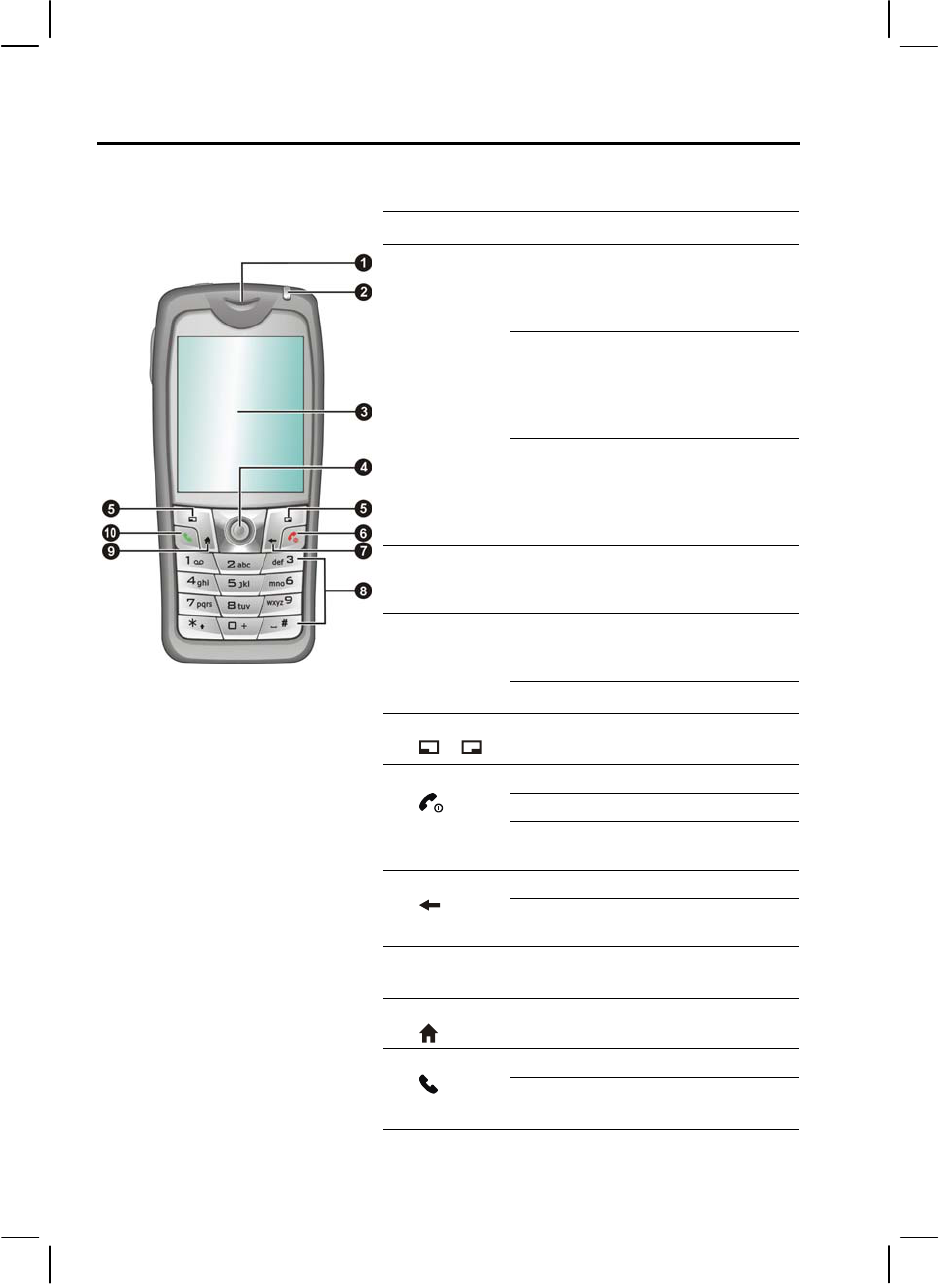
4
1.1 Hardware Features
Front Components
Earpiece Serves as the phone earpiece.
Battery Charge Status (only when
the Smartphone is off):
Glowing orange indicates that battery
charging is in progress.
Wireless Radio Status:
Flashing green indicates that the
wireless radio is on.
Flashing green and red in turns
indicates unread messages.
Status
Indicator
Low Battery Status:
Flashing orange indicates low
battery when the wireless radio is on.
Flashing red indicates low battery
when the wireless radio is off.
Screen Displays the Home screen, status
icons, active programs and soft key
commands.
Moves up, down, left, or right by
pushing the stick toward the
corresponding direction.
Navigation
Stick
Selects by pressing.
Soft Key
Performs the command shown on the
display immediately above the keys.
Turns your Smartphone on or off.
Ends or rejects a call.
End Key
Press and hold to display the Quick
List.
Navigates to the previous screen.
Back Key
Backspaces over one or more
characters when you are in a text field.
Numeric
Keypad
Enters numbers and characters.
Home Key
Displays the Home screen.
Dials or answers a call.
Talk Key
Press and hold during a call to switch
to the speakerphone mode.
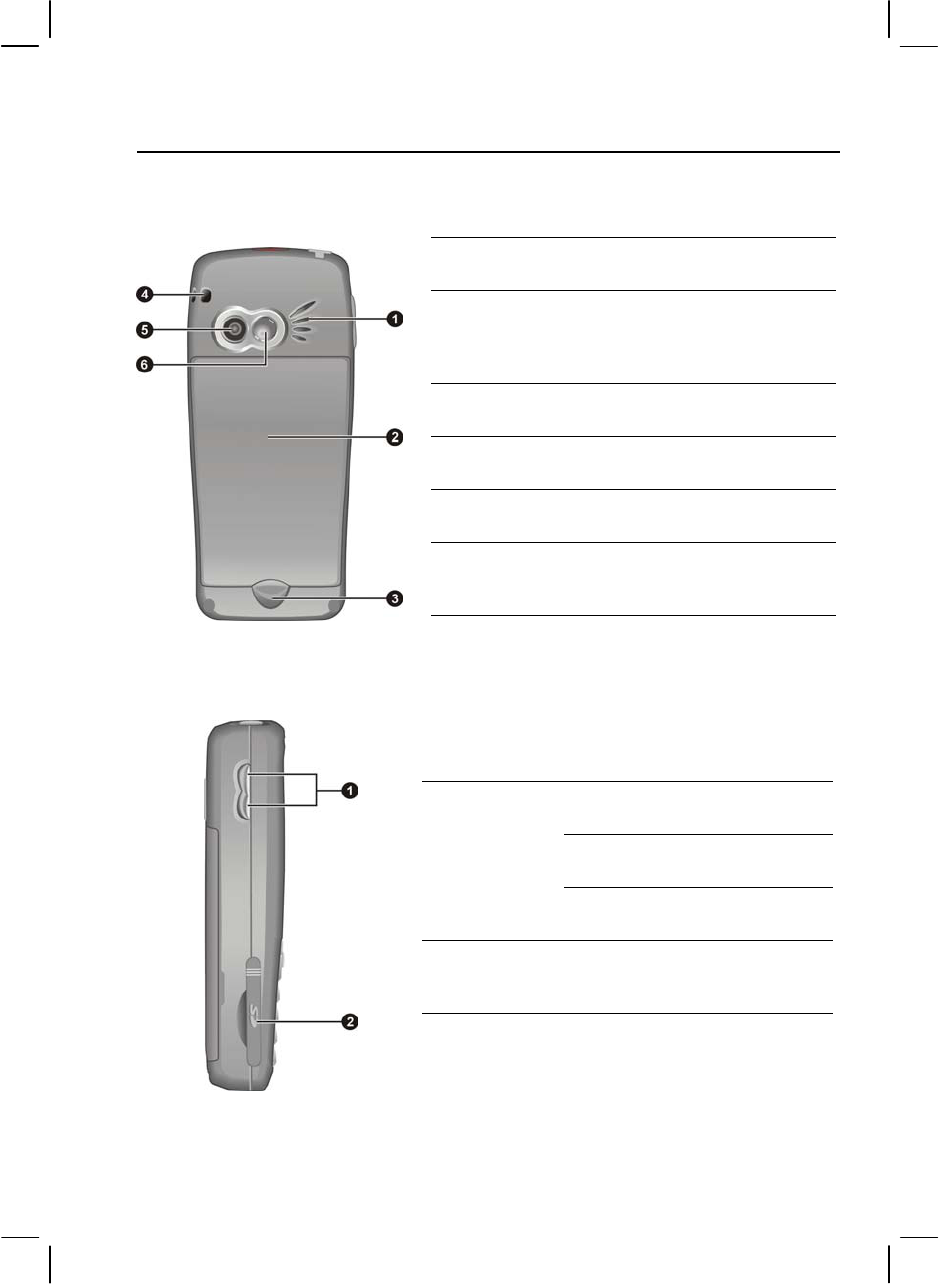
5
Back Components
Speaker Sends out music, sounds, and
voice.
Battery Serves as the internal power
source for your Smartphone. You
can recharge the battery by
connecting to AC power.
Battery
Lock
Secures the battery in place.
Hand String
Hole
Hand string attaches to this hole.
Camera
Lens
Takes photos or records videos.
Viewing
Mirror
Lets you see your own reflection
in the small mirror when taking
photos of yourself.
Side Components
Adjusts the volume by pressing the
upper or lower button.
Press to immediately silence the
ring of an incoming call.
Volume
Control
Press and hold the upper button to
record voice.
SD/MMC
Card Slot
Accepts an optional SD/MMC card
for extended memory capacity or
input/ouput functions.
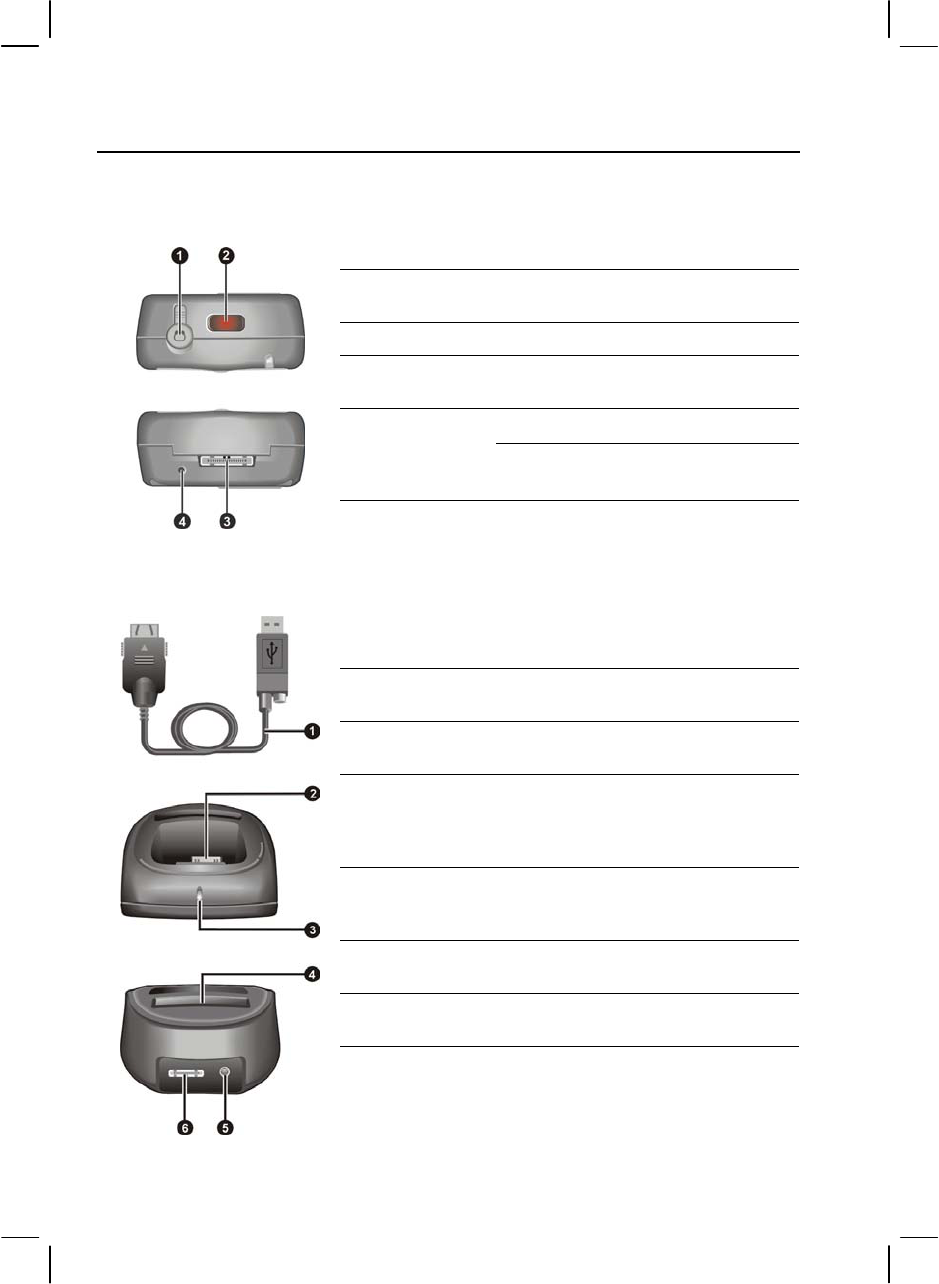
6
Top and Bottom Components
Headphone
Connector
Connects to a pair of stereo headphones
or a hands-free phone headset.
IR Port Beams files to other mobile devices.
ActiveSync
Connector
Connects to the ActiveSync cable.
Serves as the mouthpiece during a call.
Microphone
Receives sound and voice to record
voice.
ActiveSync Cable and USB Cradle
ActiveSync
Cable
Connects your Smartphone to a desktop
computer.
Smartphone
Connector
Connects your Smartphone.
Charge
Indicator
Glows in orange to indicate that the
battery in the battery compartment is
being charged. When the battery is fully
charged, the indicator goes off.
Battery
Compartment
Connects an additional battery or the
battery removed from your Smartphone
for charging.
Power
Connector
Connects the AC adapter.
ActiveSync
Connector
Connects the ActiveSync cable.
Cradle Front
Cradle Back
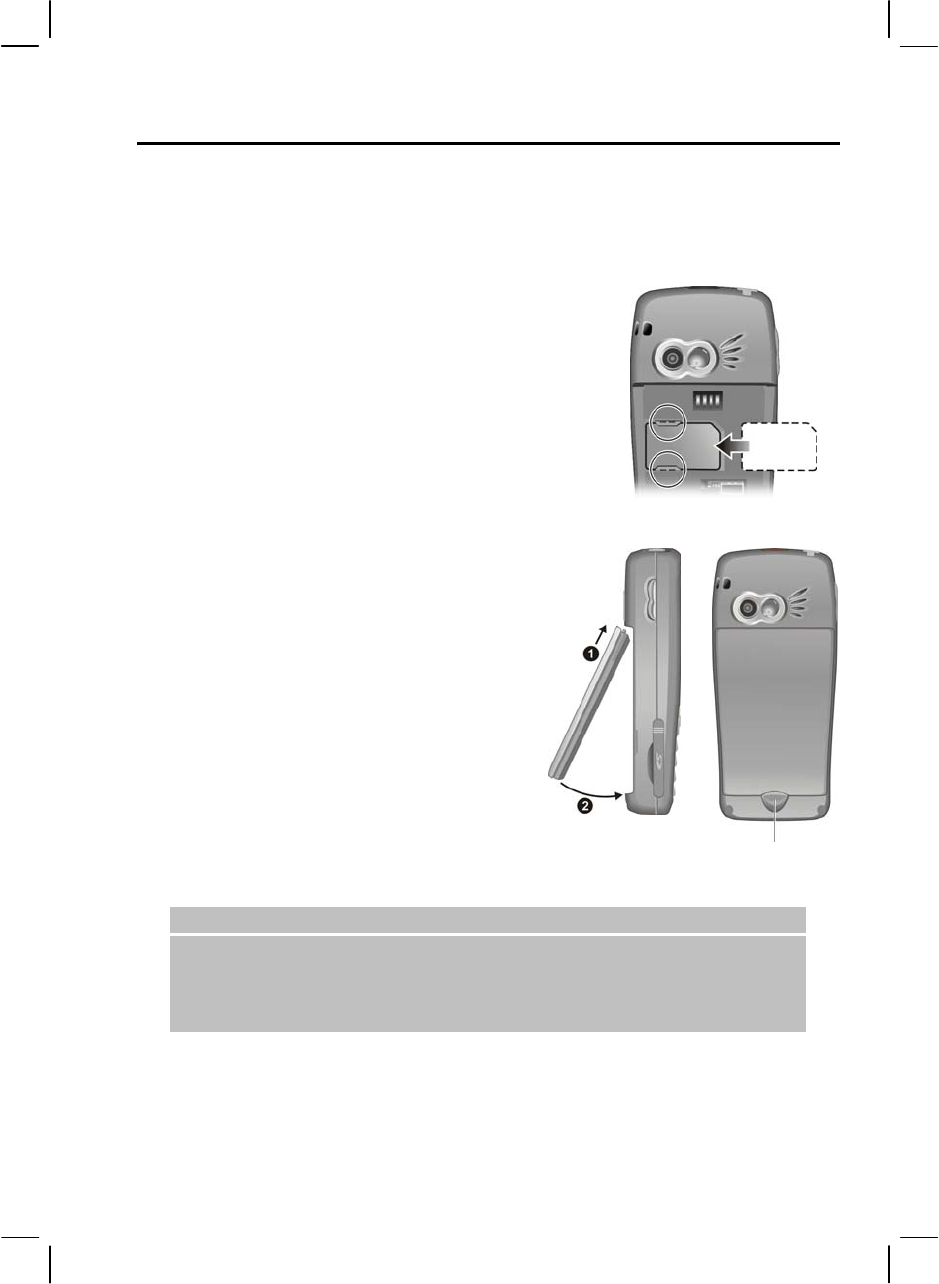
7
1.2 Installing SIM Card and Battery
After applying for an account with a mobile phone service provider, you will be provided a
SIM (Subscriber Identification Module) card. This card contains your mobile phone account
details, contacts that can be stored and any additional services to which you have subscribed.
You must install a SIM card before you can make or receive phone calls or use wireless data
services.
1. Insert the SIM card with the contact area facing
downward (the angled corner is in the upper-right
position). Make sure that the SIM card is slided below
the two metal holders.
2. To install the battery, insert the two projecting
p
arts on the battery into the holes in the battery
compartment, and then close the battery. You
should hear a “click” sound when the battery
lock is engaged.
|NOTE}
To remove the battery, push the battery lock downward. The battery will pop
out slightly for removing.
Insert and remove the SIM card with care. Do not bend the SIM card or scratch
the contact area.
Battery lock
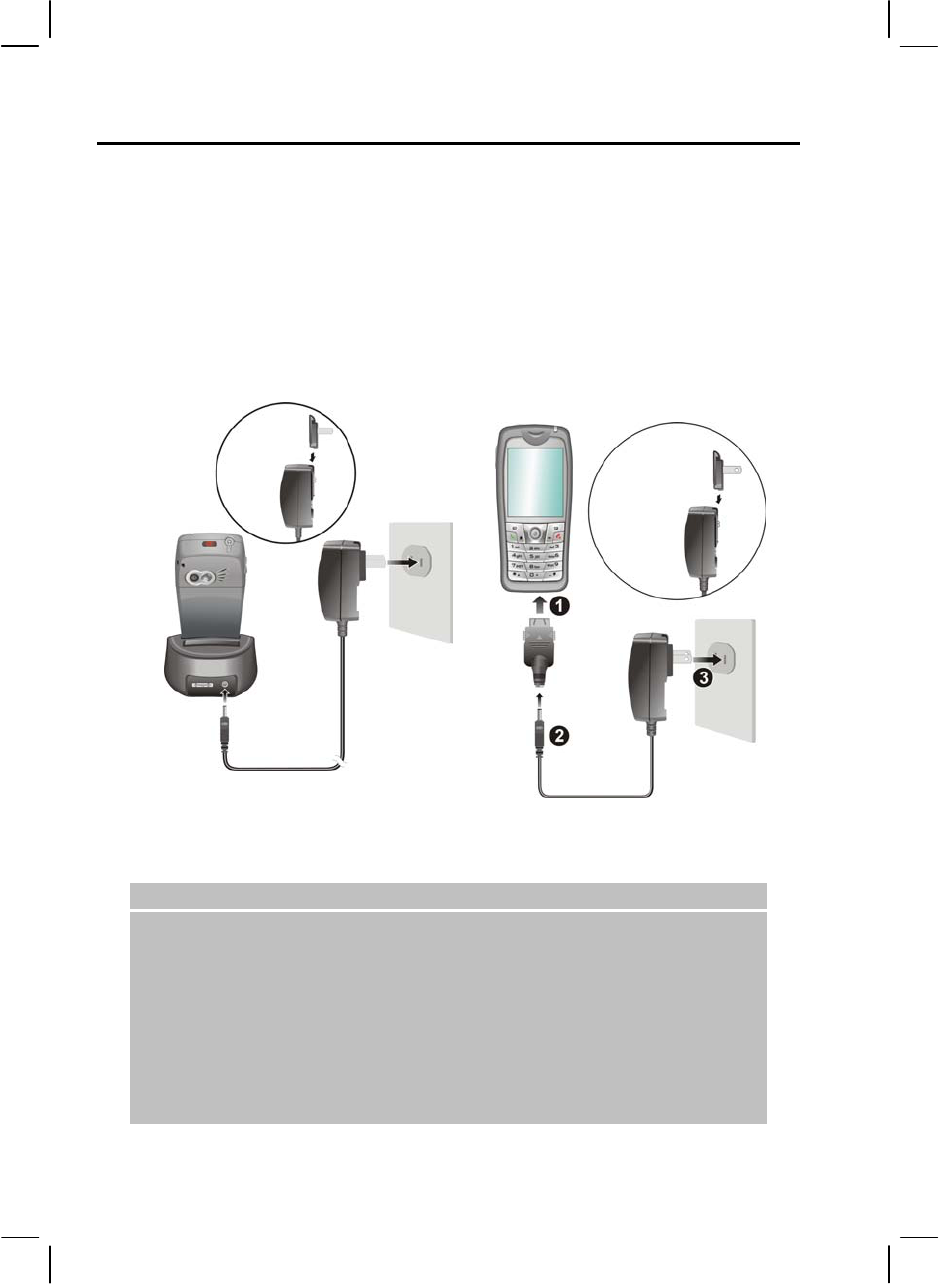
8
1.3 Charging the Battery
You must fully charge the battery before starting to use your Smartphone for the first time.
1. Attach the converter to the AC adapter.
2. Connect to AC power. You can connect with the USB cradle or without it.
With the USB Cradle
Slide your Smartphone into the cradle.
Connect the appropriate end of the
AC adapter to the USB cradle.
Plug the other end of the AC adapter
into a wall outlet.
Without the USB Cradle
Connect the USB adapter to the bottom o
f
your Smartphone.
Connect the appropriate end of the AC
adapter to the USB adapter.
Plug the other end of the AC adapter
into a wall outlet.
3. The status indicator on the Smartphone glows orange to indicate that battery charging is in
progress. The indicator is off when the battery is fully charged.
|NOTE}
When charging the battery for the very first time, you should charge it for at
least eight hours.
A discharged battery can be fully charged after two hours. The charging time
may vary under different conditions.
When a fully discharged battery is being charged, you can turn on the
Smartphone only after it connects to the AC power for at least five minutes.
You can remove the battery and put it in the cradle’s battery compartment for
charging.
You may use your Smartphone during charging.
Converte
r
Converte
r

9
1.4 Turning Your Smartphone on and off
Turning on
1. Press and hold the End key . The backlight of the keypad will glow, and your
Smartphone will display startup screens and then the Home screen.
2. If the service provider (or you) has set the PIN, you will be prompted to enter the PIN.
Enter the PIN and press the OK soft key. (For details on PIN, see “Locking the SIM Card”
in section 2.4.)
3. Your Smartphone starts to search the mobile network and the service provider’s name will
be displayed on the screen. You can now use your Smartphone.
Turning off
1. Press and hold the End key until the Quick List appears.
2. The first option is Power off. Press the Navigation stick or Select soft key to turn off your
Smartphone.
Power Management
By default, your Smartphone will automatically turn off the screen’s and keypad’s backlight
after being idle for 60 seconds. In addition, your Smartphone may enter the sleep mode,
causing the screen to blank, after being idle for a specific period of time. To end the sleep
mode, press the End key . The screen will restore. (For information on Power
Management, see “Power Management” in section 4.1.)
|NOTE}
The battery’s operating time relies on the mobile network status, the way you
use your Smartphone and the ambient environment. The power consumption
is higher under the following conditions:
• Your Smartphone has to frequently search mobile network because of weak
signals,
moving in high speed or being out of the range of the mobile network.
• You use the vibration function, hands-free solution, alarm, or play games.
• The backlight is on.
• The phone’s volume is set to maximum.
• You use the camera.
• The operating time is shorter in low temperatures.

10
1.5 Installing ActiveSync
You can use Microsoft® ActiveSync® technology to synchronize the information on your
Smartphone with information on your desktop computer and optionally, a server running
Microsoft® Exchange® Server with Exchange ActiveSync. When you do this, ActiveSync
compares the information on the Smartphone with the information on the desktop computer
and Exchange Server, and updates all locations, keeping you up to date with the most recent
information. You can even synchronize on a customizable schedule, or as items arrive.
|NOTE}
Before the installation, make sure that you have Microsoft Outlook installed on
your desktop computer. If you do not have Outlook or your version of Outlook is
earlier than the version provided on the Companion CD, install Outlook from
the Companion CD.
If you have an older version of ActiveSync installed on your desktop computer,
the installation wizard will inform you. When you choose to continue, the new
ActiveSync will replace the existing ActiveSync on your computer.
Do not connect your Smartphone to your desktop computer before ActiveSync
is installed.
During the New Partnership setup, select “Synchronize with this desktop
computer.” Do not select “Synchronize with Microsoft Exchange Server and/or
this desktop computer” unless you are sure that your company is running
Microsoft Exchange Server and Exchange ActiveSync. Contact your network
administrator or ISP for detailed information.
Before you can synchronize information with a desktop computer, you must first install
ActiveSync on your desktop computer and create a partnership between your Smartphone and
your desktop computer. Follow the procedure below:
1. Turn on your desktop computer.
2. Insert the Companion CD into the CD-ROM drive of your desktop computer.
3. Click the arrow on the first screen to enter the main screen and click Start Here.
4. In the following screen, click Install ActiveSync 3.7.1 on the left column.
5. In the following screen, click Install to start the installation.
6. If you use Windows XP, select Open when the “File Download” window appears on the
screen; if you use Windows 2000/Me/98, select Run this program from its current
location and click OK.
7. Follow the on-screen instructions to install ActiveSync.
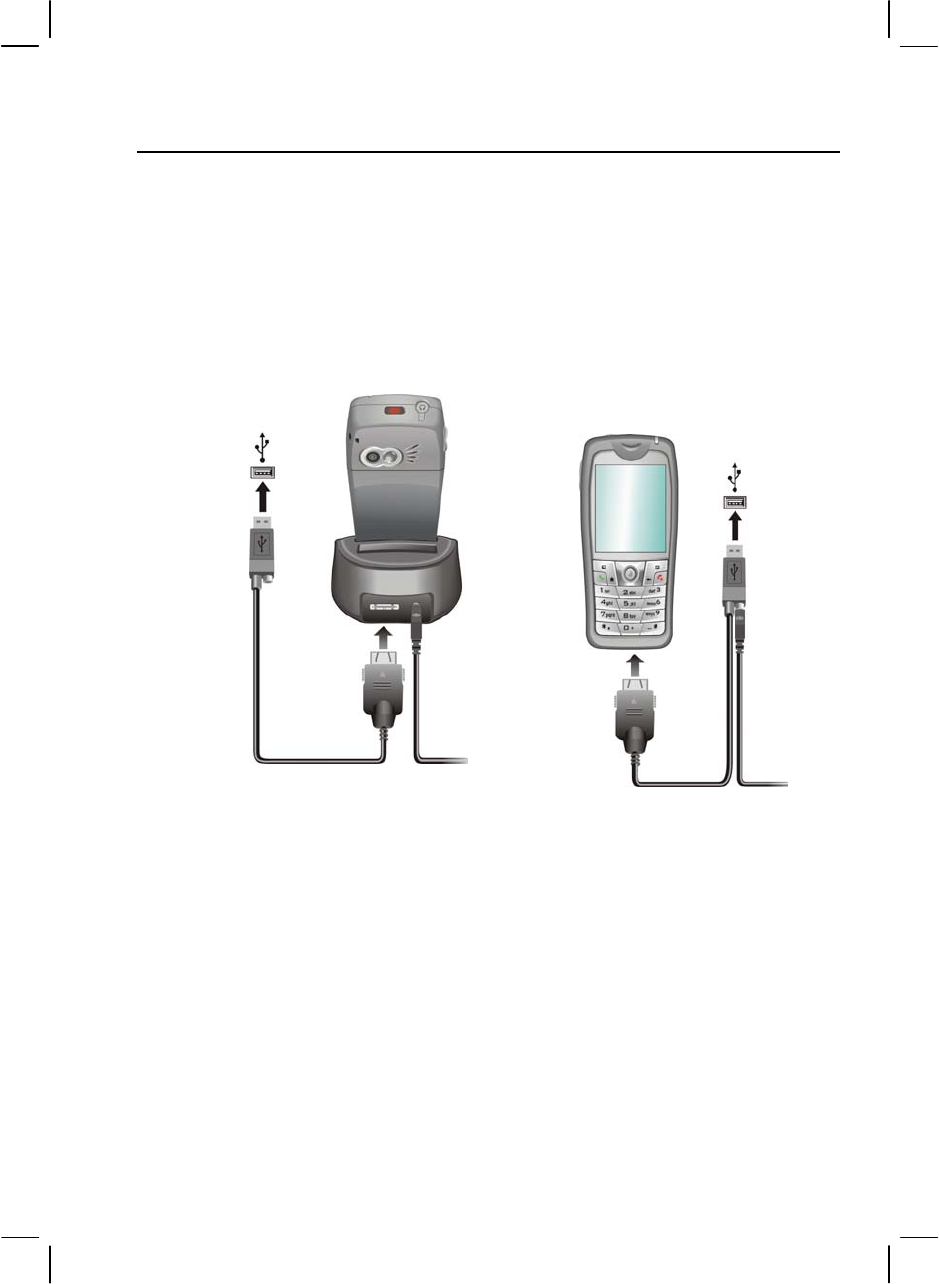
11
8. After ActiveSync is installed, you will be prompted to connect your Smartphone to your
desktop computer. You can connect with the USB cradle or without it.
With the USB Cradle
Slide your Smartphone into the cradle.
Connect the appropriate end of the
ActiveSync cable to the USB cradle.
Connect the other end to a USB port
on your desktop computer.
Without the USB Cradle
Connect the appropriate end of the
ActiveSync cable to the bottom of the
Smartphone.
Connect the other end to a USB port on
your desktop computer.
If you want to connect the AC adapter,
connect it to the ActiveSync cable.
9. The “Add New Hardware Wizard” should automatically install the USB driver. (If you
need to specify the location of the driver, click Browse and select the CD-ROM drive
containing the Companion CD.)
10. Follow the on-screen instructions to establish a partnership and synchronize your
Smartphone with your desktop computer.
After synchronizing for the first time, take a look at Calendar, Contacts, and Tasks on the
Smartphone. You will notice that your information has been copied to the Smartphone. (For
more information on ActiveSync, see Chapter 7.)
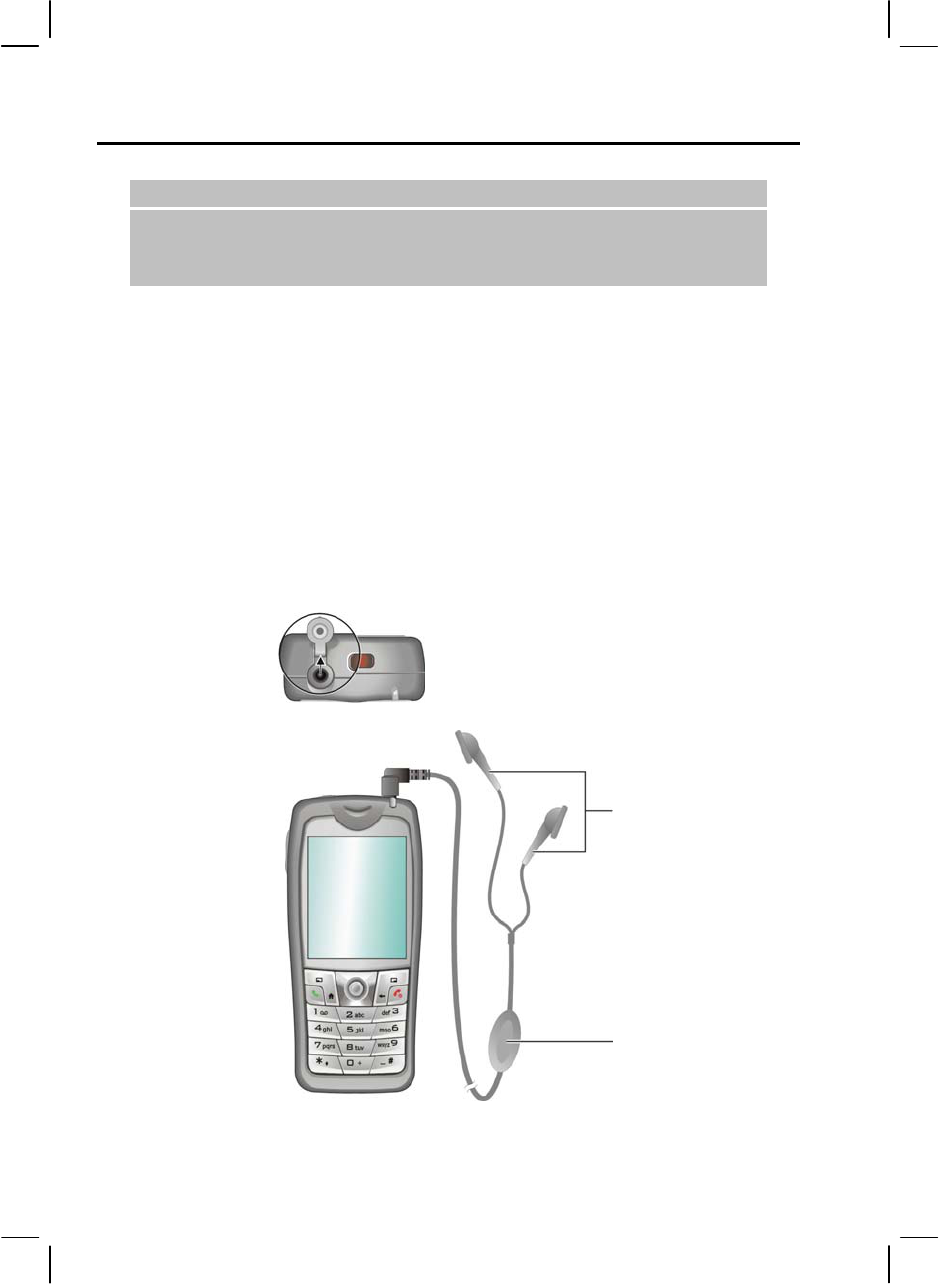
12
1.6 Expanding Your Smartphone
|NOTE}
The availability of accessories from the Smartphone manufacturer may vary by
regions. For the latest information, please contact your local dealer.
The use of unauthorized accessories will void your Warranty.
Accessories
You can expand the capabilities of your Smartphone or facilitate your operation by
purchasing accessories designed for your Smartphone. For example, you can use the
SD/MMC card and Car Kit.
Using the Phone Headset
The phone headset includes a microphone, an answer button and two earphones, allowing you
to talk conveniently using a hands-free solution.
Your Smartphone has an earphone connector on its top. Open the protective cover to plug the
phone headset cable.
Earphone
Microphone
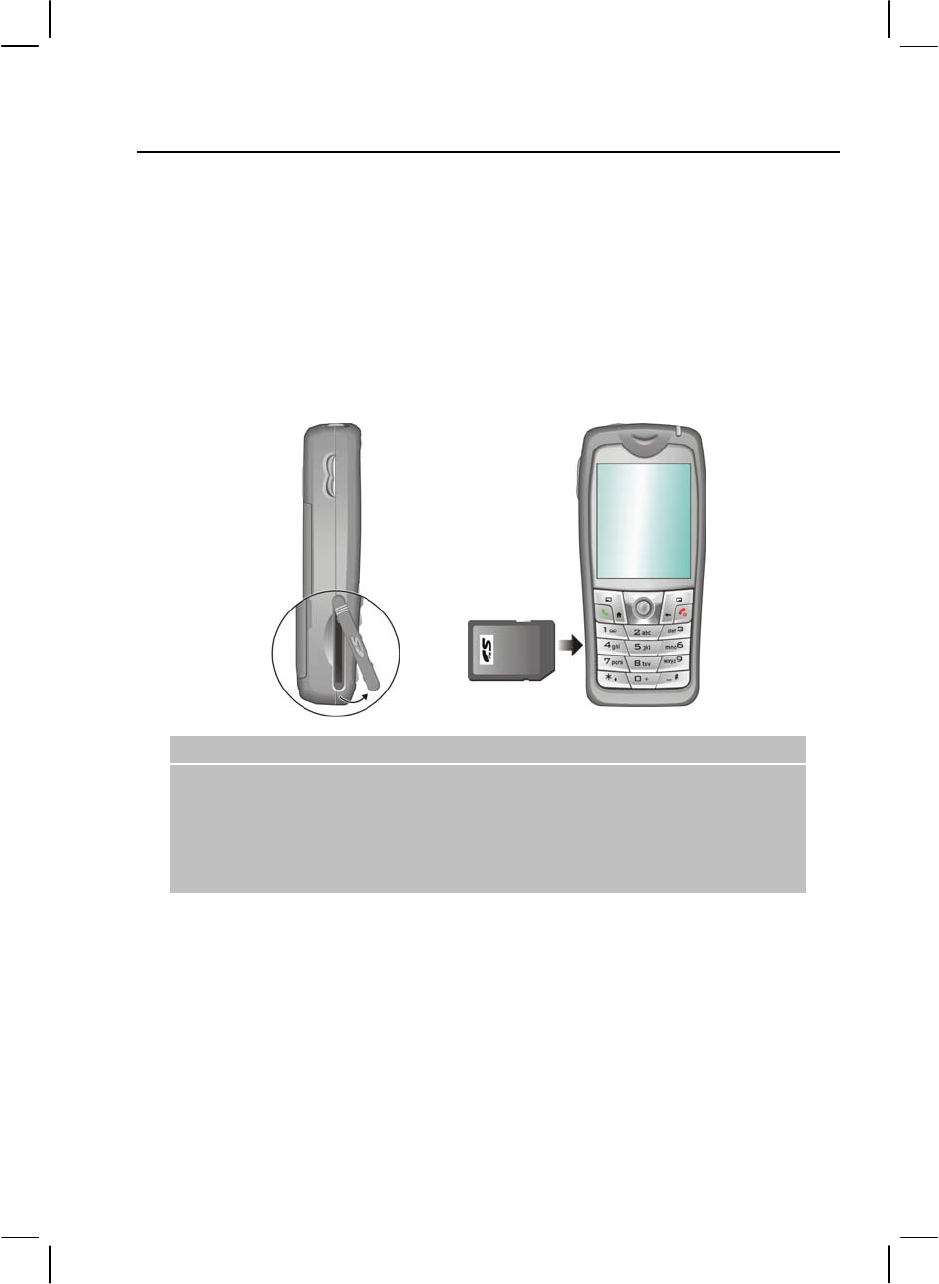
13
Using a SD/MMC Card
Your Smartphone has a SD/MMC card slot that accepts a SD (Secure Digital) or MMC
(MultiMediaCard) storage card or I/O card.
To insert a SD/MMC card, first open the protective cover. Insert the card with its label facing
the front and the connector pointing to the slot of the Smartphone, as shown in the diagram.
Then push it into the slot until it clicks into place. You can then close the protective cover.
To remove a card, first make sure that no application is accessing the card, then slightly push
the top edge of the card to release it and pull it out of the slot.
|NOTE}
A storage card is also called as a memory card.
For more information, please refer to the document of the SD/MMC card.
Make sure that no foreign objects enter the SD/MMC card slot.
Keep a SD/MMC card in a well-protected box to avoid dust and humidity when
you are not using it.

15
2 Basic Skills
This chapter familiarizes you with the basic skills of using your Smartphone, such as using the
Navigation stick, understanding the Home screen and screen elements, entering text and
numbers, and securing your Smartphone.
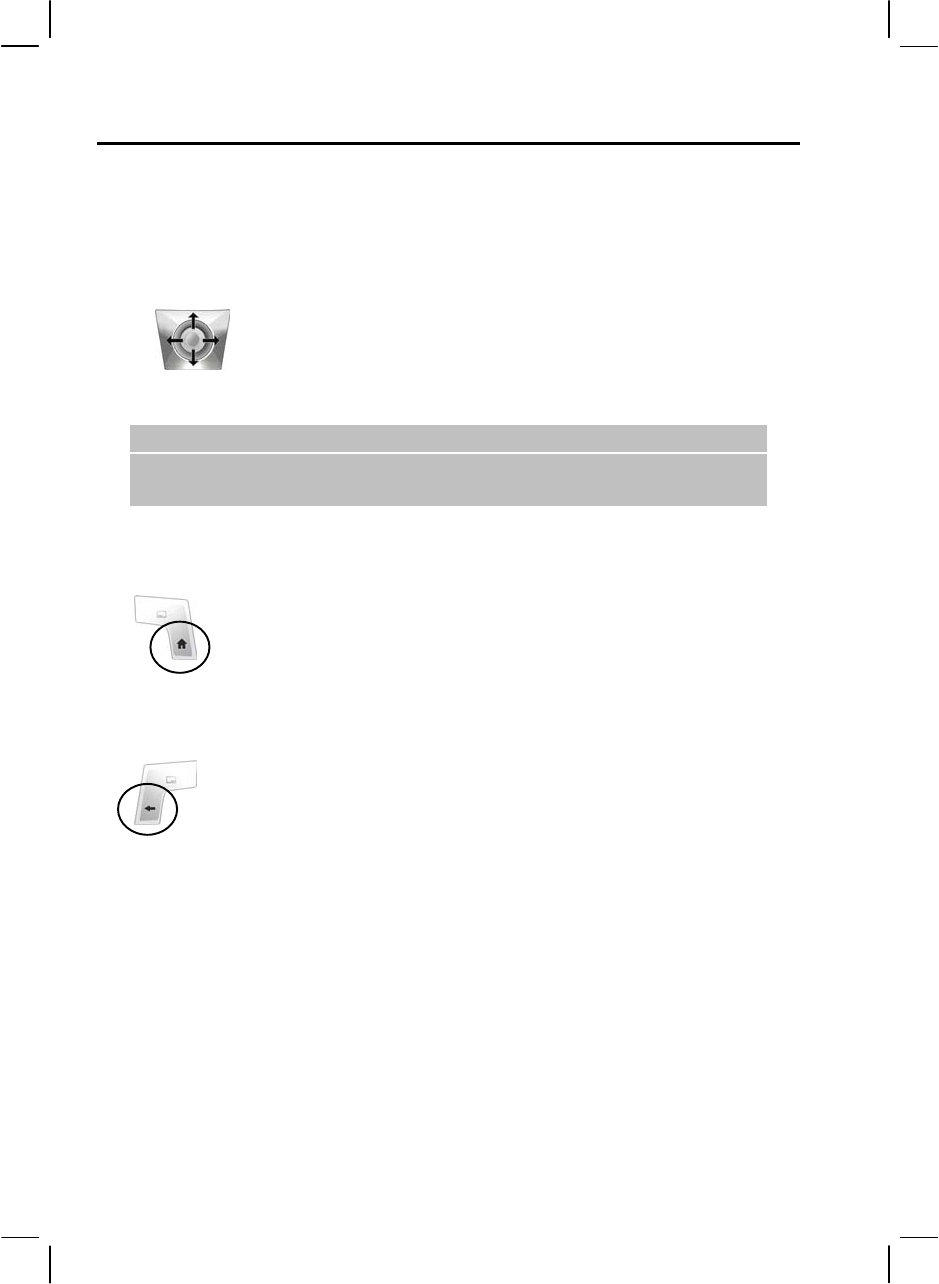
16
2.1 Navigation Methods
Your Smartphone has various keys that allow you to move around and select. This is
particularly useful for one-hand operation.
Navigation Stick
The four-directional navigation stick allows you to:
Scroll to an item or move the cursor on the screen by pushing
the stick toward the corresponding direction.
Confirm your selection by pressing in the stick.
|NOTE}
In the procedures in this document, “select” means scrolling to an item and
pressing the Navigation stick.
Home Key
The Home key takes you to the Home screen, the main screen of your
Smartphone.
Back Key
The Back key navigates to the previous screen.
When you are typing text, the Back key moves the cursor back to delete the
character in a text field. Pressing and holding the Back key deletes multiple
characters.
Up
Right
Lef
t
Down
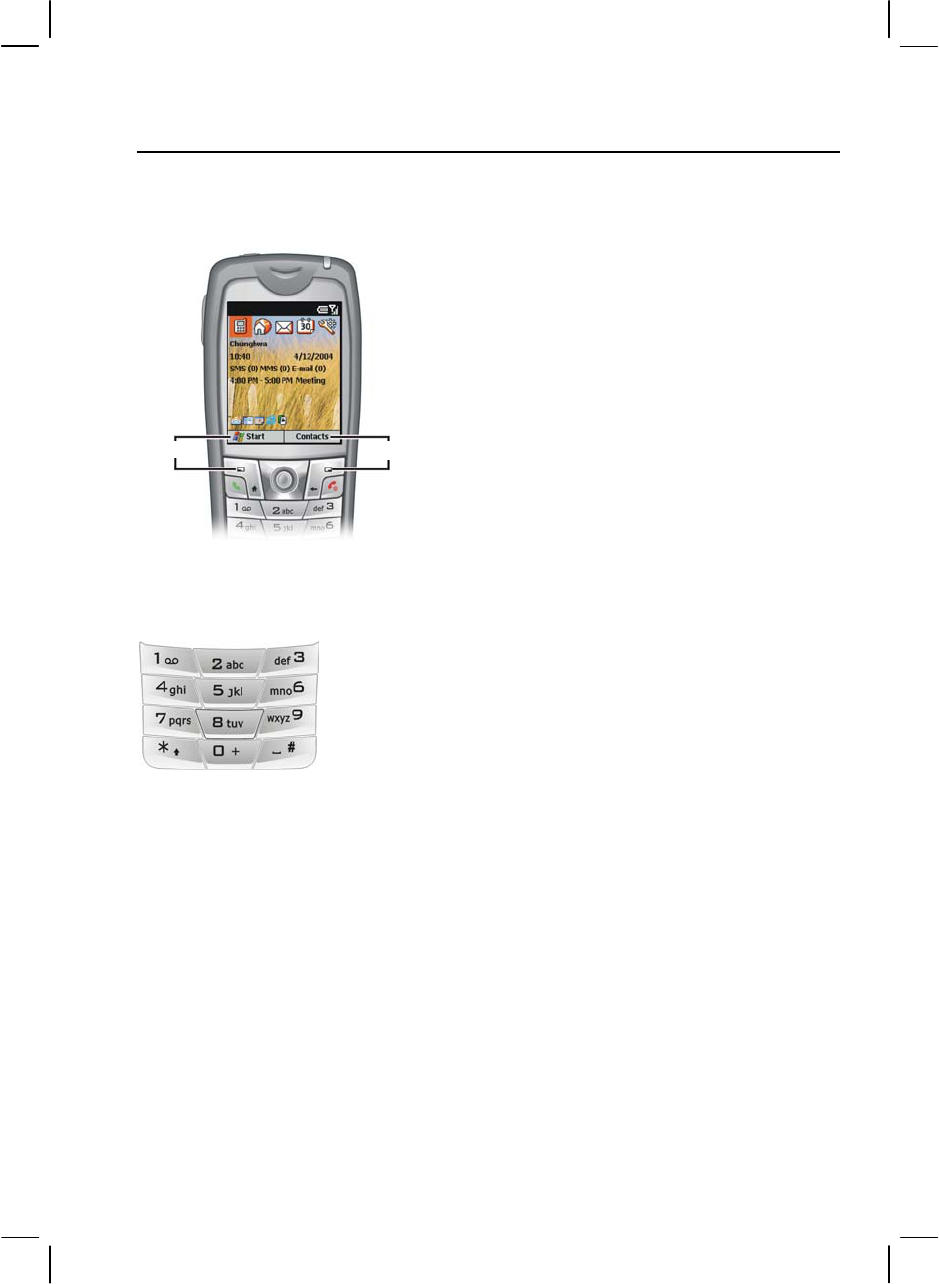
17
Soft Keys
There are two soft keys on the two sides of your
Smartphone, located directly below the display screen.
Pressing a soft key performs the command displayed
immediately above it on the screen. Soft key commands
may change from one screen to the next.
Numeric Keypad
You can use numbers to navigate quickly to programs and settings
on your Smartphone. Just press the number on the keypad that
corresponds to the number shown next to the program or setting you
want.
Though commands in a menu are normally not labeled with
numbers, you can still use numbers to select menu commands by
pressing the number that corresponds to the menu commands in
top-down order.
Right soft keyLeft soft key
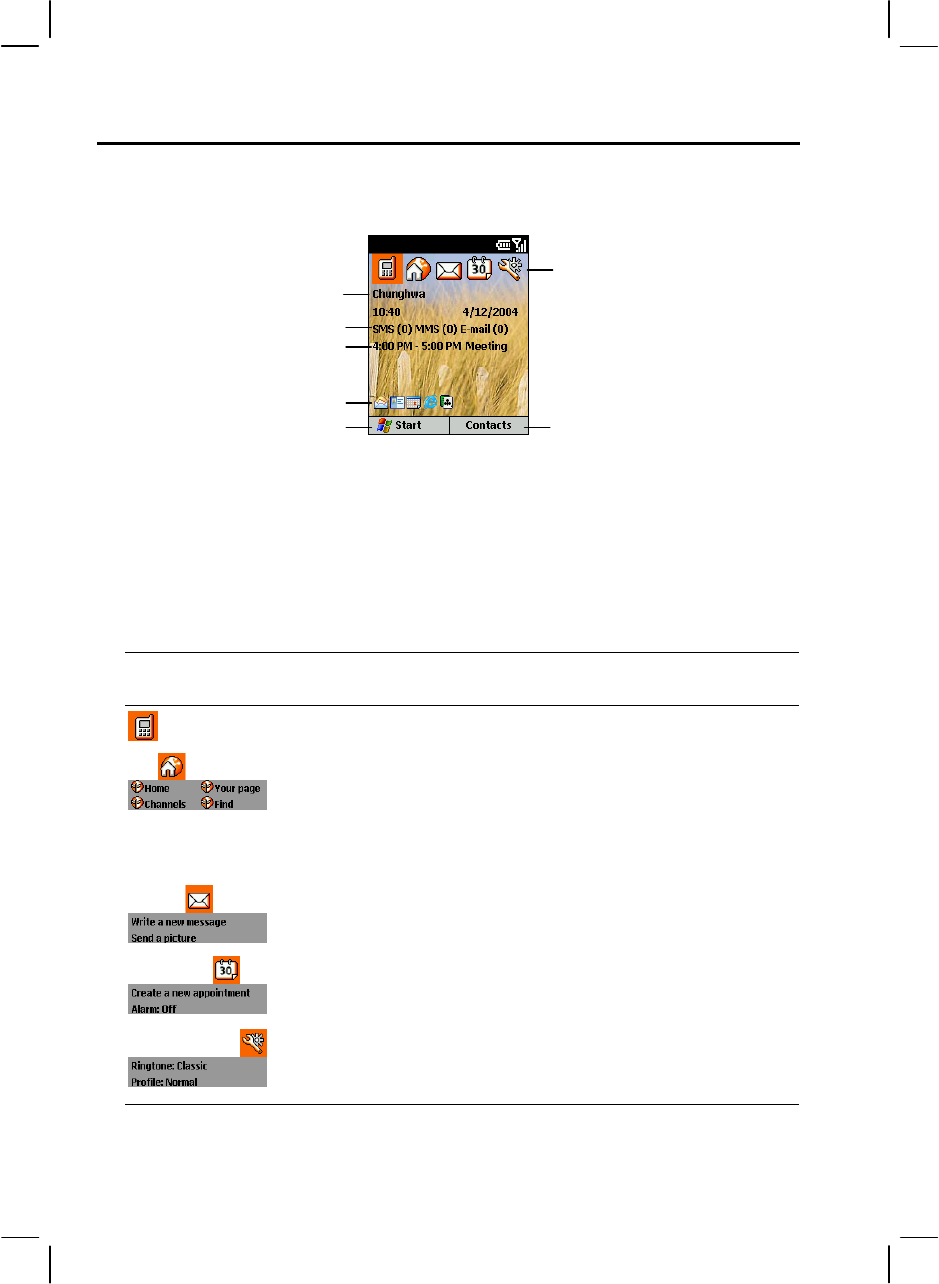
18
2.2 Home Screen and Screen Elements
Home Screen
The Home screen is your starting place for most tasks. The screen automatically displays
when you turn your Smartphone on. You can also navigate to the Home screen at any time by
pressing the Home key.
The top of the Home screen provides five preset shortcuts. You can select a shortcut icon with
the Navigation stick. Four of the icons have a pull down menu where you can scroll down and
press the Navigation stick to quickly access the associated program.
The shortcuts are:
Icon and Menu Associated
Program
Function
Call History To access Call History. (See section 3.5.)
Internet
Explorer
To connect to:
Home - ?
Your page - ?
Channels - ?
Find - ?
Messaging To write a new message. (See section 5.4.)
Phone Camera To take a photo or video. (See Chapter 9.)
Calendar To create a new appointment. (See section 6.1.)
Settings To set the alarm. (See “Date and Time” in section 4.1.)
Settings To select a ringtone. (See “Sounds” in section 4.1.)
Settings To change your profile settings. (See “Profiles” in
section 4.1.)
Select a shortcut to quickly
access the program.
Your current service provide
r
Right soft key command
Number of unread messages
Left soft key command
Recently-used programs
Next appointment
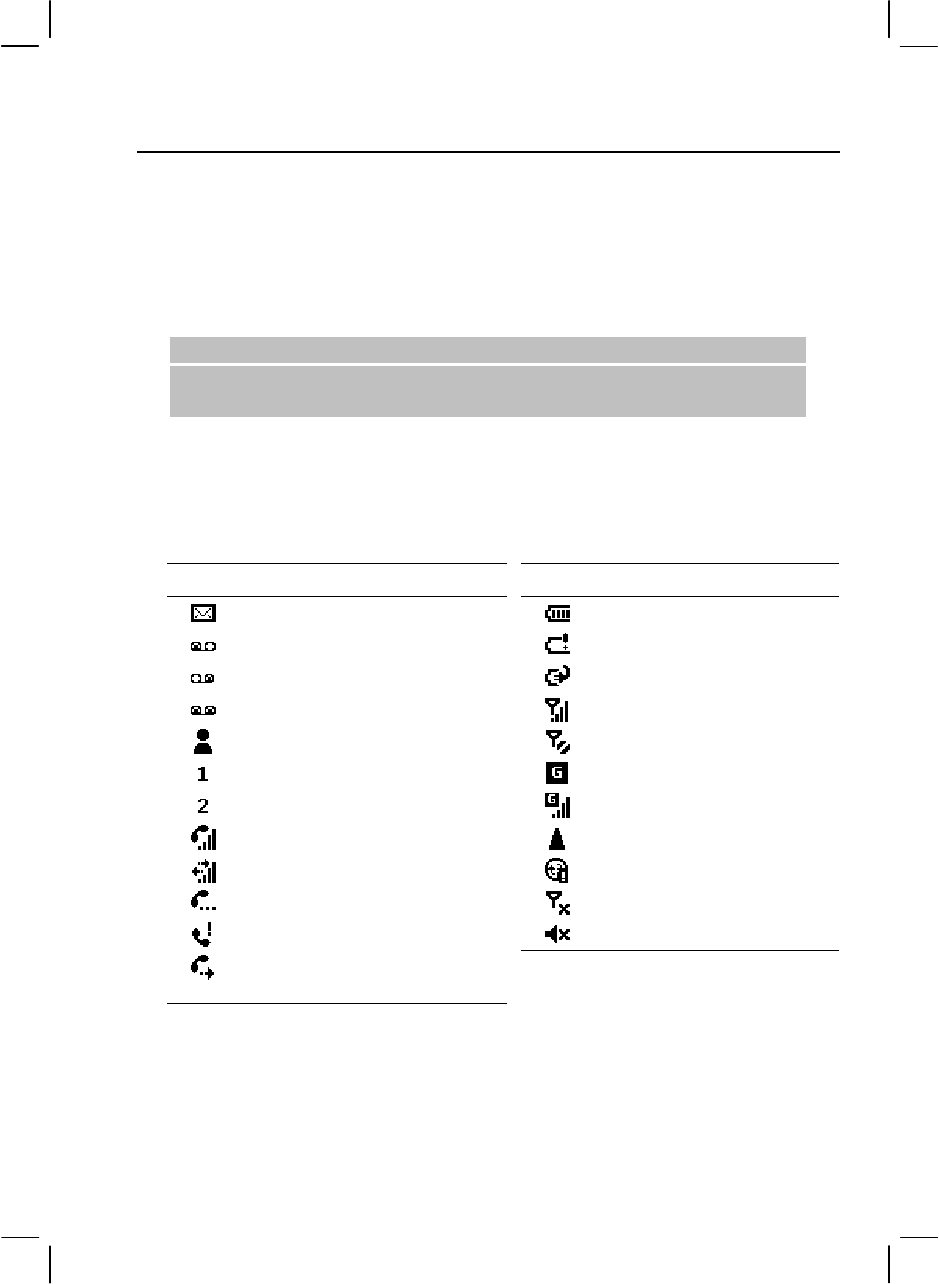
19
The center of the screen provides reminder information such as the upcoming appointment,
number of unread messages, number of missed calls, and others, if available. You can scroll
down to the information area and press the Navigation stick to view or edit detailed
information.
At the bottom left corner of the Home screen are five recently-used programs. You can scroll
to select an icon and open the program.
|NOTE}
Each time you turn on your Smarphone, the five recently-used programs
change back to default settings.
Status Indicators
Status indicators appear at the top of the Smartphone screen. The following table lists
common status indicators and their meanings.
Indicator Meaning Indicato
r
Meaning
New e-mail or text message (SMS) Battery level
New voice mail on line 1 Low battery
New voice mail on line 2 Battery charging
New voice mail on lines 1 and 2 Signal strength
New instant message No signal
Line 1 GPRS available
Line 2 GPRS in use
Voice call in progress Roaming
Data call in progress Sync error
Call on hold Radio off
Missed call Ringer off
Incoming voice calls are being
forwarded to another number
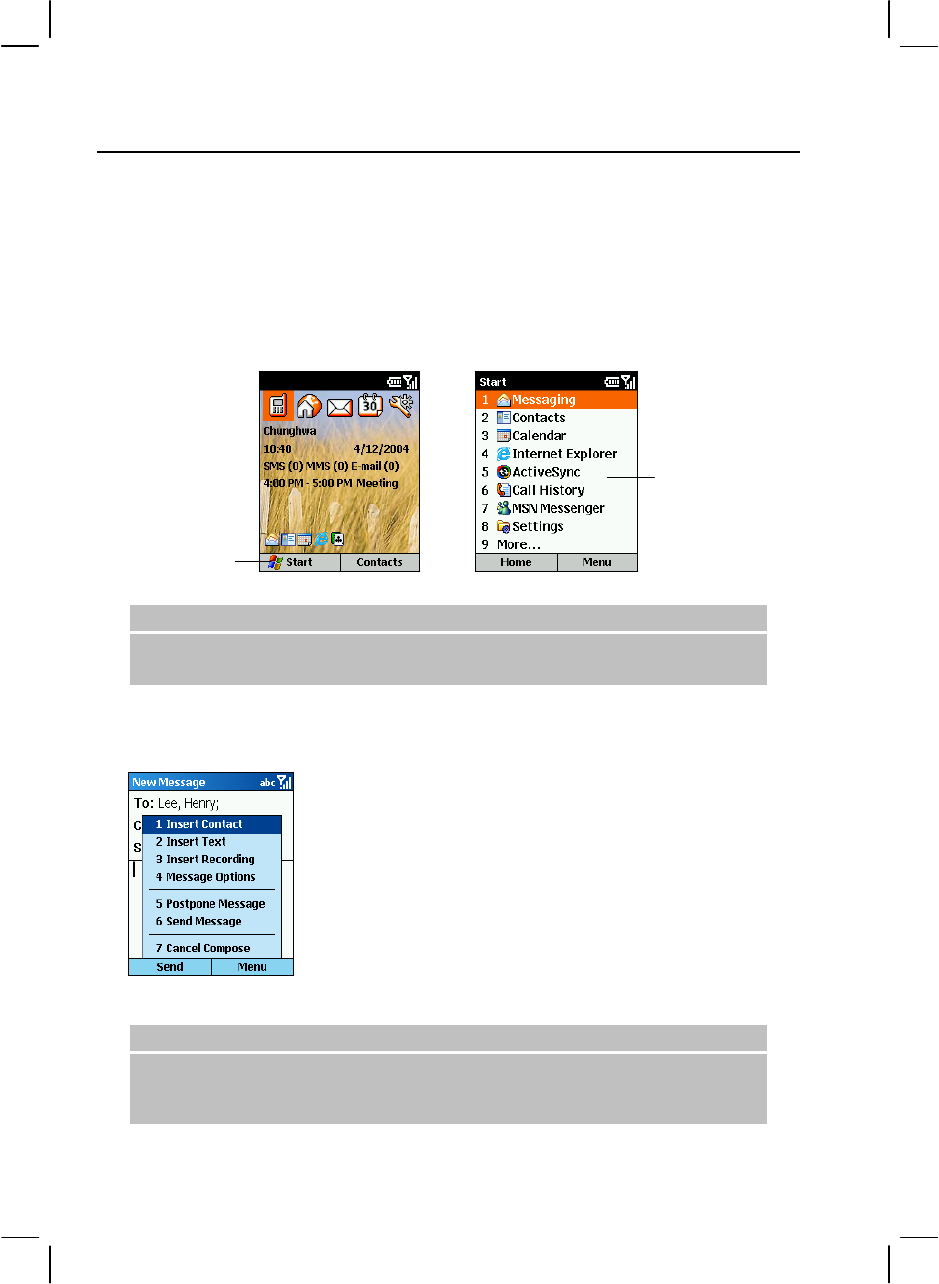
20
Start List
Smartphone includes many pre-installed programs that you can open and start using right
away.
On the Home screen, press the Start soft key. Select a program by scrolling to it and pressing
the Navigation stick. The More option in the list indicates that you can select More to access
the next page of the list.
|NOTE}
If your SIM card supports the STK (SIM Tool Kit) function, you can also run the
program(s) in the SIM card.
Menus
On many screens, the right soft key is the Menu soft key. Pressing
Menu displays a list of commands for the current screen.
Depending on the menu, selecting a command has one of the
following results:
Performs the command
Takes you to another screen where you can perform the
command
Displays another menu
Opens a program
|NOTE}
You can choose menu commands quickly by pressing the number on the
keypad that corresponds to the number shown next to the command you want;
for example, in Start, press 3 to open Calendar.
Press to access
the Start menu.
Press the number key
to open a program, or
select More to go to
the next page.
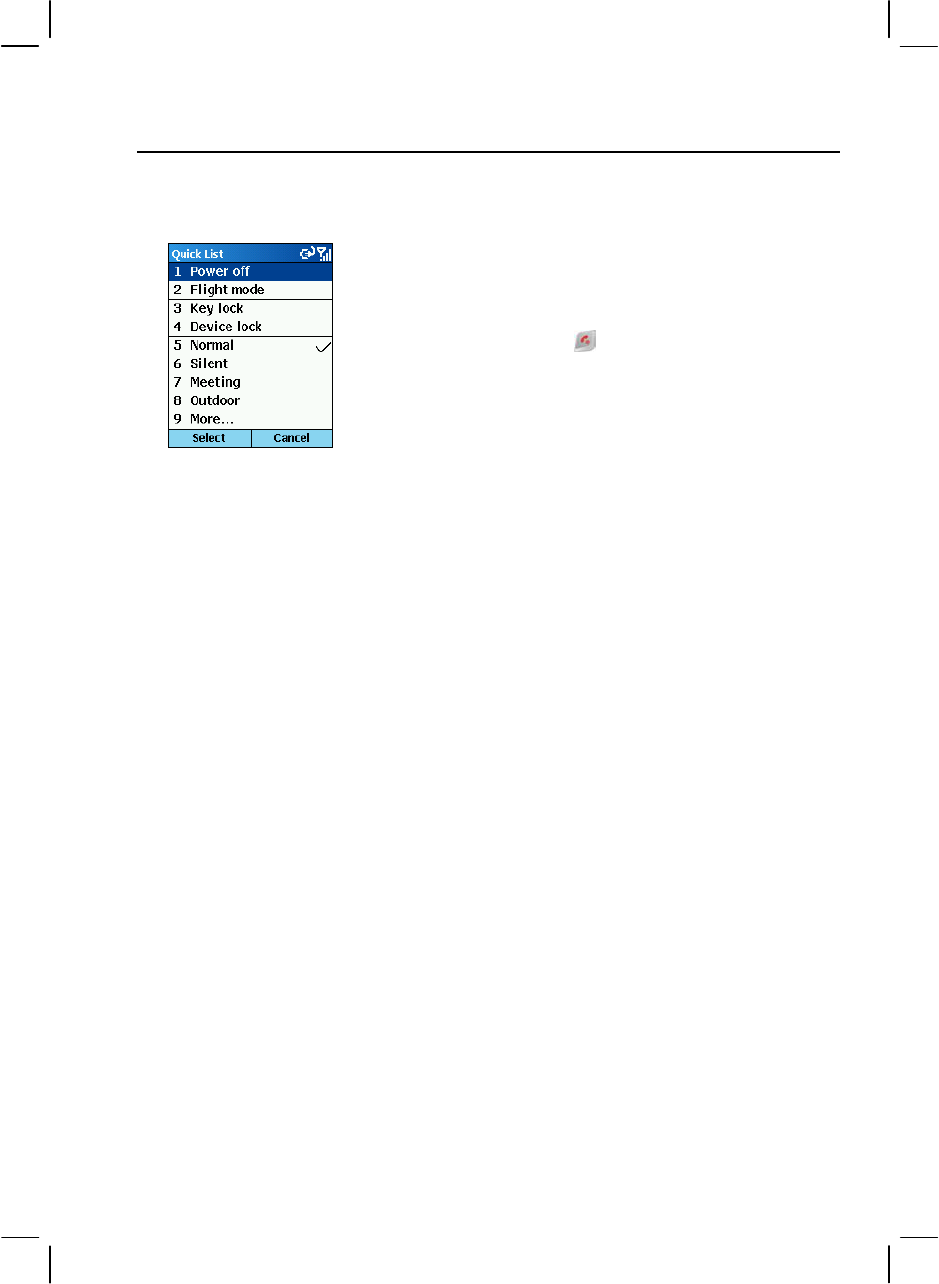
21
Quick List
The Quick List provides a list of commands that you can use to
quickly perform common actions, such as turning off the
Smartphone, locking the Smartphone, turning off the phone
capability, and changing the profile type.
Press and hold the End key until the Quick List appears.
Then, press the number to perform the command; or, scroll to an
option and the press the Navigation stick or Select soft key.
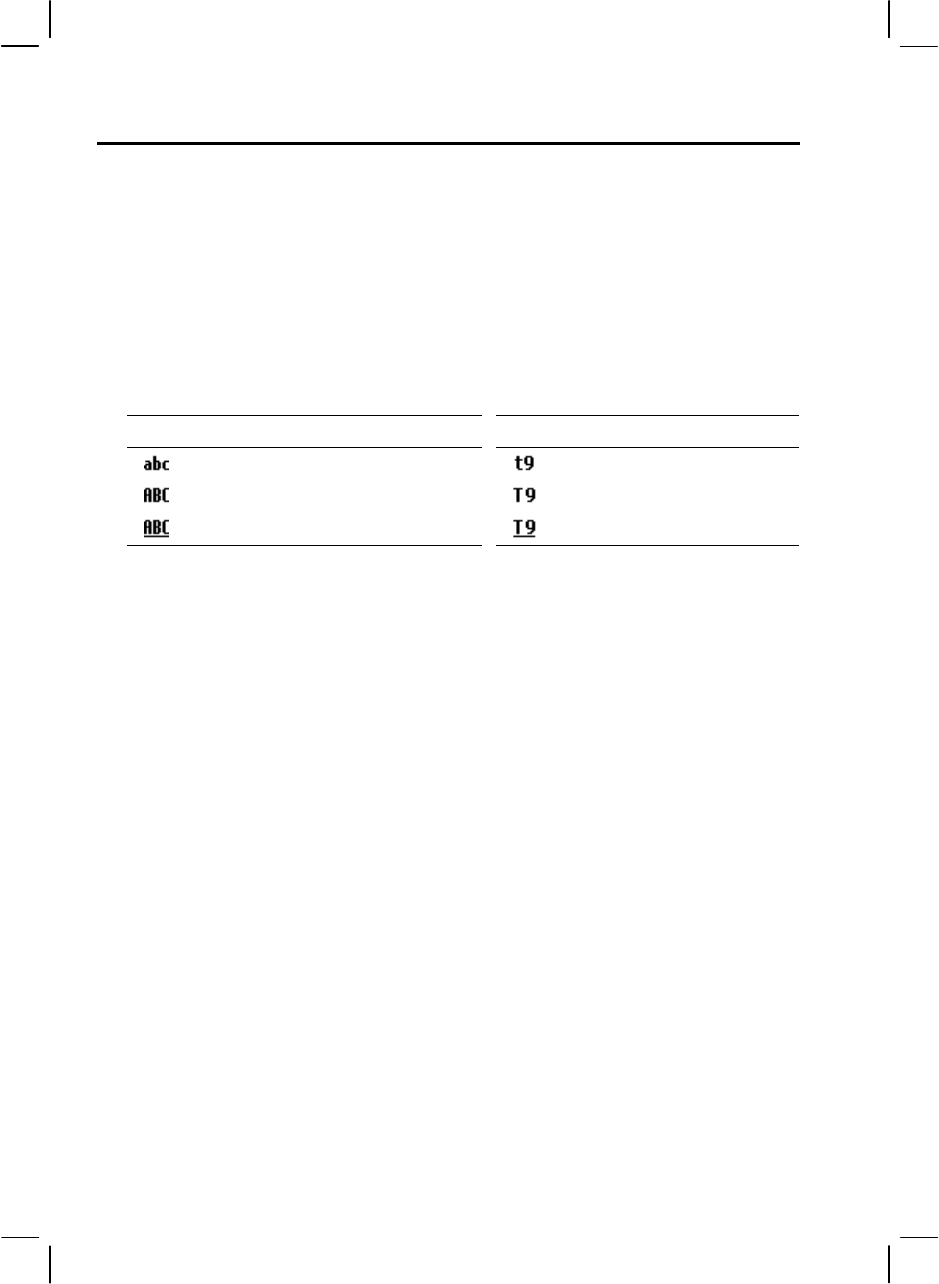
22
2.3 Entering Text and Numbers
You can enter text and numbers on your Smartphone using the keypad. You Smartphone
supports three input modes for enter text and numbers: Multipress, T9 and Numeric. The
Multipress and T9 modes are used for entering text and the Numeric mode is used for entering
numbers.
When you select a field that requires text or numeric entry, your Smartphone will
automatically default to the appropriate input mode. The status icon on the top-right corner of
the screen shows the input mode you are currently using. To change the input modes, press
and hold the Asterisk key (*) and select the input mode you want from the pop-up menu. The
status icon for the input mode you want is shown on the screen.
The following table shows the complete list of input mode status icons.
Icon Input mode Icon Input mode
Multipress text input mode, lowercase T9 text input mode, lowercase
Multipress text input mode, uppercase T9 text input mode, uppercase
Multipress text input mode, caps lock T9 text input mode, caps lock
Entering Text in Multipress Mode
To enter a letter in Multipress mode, press the number key on which the letter appears. To
enter the first letter on the number key, press the key once. To enter the second letter, press the
key twice, and so on.
For example:
To enter the letter “s,” press 7777.
To enter the word “hat,” press 44, 2, 8.
The letter entered most recently is underlined until you have completed the keypresses for the
letter and moved on to the next letter. When you enter letters that are on the same number key,
you must pause after entering the first letter and wait until the underline disappears before
entering the next letter so that the first letter can be processed. For example:
To enter the word “cat,” press 222, pause, press 2, pause, and press 8.
The pause between keypresses is called the Multipress time out, and you can adjust the length
of the pause. (You can adjust the Multipress time out. See “Accessibility” in section 4.2.)
Entering Text in T9 Mode
To form a word in T9 mode, press the number keys that contain the letters you want. As you
enter letters, T9 analyzes your keypresses and attempts to complete the word.
For example:
To enter the word “shoe,” press 7, 4, 6, 3.

23
The following steps provide detailed instructions on using T9 input mode:
1. Press and hold the Asterisk key (*), and select English from the pop-up menu. The T9
indicator appears at the top of the display.
2. Enter letters by pressing the keys on which the letters appear. Press a key only once for
each letter.
3. Press the Pound key (#) to accept the word and enter a space after it, or push the
Navigation up/down to scroll through the available words.
4. If you do not see the correct word, erase the word. Then press and hold the Asterisk key
(*), select ABC from the pop-up menu to change to Multipress mode, and manually enter
the word.
|NOTE}
T9 cannot always find the word you want in the T9 dictionary; in these cases,
change to Multipress mode. After you have entered the word in Multipress
mode, the word will be added to the T9 dictionary.
End User is granted no rights of ownership or any other proprietary rights in or
to the Documentation and Tegic Product or any other software or technology of
Tegic. End User acknowledges that all ownership of and proprietary rights in
and to the Documentation and Tegic Product are vested in Tegic. End User
shall not modify, reverse engineer, decompile or disassemble the Tegic
Product, or otherwise attempt to obtain source code for the Tegic Product. The
Documentation and Tegic Product are protected by the copyright laws of the
United States and international copyright treaties.
Entering Numbers in Numeric Mode
You can enter numbers by using Numeric mode. If you need to enter a number within a line of
text, you can change to Numeric mode ( ) by pressing and holding the Asterisk key (*),
and then selecting 123 from the pop-up menu to enter the number, and then change back to
Multipress or T9 mode to finish entering the text.
|NOTE}
If a field permits a numeric entry only, such as the Work phone field in
Contacts, the input mode automatically defaults to Numeric mode.

24
Entering Symbols
Press and hold the Pound key (#), and select a symbol. Or, press and hold the Asterisk key (*),
select Symbols from the pop-up menu, and select a symbol.
Miscellaneous Input Tasks
To… Do this…
Enter a space In Multipress or T9 mode, press the Pound key (#).
Start a new line Press the Navigation stick.
Change between uppercase and
lowercase
Press the Asterisk key (*). When you are in text
mode, the first letter of a sentence is automatically
capitalized.
Lock caps Press the Asterisk key (*) twice to lock caps. Press
the Asterisk key (*) again to return to lowercase.
Enter a number, an asterisk (*), or
a pound sign (#)
Change to Numeric mode, and press the
corresponding key on the keypad.
Delete characters Press the Back key to backspace over a single
character. Or press and hold the Back key to
backspace and delete an entire text field.
Enter the plus sign (+) for
international calls
Press and hold the Pound key (#), and select the plus
sign.
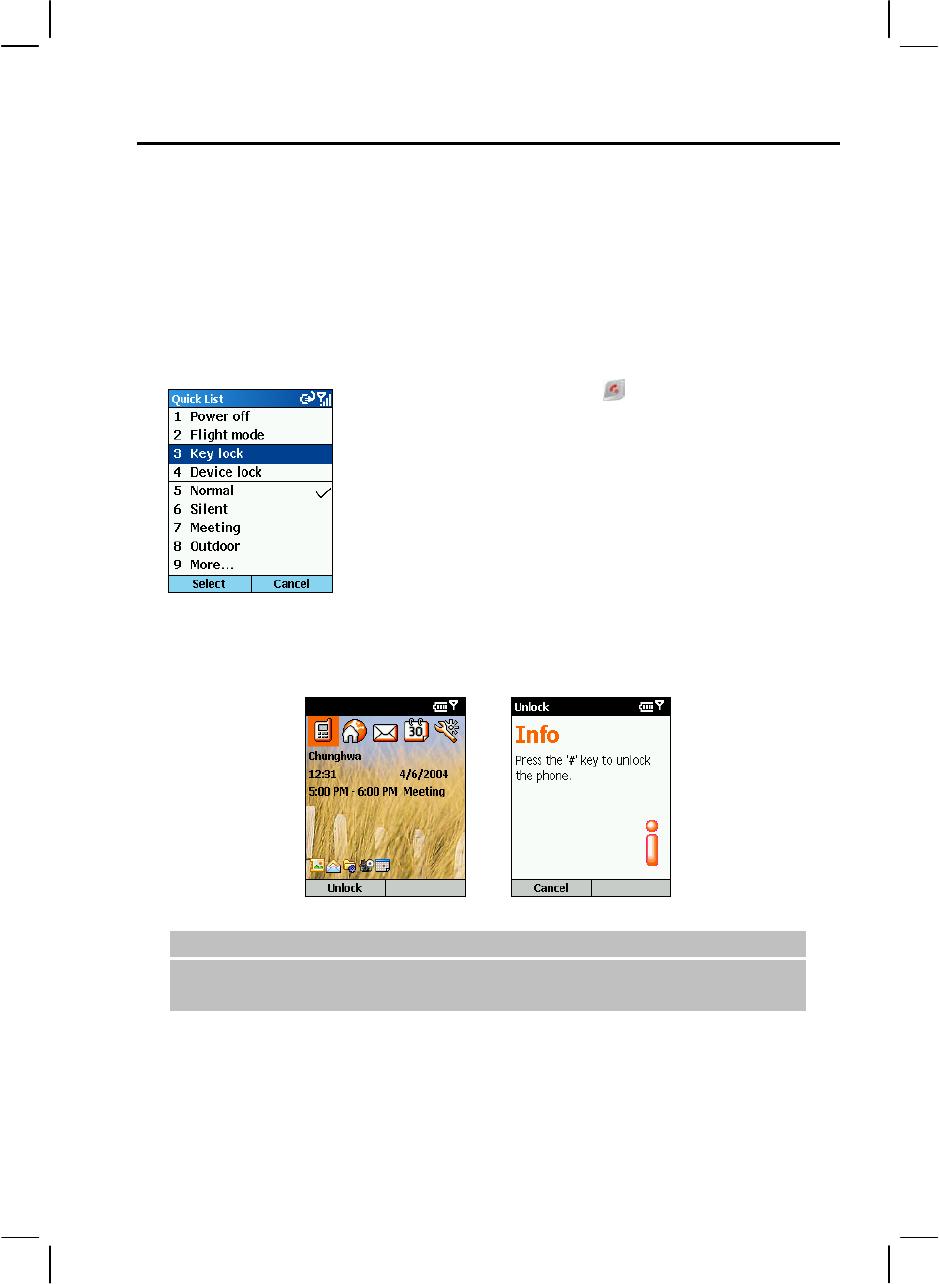
25
2.4 Securing the Smartphone
You can customize the level of security you want to have on the Smartphone by locking the
keypad, the entire Smartphone, or the SIM card.
Locking the Keypad
The keypad lock turns off the keypad functionality. This is a helpful feature if, for example,
the Smartphone is turned on and in your pocket, and you want to prevent accidental
keypresses.
To lock the keypad:
1. Press and hold the End key until the Quick List appears.
2. Press the number 3 or scroll to Key lock in the list and press
the Navigation stick or Select soft key. The left soft key will
display Unlock, indicating that the keypad is locked.
To unlock the keypad:
On the Home screen, press the Unlock soft key, and press the Pound key (#).
|NOTE}
You can still receive calls and make emergency calls when the keypad is
locked.
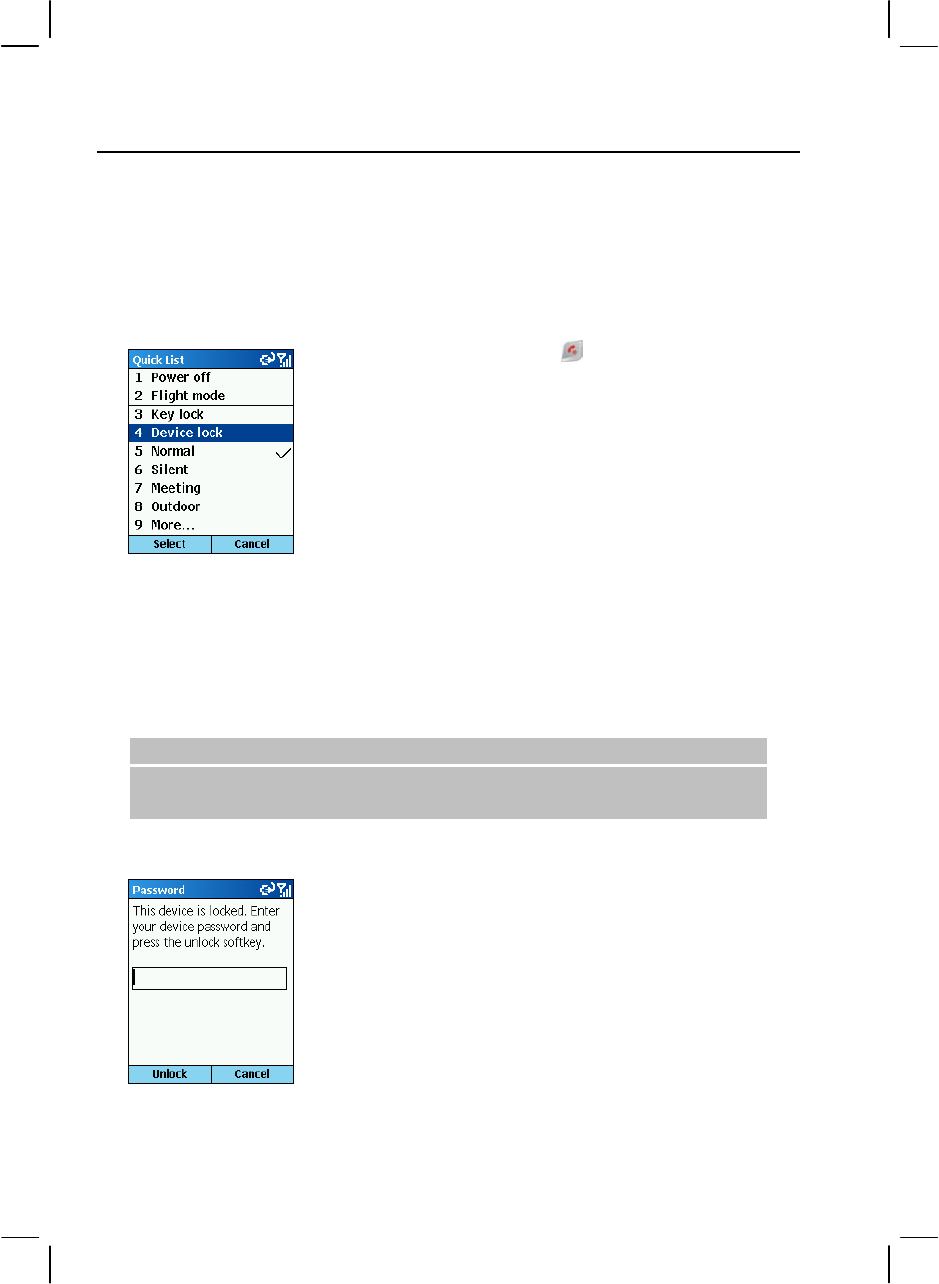
26
Locking the Smartphone
Locking your Smartphone prevents access to personal data. When you enable this feature, the
Smartphone will automatically lock after a specified time of inactivity. A screen will be
displayed requiring your Smartphone lock password before access is granted.
To turn on device lock:
1. Press and hold the End key until the Quick List appears.
Press the number 4 or scroll to Device lock in the list and
press the Navigation stick or Select soft key.
2. Under Lock phone after, push the Navigation stick left/right
to select the amount of time the Smartphone is inactive before
the Smartphone automatically locks.
3. Scroll to Password. Enter the password you want to use to
access the Smartphone when it is locked. Then, scroll to
Confirm password and enter the password again.
4. Press the Done soft key to save your settings.
To lock the Smartphone:
After you turn on device lock, your Smartphone will automatically lock after a specified time
of inactivity. You can also directly lock your Smartphone by selecting Device lock from the
Quick List. The left soft key on the screen will display Unlock to indicate that your
Smartphone is locked.
|NOTE}
You can still receive calls and make emergency calls when the Smartphone is
locked.
To unlock the Smartphone:
When the Smartphone is locked, press the Unlock soft key, enter
your password, and then press the Unlock soft key again.

27
To turn off the device lock:
1. On the Home screen, press the Start soft key, select Settings Security.
2. Select Disable phone lock.
3. Enter the password.
4. Press the Done soft key. The time and password you have set will be cleared.
Locking the SIM Card
Locking the SIM card prevents you and others from using the Smartphone that contains the
SIM card until the correct password is entered. To turn on the phone, you have to enter the
PIN.
To lock the SIM card and set the PIN:
1. On the Home screen, press the Start soft key, select Settings Security.
2. Select Enable SIM Lock.
3. Enter the password (SIM card’s PIN1), and press Done soft key.
Once the PIN is enabled, your Smartphone will ask you to enter the PIN whenever you turn it
on.
To unlock the SIM card:
1. On the Home screen, press the Start soft key, select Settings Security.
2. Select Disable SIM Lock.
3. Enter the password (SIM card’s PIN1), and press the Done soft key.
To change the PIN:
1. On the Home screen, press the Start soft key, select Settings Security.
2. Select Change SIM Lock.
3. Enter the original PIN1 code. Scroll to the next field by pushing the Navigation stick
down and enter a new password. Then, push the Navigation stick down and enter the new
password again.
4. Press the Done soft key.
|NOTE}
You can still receive calls and make emergency calls when the SIM card is
locked.

29
3 Using the Phone
This chapter explains how to make and receive phone calls, track your calls, and manage your
calls and phone numbers more efficiently.
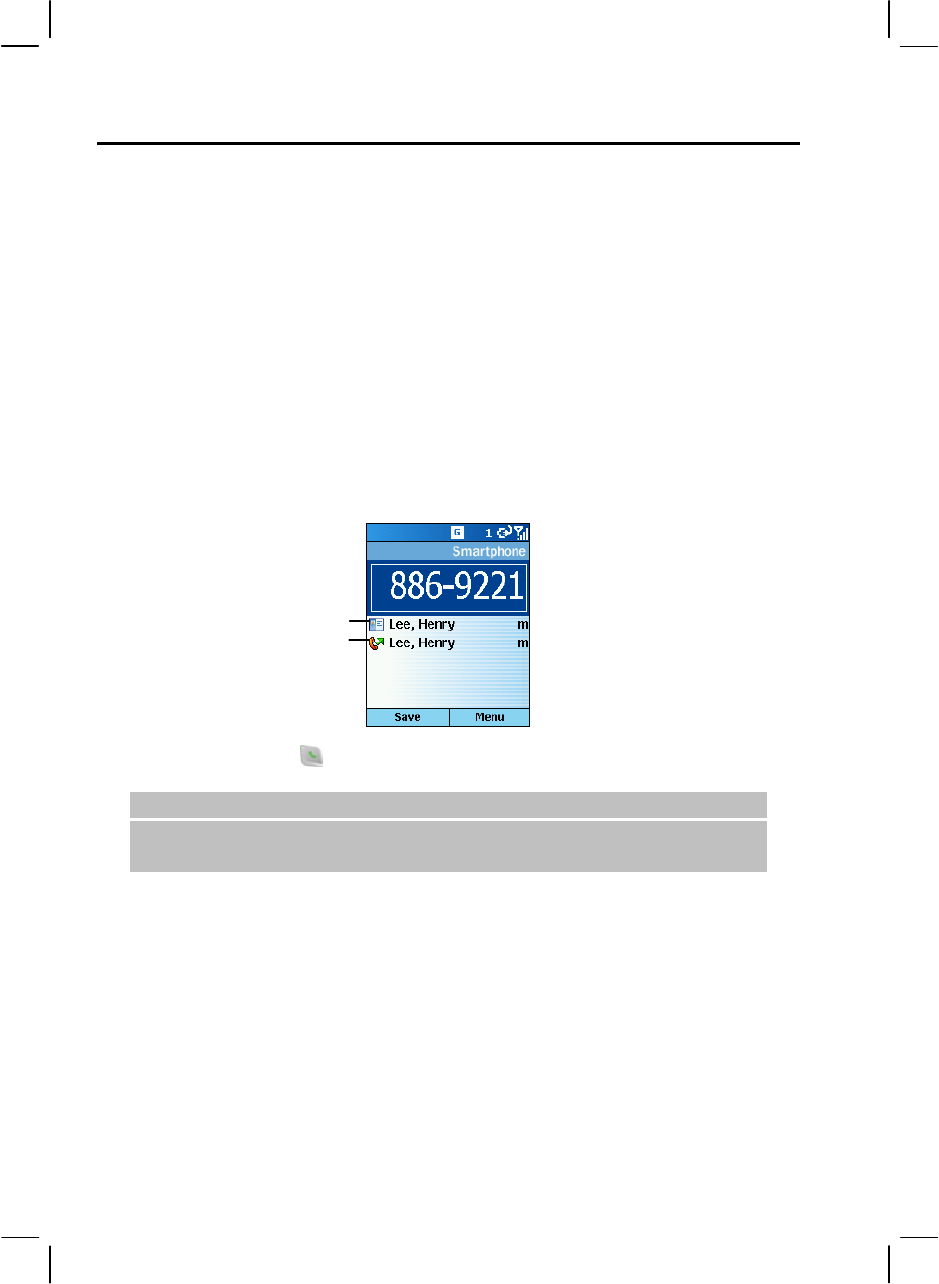
30
3.1 Making a Call
There are several ways to make a call. You can make a call from the Home screen by directly
pressing the numbers. You can also make a call using the numbers existing in your
Smartphone such as the numbers you have saved, the calls you dialed or received recently,
etc.
Making a Call from the Home Screen
On the Home screen, you can call someone by entering a phone number or a contact name
using the keypad. As you begin pressing keys, your Smartphone displays the names of any
contacts whose name or phone number match your entry. These could be contacts stored in
your Call History or Speed Dial list, or on your SIM card. You can then select the name or
number to call without having to enter the entire name or number.
1. On the Home screen, begin entering phone number or contact name.
2. If you see the number or contact name to call, scroll down to select it. If it’s a new number
you are calling, finish entering the number.
3. Press the Talk key .
|NOTE}
When you enter and select a contact name, the default phone number is used
if there is more than one phone number for the contact.
AutoFilter matches
number to a contact.
AutoFilter matches
number from Call History.
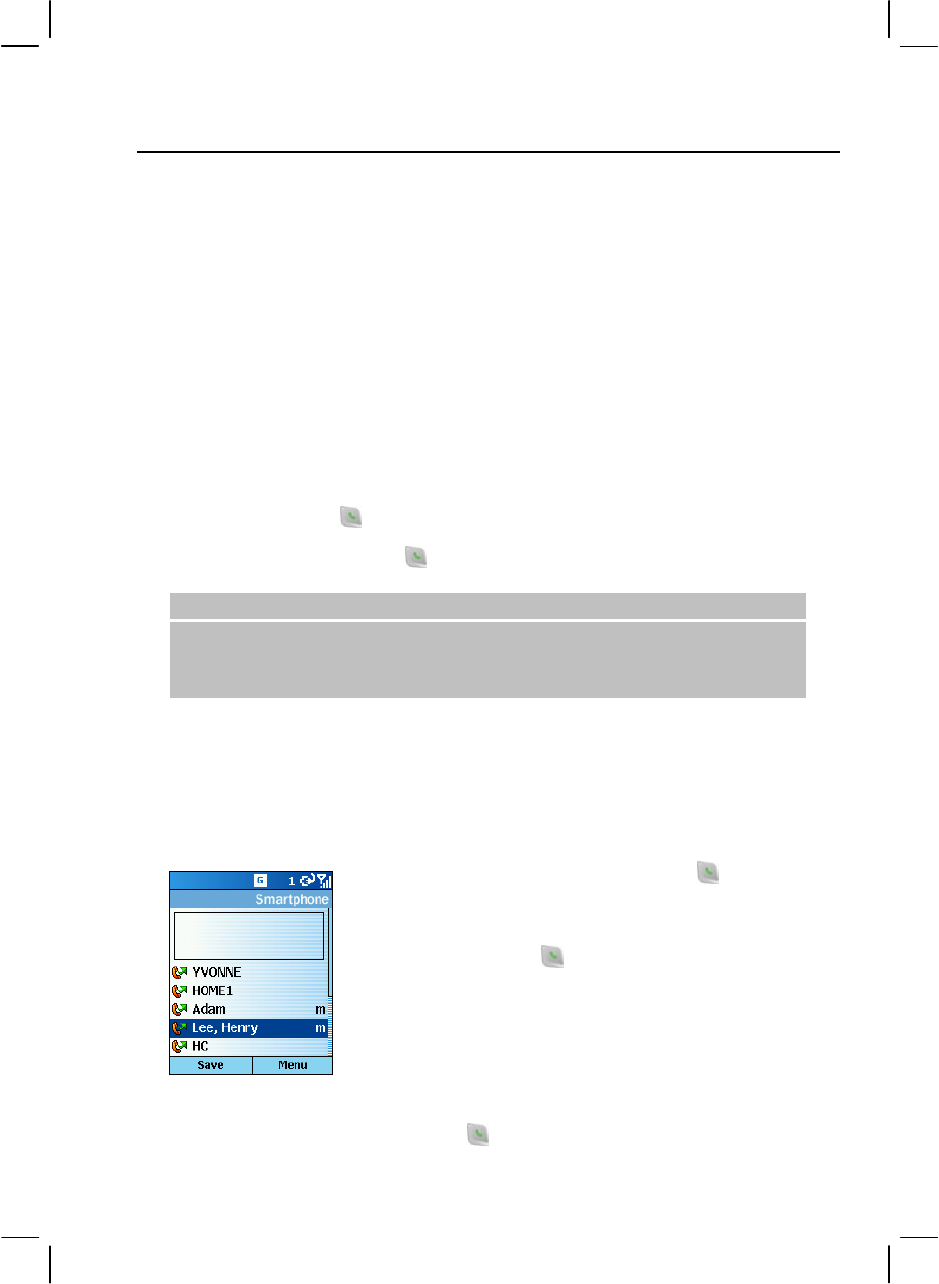
31
Making a Call from Contacts
Contacts is a Microsoft program for storing your contacts information in the Smartphone’s
memory.
You can quickly make a phone call from your contact list or from an open contact. When you
make a call from your contact list, the Smartphone dials the contact’s default number. You
can change the default number at any time so that the Smartphone dials a different number,
such as the Home or Mobile number. When you make a call from an open contact, you can
select the number to dial.
1. On the Home screen, press the Start soft key, and select Contacts.
2. Scroll to the contact. If you have a long list of contacts, you can enter the first few letters
of the contact’s name, and the Smartphone will search through the entire contact list and
display the name.
3. Press the Talk key to dial the default number of the selected contact. If you are not
dialing the default number, change the number by pushing the Navigation stick left/right,
and then press the Talk key .
|NOTE}
When a contact is selected, you can press the Navigation stick to open the
Contacts card and select a number from there.
For detailed information on the Contacts program, see section 6.1.
Making a Call Using a Recently Dialed Number
You can select a name or number from the list of recently dialed phone numbers to call that
person again. You can also quickly redial the last number called.
To make a call using a recently dialed number:
1. On the Home screen, press the Talk key to display a list
of recently dialed phone numbers.
2. Scroll to the name or phone number to call.
3. Press the Talk key .
To dial the last number called:
On the Home screen, press the Talk key twice.
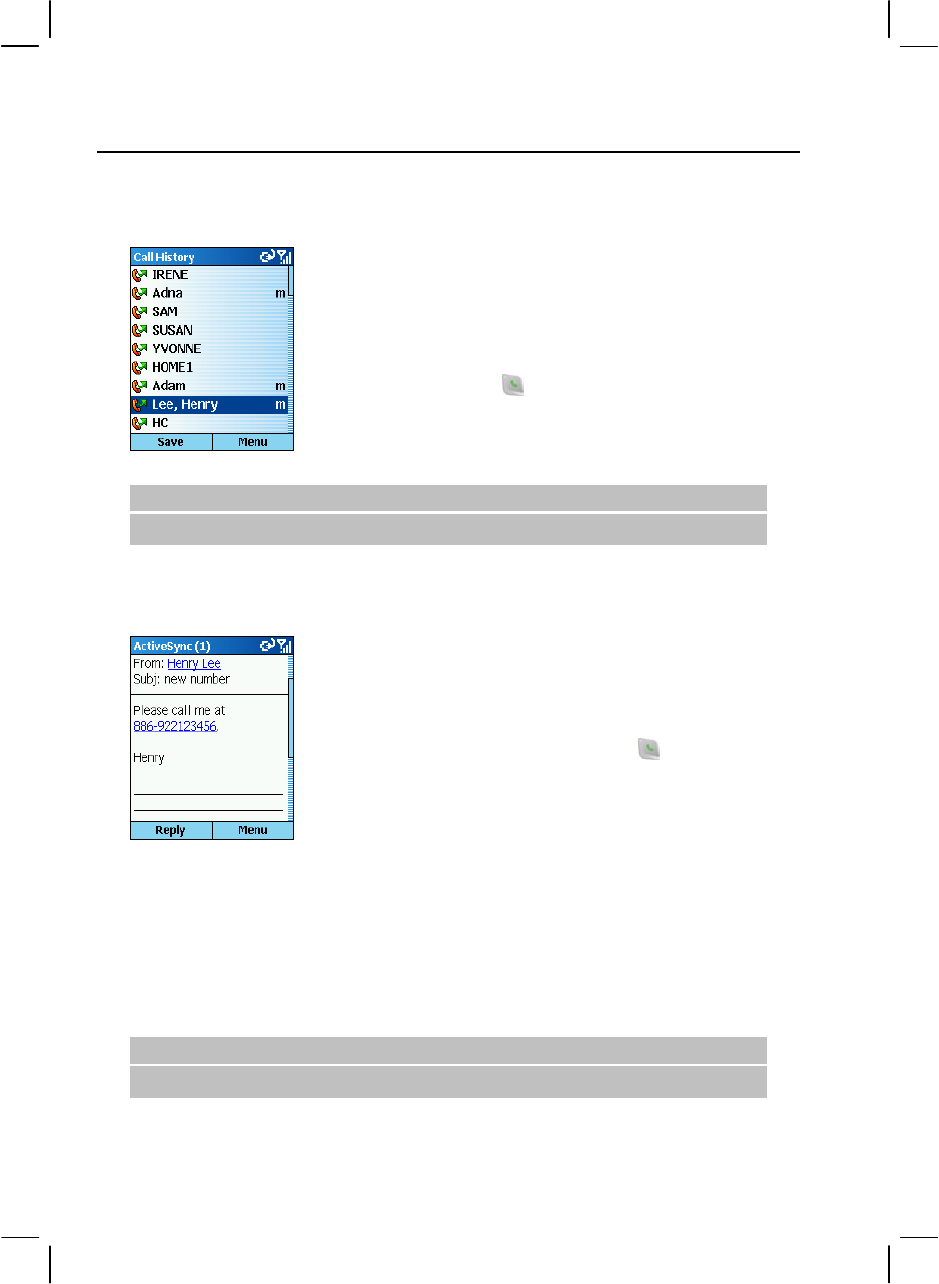
32
Making a Call from the Call History List
The Call History list displays calls you made, received, and
missed. You can make a call from this list.
1. On the Home screen, scroll to the top left corner to select the
Call History shortcut.
2. Scroll to the name or phone number to call.
3. Press the Talk key .
|NOTE}
For detailed information on Call History, see section 3.5.
Making a Call from a Hyperlink Phone Number
You can quickly dial a phone number from an e-mail or text
message that contains a hyperlink phone number. A hyperlink
phone number is underlined, in the same manner as a Web site
address.
From a message containing a hyperlink phone number, scroll to
the phone number and press the Talk key .
Making a Call from Speed Dial
Speed Dial enables you to quickly place a call without having to actually enter the number.
On the Home screen, press and hold the number on the keypad that you have assigned as a
speed dial for a number. If the keypad assignment is two digits, press the first digit and press
and hold the second digit.
|NOTE}
For information on assigning Speed Dial numbers, see section 3.6.

33
3.2 Responding to an Incoming Call
When you receive a call on your Smartphone, your Smartphone rings. The phone number of
the caller, if available, is displayed on the screen.
If the caller is included in your contact list, the contact name will be displayed. If the caller is
associated with an image (called “Photo ID”), the image will be displayed.
|NOTE}
There may be situations where you want to immediately silence the ring of an
incoming call. Simply press the Volume control, and then proceed to answer
the call.
You can customize the phone ring. (See “Sounds” in section 4.1.)
You can customize the photo and ring tone. (See section 11.1.)
Answering an Incoming Call
Press the Talk key or Accept soft key.
Rejecting an Incoming Call
Press the End key or Reject soft key.
Answer the call. Reject the call.
Depending on the settings, the
following caller information may appear:
- Photo ID
- Caller’s phone numbe
r
- Caller’s name
- Phone Type Indicato
r

34
3.3 Managing More than One Call
During a call, you can make or take a second call while putting the current call on hold. Then,
you can choose to swap between the two callers or set up a conference call between all three
parties.
|NOTE}
You may need to register for the “call waiting” service with your service
provider and set your Smartphone accordingly.
Holding a Call to Take a Second Call
If there is another incoming call when you are talking on the Smartphone, press the Talk key
or Accept soft key to place the first call on hold, and answer the second call.
To end the first call and answer the second call, press the End key , and then press the Talk
key or Accept soft key.
Rejecting the Second Call
Press the Reject soft key to reject the second call and keep your current call in progress.
Holding a Call to Make a Second Call
When you are talking on the Smartphone, you can press the Hold soft key to place the first
call on hold and dial a second call. When you have finished the second call, press the End key
to go back to the first call.
Swapping between Calls
When you have put a call on hold and made or taken another call as described earlier, you can
change between the calls by pressing the Swap soft key.
Setting up a Conference Call
When multiple calls are in progress, you can press the Menu soft key and select Conference
to set up a conference call.

35
3.4 In-call Options
Adjusting the Phone Volume
To adjust the volume during a call, simply press the Volume control on the side of your
Smartphone.
Speakerphone
To use the speakerphone function as a hands-free solution, press and hold the Talk key .
The other party’s voice will be magnified and sent out through the speaker. You can then talk
without having to hold the Smartphone against your cheek.
|NOTE}
When using the speakerphone function, always talk in turns. If you talk when
the other party is still talking, the other party cannot hear you clearly.
In-call Options
While a call is in progress, you can press the Menu soft key to access menu commands for
common tasks. The following table shows the commands available when a call is in progress.
Some of these commands are available only when multiple calls are in progress or during a
conference call.
In-call Options Function
End Disconnects the call.
Hold Puts the active call on hold.
Unhold Activates the call on hold.
Swap Switches between two calls.
Save to Contacts Creates a contact card for the caller.
Conference Joins together all existing calls, if you have subscribed to this
service.
Private Breaks one call out of a conference and make it active while the
rest of the conference is on hold.
Speakerphone Increases the volume of the earpiece.
Mute Mutes the microphone for the active call; the other party will not
hear anything you say, but you can still hear the other party.
Unmute Turns the microphone back on for the active call.
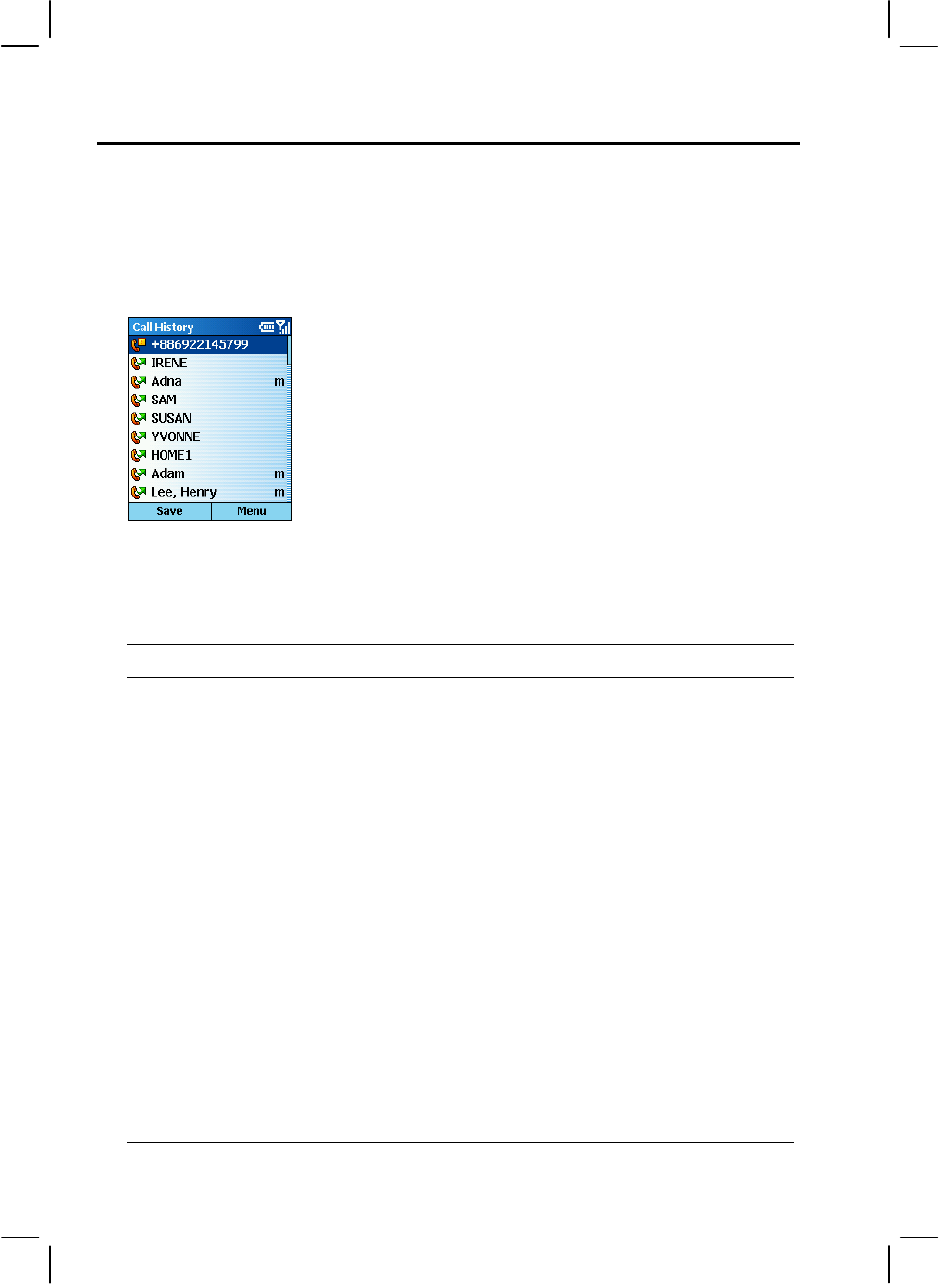
36
3.5 Call History
Call History displays calls that you have made, received, and missed. Each entry in Call
History contains the start time of the call, the duration, the caller’s name, if available, and the
caller’s number. The oldest calls are automatically deleted from the list to make room for the
newest calls.
Viewing Call History
On the Home screen, scroll to the top left corner to select the Call
History shortcut. Or, you can press the Start soft key and select
Call History.
Call History Menu Commands
In Call History, press the Menu soft key to access the command list.
Call History Menu Function
Find Contact Opens the contact card of the selected entry in Call History (if the
contact is already in the contact list).
E-mail Opens Messaging so you can send an e-mail message to the selected
entry in Call History (if the contact is already in the contact list and
contains an e-mail address).
View Timers Displays detailed information regarding the length of your last call, the
total number of calls made and received, calls by type, and a lifetime
counter. Call Timers is useful when you want to keep track of your
calling patterns, for example to determine what type of calling plan to
subscribe to and help you estimate your monthly billing.
Delete Deletes the selected entry in Call History.
Delete List Deletes all entries in Call History.
Save to Contacts Stores the selected entry to Contacts. When you select Save to
Contacts, the Select Contact screen appears. In the <New Item>
field, press the Navigation stick, scroll to the desired field, and press
the Insert soft key to paste the number to the field. Enter the
information in the other fields, and press the Done soft key.
Filter Allows you to separately view Missed Calls, Incoming Calls, or
Outgoing Calls.
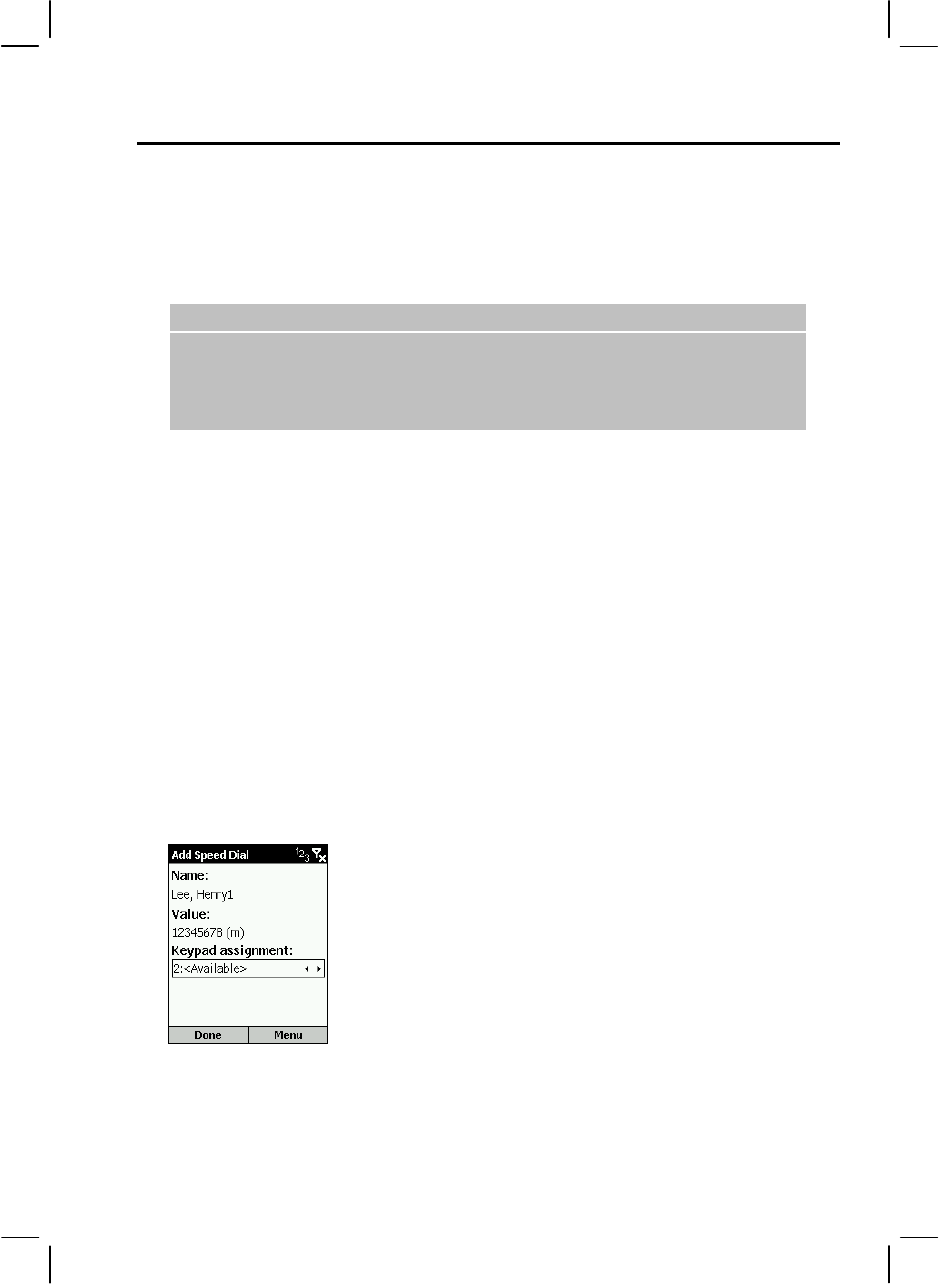
37
3.6 Speed Dial
You can create one- or two-digit speed dials. When you press a speed dial, Smartphone
automatically dials the associated phone number, opens an e-mail message using the
associated address, or goes to the associated Web page.
You can create speed dials from 2 to 99. Speed dial 1 is reserved for your voice-mail number,
and is automatically configured in your speed dial settings.
|NOTE}
You can create a speed dial only for a phone number, e-mail address, or Web
page address that is stored in Contacts. You cannot create a speed dial for a
contact stored in the SIM card.
For information on voice mail, see section 3.8.
Creating a Speed Dial
1. On the Home screen, press the Start soft key and select Contacts.
2. Select the desired contact and open the contact card to create a speed dial.
3. Select the phone number, Web page address or e-mail address to create a speed dial.
4. Press the Menu soft key, and select Add Speed Dial.
5. Under Keypad assignment, enter the speed dial number to use.
6. Press the Done soft key.
On the Home screen, press and hold the number on the keypad that you have assigned as a
speed dial for the phone number, e-mail address, or Web page. If the speed dial is two digits,
press the first digit, and press and hold the second digit.
Editing a Speed Dial
1. On the Home screen, press the Start soft key and select
Speed Dial.
2. Select an entry from the speed dial list.
3. Press the Edit soft key, or the Menu soft key then select Edit.
4. Go to Keypad assignment, and push the Navigation stick
left/right to select a new speed dial number to use.
5. Press the Done soft key.

38
Deleting a Speed Dial
1. On the Home screen, press the Start soft key and select Speed Dial.
2. Select an entry from the speed dial list.
3. Press the Menu soft key and select Delete.
|NOTE}
When you delete a contact that is stored in Contacts, the speed dial you have
set for this contact still exists in the speed dial list. You need to delete the
speed dial from Speed Dial as well.
Viewing the Speed Dial List
On the Home screen, press the Start soft key and select Speed Dial.
When you select an entry in the speed dial list, you can press the Go soft key ors use the Menu
commands to dial the selected number, open a new e-mail message, go to the Web page,
display the contact card, or delete an entry.
|NOTE}
To view speed dials only, press the Menu soft key and select Filter Speed
Dial.

39
3.7 Voice Mail
Voice Mail is a service provided by your service provider. To use this service, you have to
apply for it and obtain the phone number used for accessing the voice mail. You can call your
voice mailbox by using speed dial 1, which is reserved for your voice-mail number.
Setting up the Voice Mail Phone Number
1. On the Home screen, press the Start soft key and select Settings Phone.
2. Select Call Options.
3. Under Voice mail number, enter the number for voice mail. This number will be
automatically assigned Speed Dial 1.
Checking Your Voice Mail
On the Home screen, press and hold the number 1 to call the voice mail of your service
provider.

40
3.8 International Call
To enter an international country code:
To make an international call, you must include a country code at the beginning of the dialing
sequence for the phone number. The country code appears first, followed by a plus (+) sign,
and is separated from the rest of the number sequence. If you are making an international call,
press and hold the 0 key until the + sign appears. This operation also applies to Contacts and
manual dialing.
To insert a 3-second pause in a dialing sequence:
Some international calls require a three-second pause in the dialing sequence for the call to
process successfully.
When you are entering the phone number in Contacts, place the cursor where you want to
insert a three-second pause, press the Menu soft key, and select Insert Pause. The letter “p”
will appear in the number to show where the three-second pause will occur in the dialing
sequence.
To inserting a manually pause in a dialing sequence:
There may be phone numbers that require a pause longer than three seconds in the dialing
sequence. For these cases, you can pause as long as you want and manually continue the
dialing sequence using the Talk key.
When you are entering the phone number in Contacts, place the cursor where you want the
dialing sequence to pause before proceeding, press the Menu soft key, and select Insert
Wait. The letter “w” will appear in the number to show where the pause will occur in the
dialing sequence.
To resume dialing after reaching a manual pause, press the Talk key.

41
3.9 Turning off the Radio
Under some situations (on the airplane, for example), you will need to turn off the wireless
radio of your Smartphone. After turning off the radio, you cannot use the phone function of
your Smartphone, but you can still use other functions such as camera, Calendar, games,
Media Player, etc.
To turn off the radio:
1. Press and hold the End key until the Quick List appears.
2. Select Flight mode. The status icon changes to and the message “Flight Mode”
appears on the Home screen.
To turn on the radio:
1. Press and hold the End key until the Quick List appears.
2. Select Flight mode off.
|NOTE}
If you need to turn on the radio again after turning it off, please wait for 20
seconds before turning it on.
When you turn off the radio, it remains off when you next turn on your
Smartphone.

43
4 Setting up Your
Smartphone
You can customize the settings on your Smartphone for the way you work. For example, you
can change the sounds or use your own sounds for ring tones, use your own image for the
Home screen background, set up “call forwarding” and “call waiting” to manage your calls
more efficiently, and more. This chapter tells you how to set up your Smartphone.
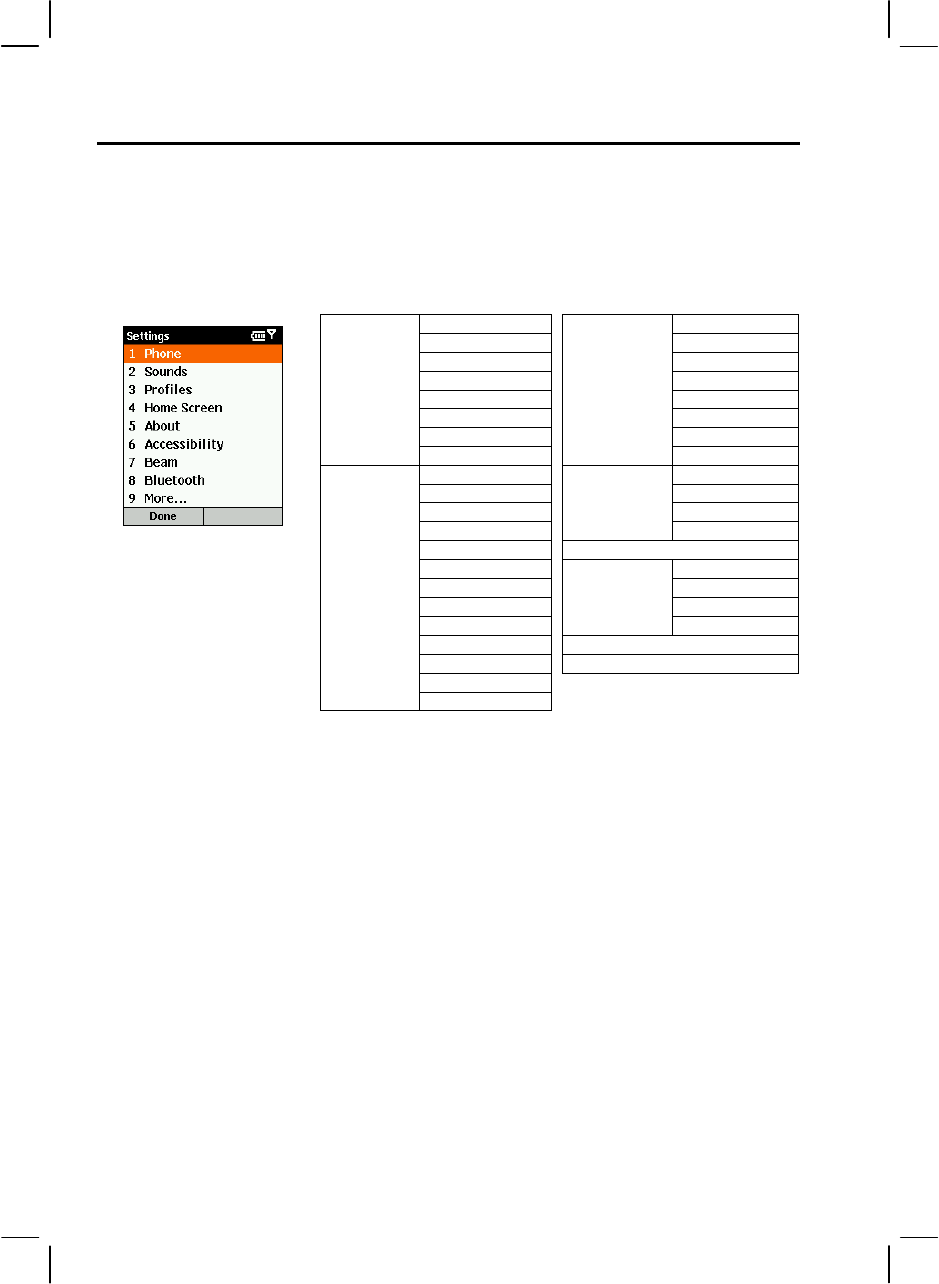
44
4.1 Settings (Page 1)
On the Home screen, press the Start soft key and select Settings to access Settings, which
contains three setting pages.
To help you locate the item you want to set up, the following table shows the setting items and
sub items on page 1, and then describe all the items in sequence.
Setting Items (Page 1)
1 Call Barring 1 Normal
2 Call Forwarding 2 Silent
3 Call Options 3 Meeting
4 Call Waiting 4 Outdoor
5 Caller ID 5 Automatic
6 Channels 6 Headset
7 Fixed Dialing 7 Car
1 Phone
8 Networks
3 Profiles
8 Speakerphone
Ring tone Home screen layout
Reminders Color scheme
New e-mail Background image
New text message
4 Home Screen
Time out
New voice message 5 About
New instant message System font size
New channel message Multipress time out
Alarm clock Confirmation time out
SIM toolkit message
6 Accessibility
In-call alert volume
Exclamation 7 Beam
Question 8 Bluetooth
Warnings
2 Sounds
Keypad control

45
Phone
You use Phone settings to set options such as call forwarding, call waiting, and caller ID.
These settings are related to the services you applied with your service provider.
Call Barring
To block incoming or outgoing calls:
1. On the Home screen, press the Start soft key, and select Settings Phone Call
Barring.
2. In Block incoming calls or Block outgoing calls, scroll to the option you want: Off,
When Roaming, or All Calls.
3. Select Done. You will not be able to receive or make calls according to the options that
you selected.
Call Forwarding
To forward all or selected calls to another number:
1. On the Home screen, press the Start soft key, and select Settings Phone Call
Forwarding.
2. Select the condition under which to forward calls as follows:
• Unconditional to forward all calls
• No Reply to forward calls when you do not answer
• Busy to forward calls when your line is busy
• Unavailable to forward calls when your phone is off or out of service range
3. Select Enable call forwarding.
4. Enter the phone number to which calls are to be forwarded.
5. Select Done.

46
Call Options
To set up various call options:
1. On the Home screen, press the Start soft key, and select Settings Phone Call
Options.
2. The available options are:
• An key answer allows you to press any key to answer an incoming call.
• Show SIM contacts displays SIM contacts when you open Microsoft Contacts.
• Voice mail number allows you to enter your voice-mail phone number.
• SMS service center allows you to enter your SMS service center phone number.
• Country code allows you to specify your country code and area code.
3. Select Done.
Call Waiting
To turn call waiting notifications on or off:
1. On the Home screen, press the Start soft key, and select Settings Phone Call
Waiting.
2. Select Provide call waiting notifications.
3. Select Done. When you receive a call while you are already on a call, you will be notified.
Caller ID
To configure caller ID:
1. On the Home screen, press the Start soft key, and select Settings Phone Caller ID.
2. In Provide my caller ID to, scroll to the option you want: Everyone, No one, or Only
my contacts.
3. Select Done. The selected callers will be able to see your name and phone number
information when you call them.

47
Channels
Your service provider may provide add-on services such as cell broadcast. With this service,
you can receive a variety of information such as weather forecast, stock, and traffic.
To configure cell broadcast:
1. On the Home screen, press the Start soft key, and select Settings Phone Channels.
2. Select the options you want.
3. Select Done.
Fixed Dialing
To limit calls to specific area codes or phone numbers:
1. On the Home screen, press the Start soft key, and select Settings Phone Fixed
Dialing.
2. Select Enable fixed dialing.
3. Select Menu and then Edit Numbers.
4. Select Menu and then Add.
5. Enter the phone number or area code to which to restrict calling and select Done.
6. Repeat steps 4 and 5 to add more numbers as necessary. You will be able to make and
receive calls only to and from the numbers or area codes specified.
Networks
To select networks:
1. On the Home screen, press the Start soft key, and select Settings Phone Networks.
2. In Network selection, scroll to the option you want: Manual or Automatic.
3. If you selected Manual, select Menu and then Select a Network. Select the network and
select Done. The Smartphone will use the selected network.
If you selected Automatic, select Menu and then Preferred Networks. Select the
networks to use and select Done. The Smartphone will automatically use the preferred
networks.

48
To add a network:
1. On the Home screen, press the Start soft key, and select Settings Phone Networks.
2. Select Menu and then Preferred Networks.
3. Select Menu and then Add.
4. Select the network you want to add.
5. Select Select and then Done.
To create a custom network:
1. On the Home screen, press the Start soft key, and select Settings Phone Networks.
2. Select Menu and then Preferred Networks.
3. Select Menu and then Add Custom.
4. Enter your network code. Valid network codes are five or six digits and numeric.
5. Select Done.
Sounds
You can use Sounds settings to customize the sounds for ring tones, notifications, reminders,
and other events. You can also turn the tones that you hear when pressing number keys on or
off, and specify the type of tone your Smartphone sends over the network.
Specifying the Sound for an Event
To specify the sound for an event:
You can specify the sound to use for an event or elect not to use a sound. You can select one of
the sounds included with your Smartphone, or you can add your own sound to use.
1. On the Home screen, press the Start soft key, and select Settings Sounds.
2. Scroll to the event for which to specify a sound.
3. Scroll left/right to select a sound; or, press the Navigation stick to select from the full list.
When you select a sound, the sound plays. To play it again, select Menu and then Play.
Select None if you don’t want to hear a sound for the event.

49
To add your own sound:
1. Connect your Smartphone to your desktop computer using a USB connection.
2. On your desktop computer, copy the sound file you want. The file format must
be .wav, .mid,.wma, or .mp3.
3. In ActiveSync on your desktop computer, click Explore and then double-click My
Smartphone.
4. Do one of the following:
• To save the sound on your phone, double-click Storage, double-click Application
data, double-click Sounds, and then paste the sound file into the Sounds folder.
• To save the sound on your storage card, double-click Storage Card, double-click
My Documents, and then paste the sound file into the My Documents folder.
You can now specify this sound for a ring tone, notification, or reminder on your Smartphone,
as described earlier. For ring tones, you can use sounds in either .wav, mid, or .wma , or mp3
file format.
To delete a sound:
1. On the Home screen, press the Start soft key, and select Settings Sounds.
2. Select Menu and then Delete Sounds.
3. Select the sound to delete.
4. Select Yes.
|NOTE}
You can use sounds in the .wma file format as ring tones only; you cannot
use .wma files for notifications or reminders.
You can only delete sounds that you added. You cannot delete sounds
included with the Smartphone.
Changing Tones
The Smartphone generates tones that represent the numbers you press on the keypad. It sends
these tones over the network to communicate with other devices, such as answering machines
and voice mail systems. At the same time, it plays the tones so that you can hear them.
If you want, you can turn off the tones that you can hear or else change them to clicks. When
you do this, the phone still sends tones across the network, and they are audible to devices or
people on the other end of the line.
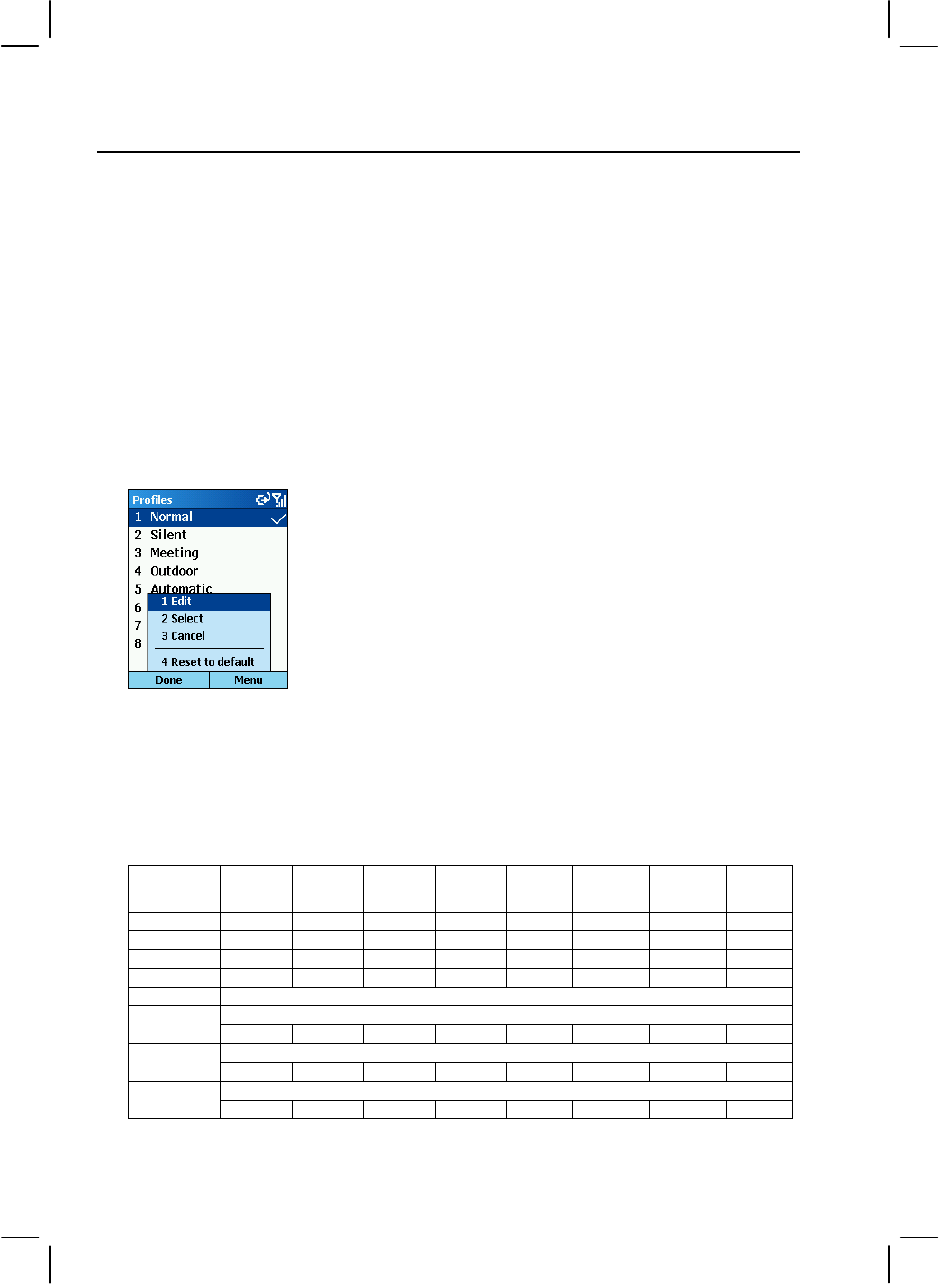
50
To change or turn off tones:
1. On the Home screen, press the Start soft key, and select Settings Sounds.
2. In Keypad control, scroll to the option you want—Tone, Click, or None.
3. Select Done.
To turn on tones:
1. On the Home screen, press the Start soft key, and select Settings Sounds.
2. In Keypad control, scroll to Click.
3. Select Done.
Profiles
You can use Profiles settings to change how the Smartphone
notifies you of events such as incoming calls, approaching
appointments, or arriving messages.
The Smartphone includes eight profiles. You can use the profiles
as-is, or you can edit and rename them to suit your needs. For each
profile, you can choose the ring type and volume, the alarm type
and volume, the notification type and volume, and the system
sound volume.
You can quickly select the profile suited to your current situation. For example, when you are
attending a meeting, you can choose the Meeting profile, which silences the ring of your
phone and provides visual notifications only. When you are waiting for an important call, you
can choose the Outdoor profile, which makes your phone ring loudly.
The following table describes the profiles that are included with the Smartphone. The default
profile is the Normal profile.
Profile Name Auto-
answer
Time
Ring
Type
Ring
Volume
Alarm
Type
Alarm
Volume
Notification
Type
Notification
Volume
System
Sound
Volume
Normal -- Ring 3 Increasing 3 Play sound 3 3
Silent -- Vibrate Off Vibrate Off Vibrate Off Off
Meeting -- Vibrate 1 Play sound 1 Play sound 1 Off
Outdoor -- Ring Loud Increasing Loud Play sound Loud Loud
Automatic Toggles between Normal and Meeting, based on your calendar.
When you connect the hands-free phone headset, your Smartphone will automatically use this profile. Headset
Never Ring 3 Increasing 3 Play sound 3 3
When you connect the car kit, your Smartphone will automatically use this profile. Car
Never Ring 4 Increasing 4 Play sound 4 4
When you use the speakerphone function, your Smartphone will automatically use this profile. Speakerphone
-- Ring Loud Increasing Loud Play sound Loud Loud

51
To change the current profile:
Press and hold the End key until the Quick List appears. The list on the first screen
contains four modes: Normal, Silent, Meeting and Outdoor. If you want to select from other
modes, go to the next screen to select a mode.
To editing a profile:
1. On the Home screen, press the Start soft key, and select Settings Profile.
2. Scroll to the profile to edit.
3. Select Menu and then Edit.
4. Modify the settings and select Done.
|NOTE}
To cancel without saving changes, select Cancel.
To revert to the default profile settings, select Menu and then Reset to
Default.
Home Screen
You can use Home Screen settings to change the Home screen layout, the color scheme, the
background image, and the time delay before the Home screen appears when the Smartphone
is idle.
To change the Home screen appearance:
You can change the Home screen layout, color scheme, and background image to any of the
available options instead of using the default settings.
1. On the Home screen, press the Start soft key, and select Settings Home.
2. In Home screen layout, Color scheme, and Background image, scroll to the options you
want.
3. Select Done. The image appears behind the text on the Home screen.

52
To add your own background image:
1. Connect your Smartphone to your desktop computer using a USB connection.
2. On your desktop computer, copy the image file you want. The file format must
be .gif, .jpg, or .bmp. For best results, use images with a 176 x 200 screen resolution to fit
on the screen.
3. In ActiveSync on your desktop computer, click Explore and then double-click My
Smartphone.
4. Double-click Storage, double-click Application data, double-click Home.
5. Paste the image file into the Home folder.
You can then use this image for your Home screen, as described earlier.
To specify the idle time before the Home screen appears
1. On the Home screen, press the Start soft key, and select Settings Home.
2. In Time out, scroll to the amount of time for the Smartphone to be idle before the Home
screen automatically appears.
3. Select Done.
About
The About screen displays information about the Smartphone’s operating system, including
version numbers and copyright information, and the available storage space, memory, etc.
On the Home screen, press the Start soft key, and select Settings About to view the About
screen.

53
Accessibility
You can use Accessibility settings to configure the system font size, multipress time out,
confirmation time out, and in-call alert volume.
1. On the Home screen, press the Start soft key, and select Settings Accessibility.
2. Select the options you want, as follows:
• System font size to set the size of the font on your screen.
• Multipress time out to set the length of time between keypresses when entering text
in Multipress mode.
• Confirmation time out to set the delay before an unconfirmed action times out.
• In-call alert volume to set the volume of sounds that play when you are on a call.
3. Select Done.
Beam
If you want to receive infrared beams from other devices, you must turn on the option to
receive incoming beams.
On the Home screen, press the Start soft key, and select Settings Beam. Select Receive
incoming beams. The Smartphone receives all incoming beams from other devices until you
clear this option.
Bluetooth
Your Smartphone does not support Bluetooth.
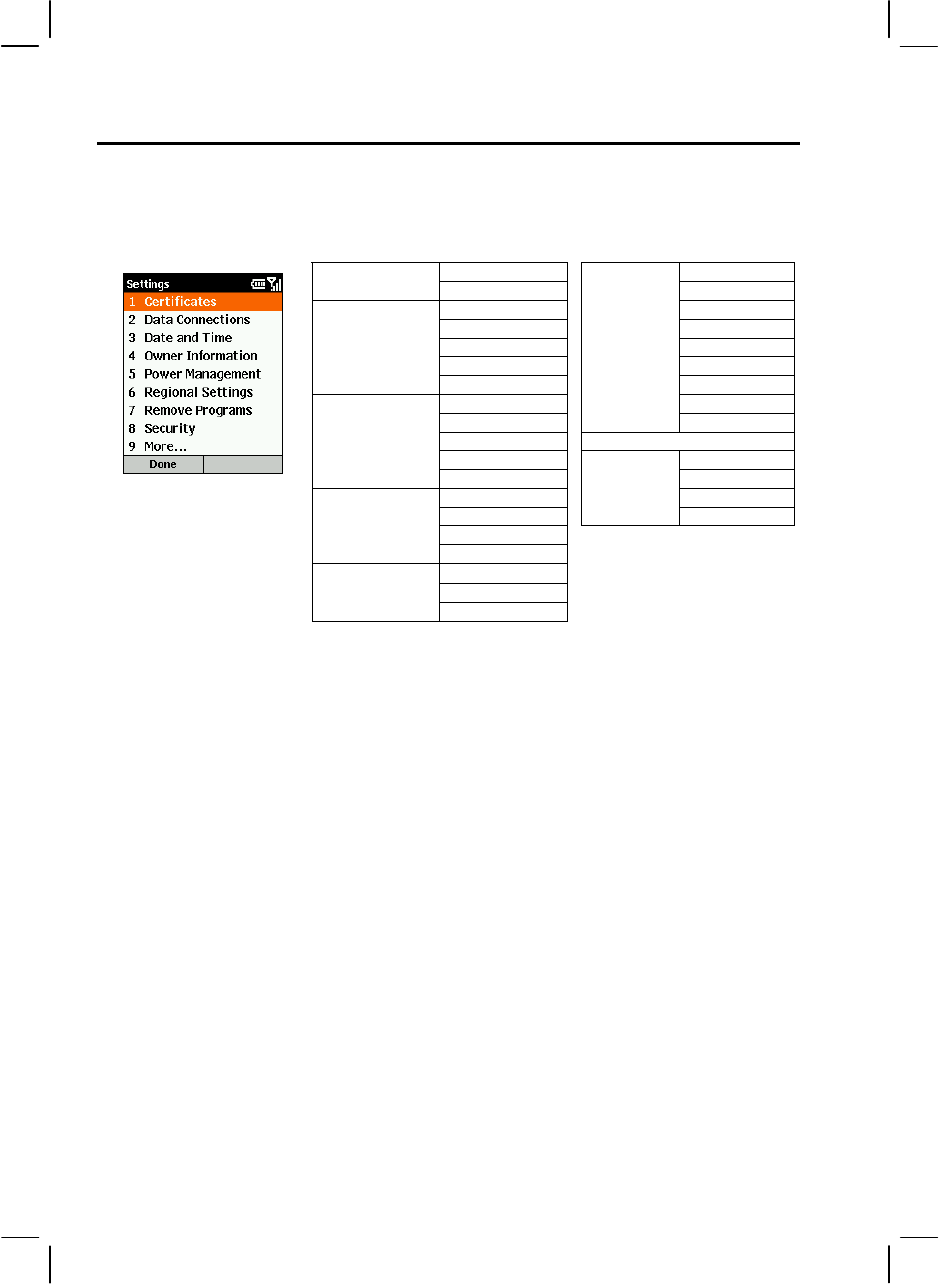
54
4.2 Settings (Page 2)
To help you locate the item you want to set up, the following table shows the setting items and
sub items on page 2, and then describe all the items in sequence.
Setting Items (Page 2)
1 Personal Language 1 Certificates
2 Root Locale
Internet connection Short data style
Work connection Long date style
Wap connection Time format
Secure WAP connection Positive number
2 Data Connections
MMS Connection Negative number
Time zone Positive currency
Date
6 Regional
Settings
Negative currency
Time 7 Remove Programs
Alarm 1 Enable Phone Lock
3 Date and Time
Alarm time 2 Disable SIM Lock
Name 3 Change PIN
Telephone number
8 Security
4 Change PIN2
E-mail address
4 Owner Information
Notes
Main battery
Backlight time out
5 Power Management
Display time out

55
Certificates
On your Smartphone you can add and delete public key certificates. These certificates help
establish your identity when you log on to a secure network, such as a corporate network.
Certificates also help establish the identity of other computers, such as servers, with which
you connect. This helps prevent unauthorized users from accessing your device and its
information.
You can store two types of certificates on your phone: personal certificates that establish your
identity, and root certificates that establish the identity of servers with which you connect.
Your device may include a set of preinstalled certificates.
To view and delete certificates:
1. On the Home screen, press the Start soft key, and select Settings Certificates.
2. To view the list of personal certificates, select Personal.
3. Do any of the followings:
• To view the details about a certificate, select it in the list.
• To view the list of root certificates, select Root.
• To delete a certificate, scroll to it in the list, select Menu, and then select Delete.
Data Connections
You can use Data Connections settings to create dial-up, Virtual Private Network (VPN),
GPRS, and proxy connections so that you can connect to the Internet or your corporate
network. By using a data connection, you can browse the Web, download e-mail, chat by
using MSN® Messenger, or synchronize remotely with an Exchange Server. Check with your
service provider to see if a data connection has already been set up for you, and if over-the-air
configuration is supported.
Working with GPRS Connections
GPRS is a high-speed transmission through the mobile phone network, which features
“always on.”
If you subscribe to GPRS (General Packet Radio Services), you can set up a GPRS connection
to gain access to your corporate network or the Internet. This is faster than a dial-up
connection.
You can also use your Smartphone as a GPRS modem for a desktop computer.

56
To create a GPRS connection:
Your Smartphone comes with customized GPRS connection settings for you to select. If you
want to manually set up a connection, follow this procedure:
1. Obtain the following information from your service provider: the APN (Access Point
Node) name and DNS (Domain Name Servers) name (if required).
2. On the Home screen, press the Start soft key, and select Settings Data Connections.
3. Press the Menu soft key and select Edit Connections.
4. Select GPRS Connections.
5. Press the Menu soft key and select Add.
6. Enter the requested information as follows:
• In Description, enter a name for the connection.
• In Connects to, scroll to the type of network to which you will connect.
• In Access point, enter the information provided by your system administrator.
• In User name, enter your user name for the GPRS network.
• In Password, enter your password.
• In Primary DNS, enter the primary domain naming system (DNS) address, as
provided by your network administrator.
• In Secondary DNS, enter the secondary DNS address, as provided by your system
administrator.
• In IP address, enter the Internet Protocol (IP) address, as provided by your system
administrator.
7. Press the Done soft key.
To connect to the Internet with a GPRS connection:
1. On the Home screen, press the Start soft key, and select Settings Data Connections.
2. In Internet Connection, select the GPRS you want to use and select Done.
When you open a program that connects to the Internet, the Smartphone uses this connection.
The icon indicates that GPRS is being used; you can press the End key to
temporarily stop the GPRS connection.

57
Working with Dial-up Connections
You can create a dial-up connection to connect remotely to the Internet, a Wireless
Application Protocol (WAP) network, or your corporate network. Then, when you open a
program that is configured to use this connection, the Smartphone uses it to automatically
connect to the network. For example, you can create an Internet connection and then
configure Pocket Internet Explorer to use it. Then, when you start Internet Explorer and
browse to a Web page on the Internet, the Smartphone automatically connects to the Internet
by using your Internet connection.
To create a dial-up connection:
Your Smartphone comes with customized dial-up connection settings for you to select. If you
want to manually set up a connection, follow this procedure:
1. Obtain the following information from your ISP: the number to dial up, the Domain name,
the user name and password.
2. On the Home screen, press the Start soft key, and select Settings Data Connections.
3. Press the Menu soft key and select Edit Connections.
4. Select Dial-up Connections.
5. Press the Menu soft key and select Add.
6. Enter the requested information as follows:
• In Description, enter a name for the connection.
• In Connects to, scroll to the network.
• In Phone number, enter the phone number you use to dial the network.
• In User name, enter your network user name.
• In Password, enter your password.
• In Domain, enter the domain name, if required.
7. Press the Done soft key.
|NOTE}
If you subscribe to GPRS, you can set up a GPRS connection to access your
corporate network or the Internet, which is faster than a dial-up connection. For
instructions, see “Working with GPRS Connections.”

58
Working with VPN Connection
If your company has set up a virtual private network (VPN), you can create a VPN connection
to gain access to your corporate network over an Internet connection.
To create a VPN connection:
1. On the Home screen, press the Start soft key, and select Settings Data Connections.
2. Select Menu and then Edit Connections.
3. Select VPN Connections.
4. Press the Menu soft key and select Add.
5. Enter the requested information as follows:
• In Description, enter a name for the connection.
• In VPN type, scroll to the type of VPN.
• In Server, enter the VPN server name.
• In Connects from, scroll to the type of network from which you will connect to the
VPN (typically The Internet).
• In Connects to, scroll to the type of network to which you will connect (typically My
Corporate Network).
• In User name, enter your user name for the VPN.
• In Password, enter your password.
• In Domain, enter the domain name, if required.
• If you selected IPSec in VPN type, In IPSec authentication, select the type of
authentication: Pre-Shared Key or Certificate.
• If you selected Pre-Shared Key in IPSec authentication, in IPSec Pre-shared key,
enter the key.
6. Select Done.

59
Working with Proxy Connections
You can use a proxy connection to gain access to the Internet over an existing connection to
your corporate network.
To create a proxy connection:
Your Smartphone comes with customized proxy connection settings for you to select. If you
want to manually set up a connection, follow this procedure:
1. On the Home screen, press the Start soft key, and select Settings Data Connections.
2. Select Menu and then Edit Connections.
3. Select Proxy Connections.
4. Select Menu and then Add.
5. Enter the requested information as follows:
• In Description, enter a name for the connection.
• In Connects from, scroll to the type of network from which you will connect.
• In Connects to, scroll to the type of network to which you will connect.
• In Proxy (name:port) enter the proxy server name and port number in the form:
server name:port number.
• In Type, scroll to the type of proxy connection to create.
• In User name, enter your user name for the network to which you will connect.
• In Password, enter your password.
Editing or Deleting a Connection
1. On the Home screen, press the Start soft key, and select Settings Data Connections.
2. Select Menu and then Edit Connections.
3. Select xxx Connections (where xxx means the type of connection) and scroll to the
connection to edit or delete.
4. To edit the connection, select Menu and then Edit. Change any information and select
Done.
To delete the connection, select Menu and then Delete. Select Yes.

60
Adding a URL Exception
Some URLs for Web pages on your company intranet may use periods, for example:
intranet.companyname.com. To view these pages in Pocket Internet Explorer, you must create
a URL exception. Otherwise, the pages will not display. (You do not need to create URL
exceptions for Internet URLs.)
To add a URL exception:
1. On the Home screen, press the Start soft key, and select Settings Data Connections.
2. Select Menu and then Work URL Exceptions.
3. Select Menu and then Add.
4. In URL Pattern, enter the URL and select Done. Separate multiple URLs with a
semicolon (;).
To edit or delete a URL exception:
1. On the Home screen, press the Start soft key, and select Settings Data Connections.
2. Select Menu and then Work URL Exceptions.
3. Select the URL to edit or delete.
4. To edit the URL, change any information and select Done.
To delete the connection, select Menu and then Delete. Select Yes.
Date and Time
You can use Date and Time settings to change the local time zone and the current date and
time, and to set the alarm.
To set the date and time:
1. On the Home screen, press the Start soft key, and select Settings Data and Time.
2. In Time Zone, scroll to your time zone.
3. In Date, scroll to the month, date, or year and edit the information.
4. In Time, scroll to a number and edit it.
5. Select Done.
To set the alarm:
1. On the Home screen, press the Start soft key, and select Settings Data and Time.
2. In Alarm, scroll to Off or On to turn the alarm off or on.
3. In Alarm time, specify the time for the alarm to go off.
4. Select Done

61
Owner Information
You can use Owner Information settings to record personal information, such as your name,
phone number, and e-mail address. This is helpful, for example, in the event that you lose your
Smartphone, so that you can be contacted if it is found.
On the Home screen, press the Start soft key, and select Settings Owner Information to
access the Owner Information setting items.
Power Management
You can use Power Management to configure settings that prolong battery life, such as
shortening the amount of time before the backlight and display turn off when the Smartphone
is idle. You can also check the battery level.
1. On the Home screen, press the Start soft key, and select Settings Power
Management.
2. Main battery displays the amount of battery life remaining.
3. In Backlight time out, scroll to the amount of time for the Smartphone to be idle before
the backlight turns off.
4. In Display time out, scroll to the number of minutes for the Smartphone to be idle before
the display turns off.
5. Select Done.
Regional Settings
You can use Regional Settings to change the language, date, and time style, as well as number
and currency formatting options.
1. On the Home screen, press the Start soft key, and select Settings Regional Settings.
2. In Language, scroll to the language to use when entering information.
3. In Locale, scroll to your locale. This changes the remaining settings appropriately for
your locale.
4. Configure other settings in the same manner.
5. Select Done.
|NOTE}
After changing the language, you must turn your device off and on for the
change to take effect.

62
Remove Programs
You can use Remove Programs to remove programs installed on the Smartphone, with the
exception of core programs that came with the Smartphone, for example, Contacts, Calendar,
and Internet Explorer.
|NOTE}
Be careful when you remove programs.
1. On the Home screen, press the Start soft key, and select Settings Remove Programs.
2. Scroll to the program you want to remove and then press the Navigation stick. You can
also press the Menu soft key to select Remove.
3. Press the Yes soft key to remove the program.
Security
Security settings are used to enable phone lock and SIM lock. (For details, see section 2.4.)
On the Home screen, press the Start soft key, and select Settings Security to access the
Security setting items.
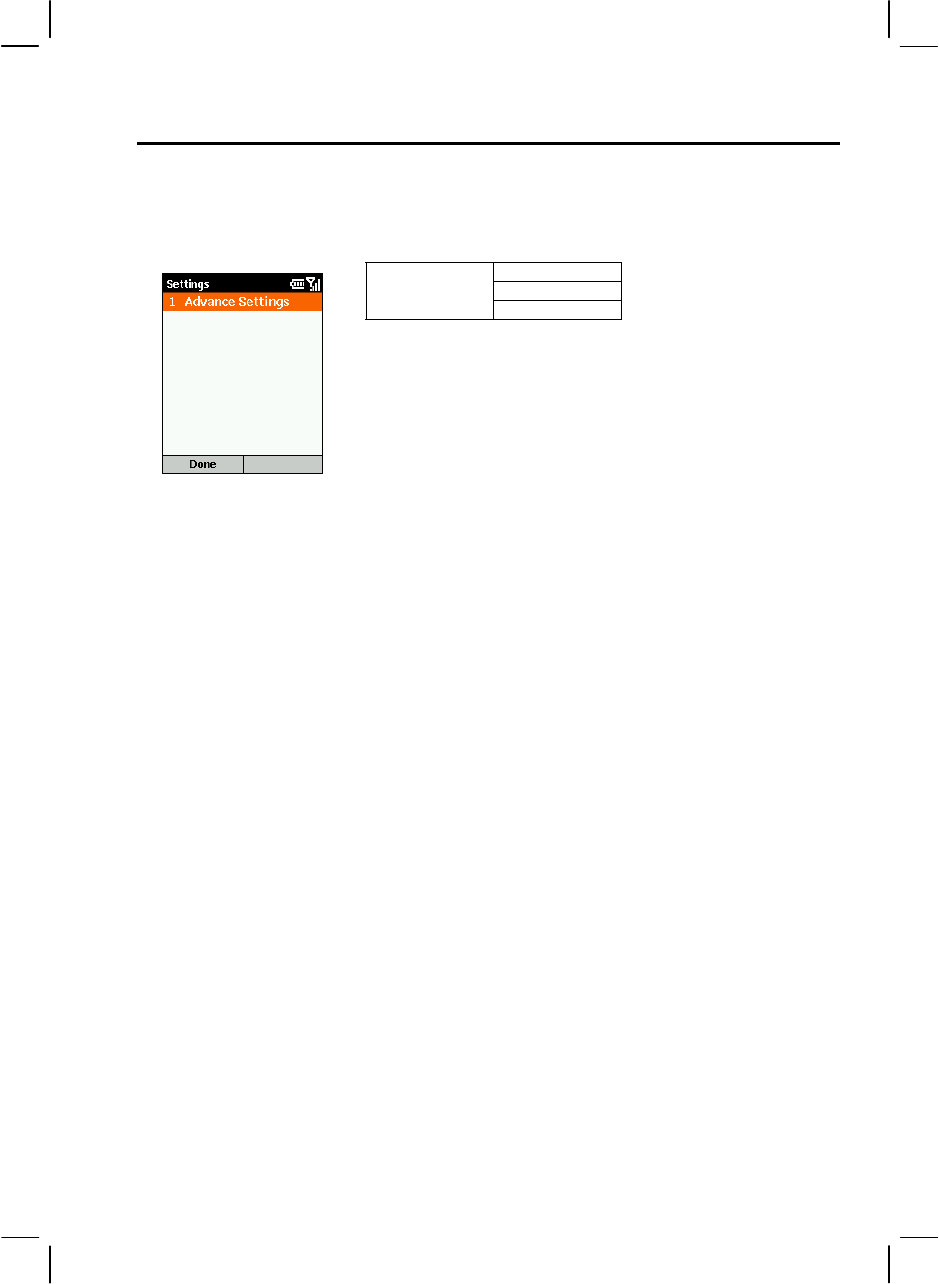
63
4.3 Settings (Page 3)
To help you locate the item you want to set up, the following table shows the setting items and
sub items on page 3, and then describe all the items in sequence.
Setting Items (Page 3)
Brightness setting
Keypad LED on
1 Advance Settings
Only End key wakeup
Advance Settings
On the Home screen, press the Start soft key, and select Settings Advance Settings to
access the Advance Settings items.
To adjust brightness setting, scroll left/right to adjust the sliding bar.
To enable or disable the keypad light, check or uncheck the Keypad LED on box.
To specify the End key as the key for waking up the Smartphone from sleep mode, check
the Only End key wakeup box. If the box is unchecked, you can press any key to wake
up the Smartphone.

65
5 Messaging Features
You can use your Smartphone to send and receive e-mail, text messages, media messages, and
instant messages. This chapter describes how to work with messages on your Smartphone.
|NOTE}
Not all service plans include sending text or media messages. If you are not
sure what your service plan supports, ask your mobile phone service provider.

66
5.1 Understanding Messaging Types
The Smartphone supports e-mail messaging, text messaging (SMS), media messaging
(MMS), and instant messaging. You can work with e-mail, text messages, and media
messages from Messaging. You can use instant messaging features from MSN Messenger.
Configuring and using these features is described later in this chapter.
E-mail Messaging
There are three ways to send and receive e-mail messages with the Smartphone:
By synchronizing your Outlook E-mail Inbox folder with Microsoft® Outlook® on your
desktop computer or your Microsoft® Exchange server.
By connecting to a POP3 or IMAP4 e-mail server to send and receive Internet e-mail
messages.
Use Pocket Internet Explorer to view Web-based e-mail.
Text Messaging (SMS)
You can send and receive text messages up to 160 characters in size. If a text message is
longer, it is automatically sent in chunks as several small text messages, and is then unified as
one text message after all of the small text messages have been received.
The advantages of text messages include the following:
Text messages are sent instantly.
Text messages can be sent or received at any time, including during a voice or data call.
Most mobile phones support text messages, so most recipients can read text messages that
you send.
|NOTE}
You cannot synchronize text messages with your desktop computer, and you
cannot use text messages to send or receive attachments or voice notes.

67
Media Messaging (MMS)
Media messages are composed of one or more pages, and each page can contain up to one
picture, text region, and sound. In a multi-page message, each page is displayed for five
seconds before automatically advancing to the next page. Thus, when the recipient opens your
media message, the experience is similar to watching a simple slideshow.
The advantages of Media messages include the following:
Media messages essentially “play” the picture or sound you attach to the message, so the
recipient does not have to download the file(s) first.
Media messages can be sent or received any time your phone is turned on and not in a
voice or data call.
Instant Messaging
You can use MSN® Messenger on the Smartphone to send and receive instant messages.
MSN Messenger on the Smartphone provides the same chat environment as MSN Messenger
on your desktop computer. For example, you can chat with a single MSN Messenger contact,
or with several contacts at once. You can switch between active chats, block contacts, and
configure display settings, such as your name and current status (Away, Online, and so on).

68
5.2 Setting up Messaging Accounts
Your Smartphone is already set up for text messaging, media messaging, and voice mail
messaging, if your mobile phone service includes these features. You can use them without
performing any additional steps.
This section describes the steps required for setting up the Smartphone to send and receive
e-mail messages. (Setting up the Smartphone for instant messaging is described later in
section 5.8)
You can use up to eight different messaging accounts with the Smartphone.
Setting up Outlook Synchronization
Your Smartphone includes an Outlook E-mail account. You can synchronize this account
with Outlook on your desktop computer or Exchange Server. When you do this, messages in
the Outlook E-mail Outbox on the Smartphone are sent, and messages you have received in
Outlook are copied to the Outlook E-mail account folders on your Smartphone. Only those
folders that are marked for synchronization on your Smartphone are synchronized in this
manner.
Setting up the Smartphone for synchronization is described in Chapter 7, “Synchronizing
Information.” Specifying which ActiveSync folders to synchronize is described in “Mark a
folder for synchronization” in this chapter.
|NOTE}
To synchronize remotely, you must also configure a data connection, as
described in “Data Connections” in Chapter 4.
Setting up an Internet E-mail Account
Another way to send and receive e-mail messages is by using Internet e-mail. To do this, you
must:
Have an Internet e-mail account.
Configure a data connection on the Smartphone for connecting to the Internet. (For more
information, see “Data Connections” in section 4.1.)
Set up an Internet e-mail account in Messaging.
To set up an Internet e-mail account, you need to know which type of e-mail server hosts your
mailbox: IMAP4 or POP3. You also need to know the name of your incoming and outgoing
e-mail servers. If you are not sure, ask your service provider or network administrator. In
addition, you need to know your e-mail user name and password, and if required, your domain
name.

69
To set up Internet E-mail:
1. On the Home screen, press the Start soft key and select Messaging.
2. Press the Menu soft key and select Options.
3. Select Account Setup, press the Menu soft key and select New.
4. In Your name, enter your display name for e-mail messages.
5. In E-mail address, enter the e-mail address for this account.
6. Select Attempt to obtain e-mail settings from the Internet if you want to set up your
account automatically. If your account could not be set up automatically or you want to set
it up manually, continue with step 7.
7. In User name, enter your user name. This is usually the first part of your e-mail address,
which appears before the “at” sign (@).
8. In Password, enter your password.
9. In Domain, enter the domain name, if required.
10. To save your password, so that you do not need to enter it each time you connect to your
e-mail server, select Save password.
11. Select Next.
12. In Server type, scroll to select the type of e-mail server that hosts your mailbox—POP3
or IMAP4—and select Next.
13. In Account name, enter a name for this account. You must use a different name for each
account that you set up.
14. In Network, scroll to the type of network that your e-mail server runs on and select Next.
15. Enter information about your e-mail servers. If you are not sure what to enter, ask your
network administrator.
16. Select the security options if necessary and select Next.
17. Select message download options and select Next.
18. Select a connection option, select Next, and then select Finish.
|CAUTION}
If you save your password and then lose your Smartphone, someone finding
your Smartphone might be able to gain access to your e-mail.
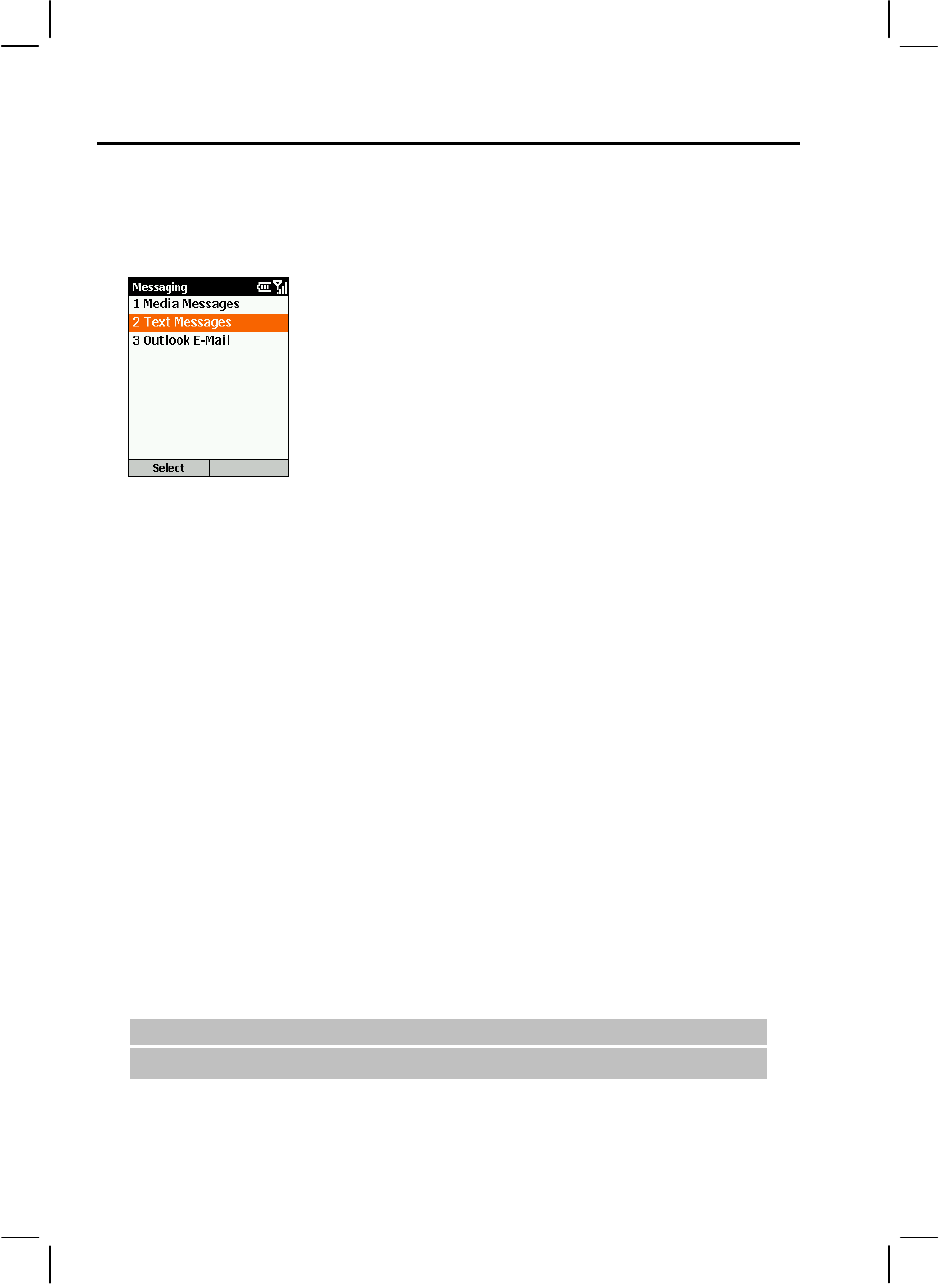
70
5.3 Working with Accounts
You can use up to eight different messaging accounts with the Smartphone. For information
on setting up an account, see section 5.2. This section describes how to work with the
accounts.
To view the list of accounts:
On the Home screen, press the Start soft key and select
Messaging.
The list of accounts displays with the number of unread messages
in the Inbox of each account shown in parentheses.
You can open an account by selecting it in the list.
To quickly move between accounts:
If you have an account open, you can quickly switch to another account by scrolling right or
left. Or, you can select Menu and then Switch Accounts.
To changing e-mail account options:
1. On the Home screen, press the Start soft key and select Messaging.
2. Select an account.
3. Select Menu and then Options.
4. Select the type of options to change.
5. Change the options and select Done.
To delete an account:
1. On the Home screen, press the Start soft key and select Messaging.
2. Select an an account.
3. Press the Menu soft key Options.
4. Select Account Setup.
5. Scroll to the account to delete
6. Press the Menu soft key Delete.
|NOTE}
You cannot delete your Media Messages account.

71
5.4 Creating Messages
You can start creating a new e-mail, text message, or media message from Messaging. You
can also create a new e-mail or text message from Contacts. After you create a message, you
can send it as described later in section 5.5.
|NOTE}
Not all service plans include sending text messages or media messages. If you
are not sure what your service plan supports, ask your service provider.
You can create messages in Messaging by switching to the account to use, opening a new
message, addressing it, and then composing the message. For information about entering text
on the Smartphone, see section 2.3.
Creating a Message in Messaging
1. On the Home screen, select Start and then Messaging.
2. Select an account.
3. Select New.
4. In To, enter recipient e-mail addresses, text message numbers, or media message
addresses. Insert a semicolon (;) between multiple addresses or numbers.
|NOTE}
You can only enter text message numbers in a text message, and e-mail
addresses in an e-mail message. Media message addresses can be either
phone numbers or e-mail addresses.
5. In Cc and/or Bcc, enter the e-mail or media message addresses of persons to receive a
copy. This field does not appear for text messages.
6. In Subj, enter a subject. This field does not appear for text messages.
7. To insert a picture, sound, or text into a media message, select Menu, Insert, and then
select Picture, Sound, or Text.
8. To change the background color of all the pages in your message, select Menu,
Background Color and select the color you want.
9. To add a page to a media message, select Menu, Pages, and then Add Page.
10. To preview a message, select Menu and then Preview.
11. Select Send. For information about how media messages are sent, see section 5.5.

72
|NOTE}
You can quickly enter e-mail addresses, text message numbers, or media
message addresses from your contact cards. In To, press the Action key and
select a recipient from the list. Then, select the recipient’s e-mail address,
phone number, or media message address.
To insert punctuation such as the “at” sign (@), a period (.), or a semicolon (;),
repeatedly press the 1 key in Multipress mode until the punctuation appears or
press and hold the # key to view a list of symbols that you can enter as text.
To cancel a message, select Menu and then Cancel Compose.
Creating a Message from a Contact Card
If you have included an e-mail address or text message number in a contact card, you can
create a new message from a contact card.
1. On the Home screen, select Start.
2. Select Contacts.
3. Select the contact.
4. Select the e-mail address or text message number to use.
5. Select the account to use.
6. In Subj, enter a subject. This field does not appear for text messages.
7. Enter a message.
8. Select Send. E-mail messages are stored in Outbox and sent to recipients the next time
you synchronize or connect to your e-mail server and send and receive mail. Text
messages are sent immediately.
Using Predefined Text in Messages
To save time entering text, you can insert predefined text into messages. You can edit the
predefined text included with the Smartphone to create words or phrases that you frequently
use in messages.
To insert predefined text into a message:
1. When composing your message, press the Menu soft key and select Insert Text for
e-mail and text messages, or Menu, Insert, and then Text for media messages.
2. The predefined text appears on the screen. Scroll to the text to insert into your message
and press the Insert soft key.

73
To editing predefined text:
1. While in an account, press the Menu soft key, and select Options Edit My Text.
2. Scroll to the text to edit, enter the new text, and press the Done soft key.
Inserting Voice Recordings into Messages
You can easily insert a voice recording into an e-mail message. Inserting a voice recording is
useful when you want to verbally explain information that is contained in the message.
1. When composing your message, press the Menu soft key and select Insert Recording.
2. The Voice Memo appears on the screen. Press the Record soft key and start speaking into
the Smartphone microphone.
3. When finished speaking, press the Stop soft key.
4. Press the Done soft key to insert the recording into your message.
|NOTE}
You can send only one voice recording in an e-mail message. If you create a
second voice recording in an e-mail message, it replaces the first recording.
Inserting Pictures into Messages
You can easily insert a picture into a media message.
1. When composing a media message, scroll to the picture area of the message and press the
Navigation stick. Or, in the body of the message, select Menu, Insert, and then Picture.
2. Select the picture you want to insert.
|NOTE}
To remove a picture, select the picture, select Menu, and then Remove
Object.
Inserting Sounds into Messages
You can easily insert a sound into a media message.
1. In the message area, select Menu, Insert, and then Sound.
2. Select the sound you want to insert and press the Navigation stick. The sound appears as
an attachment in the message.
|NOTE}
To remove a sound, select the sound attachment, select Menu, and then
Remove Object.

74
Inserting Signatures into Messages
For each e-mail account and your text messaging account, you can specify a signature to be
automatically inserted into messages that you send.
1. While in a messaging account, press the Menu soft key, and select Options
Signatures.
2. Scroll right to switch to the account for which you want to specify a signature.
3. Select Use signature with this account.
4. To insert a signature in every message you send, select Include when replying and
forwarding. Otherwise, a signature is inserted only in new messages.
5. Replace the text in the Signature box with a signature to insert, and select Done. The
signature is inserted into messages that you send from this account.
|NOTE}
To stop inserting a signature in messages, repeat the above procedure, but
clear Use signature with this account check box.
Saving a Draft of a Message
You can save a draft of a message that you are composing to finish and send later.
To save a draft of a message:
1. On the Home screen, select Start and then Messaging.
2. Select an account.
3. Select New.
4. Enter information in the message.
5. Select Menu and then Postpone Message. A draft of the message is stored in the Drafts
folder of the account.
To reopen and send a message draft:
1. On the Home screen, select Start and then Messaging.
2. Select an account.
3. Select Menu and then Folders.
4. Select Drafts and then the draft to open.

75
5. Edit the message and select Send. E-mail messages are stored in Outbox and sent to
recipients the next time you synchronize or connect to your e-mail server and send and
receive mail. Text messages are sent immediately. For information about how media
messages are sent, see section 5.5.
Requesting a Delivery Receipt
You can request a delivery receipt for a text message or media message. When you do this,
you receive a confirmation that your message was delivered to the recipient.
To request a delivery receipt for a text message:
1. Before sending a text message, select Menu, and then Message Options.
2. Select Request message delivery notification.
3. Select Done. When your message is delivered, you receive a receipt on the Smartphone.
To request a delivery receipt for a media message:
1. Before sending a media message, select Menu, and then Message Options.
2. Select Delivery report.
3. Select Done. When your message is delivered, you will receive a receipt on the
Smartphone.

76
5.5 Sending and Receiving Messages
Sending and Receiving Media Messages
There are two modes of sending and receiving media messages: automatically and manually.
In automatic mode, messages are sent automatically when you select Send on the New
Message screen. In manual mode, messages are moved to Outbox and will be sent the next
time y ou select Send/Receive.
In automatic mode, messages are received automatically. An exception to this is when an
application that uses a wireless data connection is in use. For example, if Pocket Internet
Explorer is downloading a Web page, it will prevent a media message from being
downloaded automatically. In manual mode, you will receive a notification with
instructions on how to download the media message.
|NOTE}
Media messages cannot be sent or received during a phone call if you are in
manual mode.
To change settings for sending and receiving media messages:
1. On the Home screen, select Start and then Messaging.
2. Select Media Messages.
3. Select Menu and then Options.
4. Select Account Setup, and then Media Messages.
5. Under Send/receive, select Automatically or Manually.
Sending and Receiving Text Messages
The Smartphone immediately sends text messages when you select Send on the New Message
screen. The Smartphone automatically receives text messages whenever it is turned on. When
you receive a message, the new message icon appears at the top of the screen.
Importing Text Messages
In addition to receiving text messages wirelessly, you can import them from your SIM card.
1. On the Home screen, press the Start soft key and select Messaging.
2. Press the Text Messages.
3. Select Menu and then Options.
4. Select Import SIM Messages.
5. Press the Done soft key. The text messages are copied from the SIM card to the Inbox of
the Text Messages account.

77
|NOTE}
You cannot export text messages from your Smartphone to a SIM card.
Text messages are not removed from the SIM card after they are imported to
the Inbox of the Text Messages account.
Sending and Receiving E-Mail Messages
You can send and receive e-mail messages as follows:
By connecting to your desktop computer or Exchange Server and synchronizing the
Outlook E-mail Inbox folder on your Smartphone with Outlook, as described in Chapter
7, “Synchronizing Information.”
By using the Send/Receive menu command from an Internet e-mail account, as described
next.
To send and receive Internet e-mail messages:
1. On the Home screen, select Start and then Messaging.
2. Select the Internet e-mail account for which you want to send and receive messages.
3. Select Menu and then Send/Receive. The Smartphone connects to your Internet e-mail
server and sends and receives your messages.
|NOTE}
To stop this process, select Menu and then Stop Send/Receive.
Before you can send and receive e-mail messages, the Smartphone must be
properly configured, as described earlier in “Setting up Internet e-mail.”
You must take additional steps to receive large messages and attachments, as
described later in “Working with large messages and attachments.”

78
5.6 Viewing and Responding to Messages
When you receive an e-mail message, the Smartphone plays a sound and displays an envelope
icon at the top of the screen. By default, the Home screen also displays the number of
unopened e-mail, text messages, and media messages. To quickly view new messages, select
the message notification area on the Home screen.
Working with the Message List
Received messages are stored in the Inbox folder of the appropriate account. They are
displayed in the Inbox message list.
To view the Inbox message list:
1. On the Home screen, select Start and then Messaging.
2. Select an account. The Inbox message list displays your received messages.
By default, messages are displayed in the order received. You can change the order in which
messages are displayed and show the date and time that messages were sent.
|NOTE}
You can change the order in which messages are displayed and show the date
and time that messages were sent. While in Inbox, press the Menu soft key
Options Display. Modify the settings and press the Done soft key.
Working with Messages
You can open messages by selecting them in the message list. Using Messaging menu
commands, you can quickly reply to, forward, and delete messages.
To open a message:
1. On the Home screen, press the Start soft key and select Messaging.
2. Select an account.
3. Select the message to open.
4. To return to the message list, press the Back key.
|NOTE}
To open the next message in the list from within an open message, scroll right;
to open the previous message in the list, scroll left.
To create a contact card for the sender, select Menu and then Save to
Contacts.

79
To save media from a media message:
To save a single picture or sound, from an open message, select the item and then select Save.
To save all media in the message, select Menu and then Save All.
|NOTE}
Media are saved in \Storage\My Documents on the device.
To specify the language for reading a message:
1. From an open message, select Menu and then Options.
2. In E-mail message language, scroll to the language.
3. Select Done. The message is displayed using the appropriate characters for the selected
language.
|NOTE}
This option is not available for media messages.
To reply to a message:
1. From an open message, select Menu and then Reply.
2. Select Reply or Reply All.
3. Enter a message in the message area.
4. Select Send. The message is stored in Outbox and sent to recipients the next time you
synchronize or connect to your e-mail server. Text messages are sent immediately. For
information about how media messages are sent, see “Sending and receiving messages”
earlier in this chapter.
To forward a message:
1. From an open message, select Menu, Reply, and then Forward.
2. In To, enter recipient e-mail addresses, phone numbers to send a text message, or media
message addresses. Insert a semicolon (;) between multiple addresses or numbers.
3. Optionally, you can enter an introductory message by scrolling to the message area,
pressing the Action key to insert a blank line, and entering your text.
4. Select Send. E-mail messages are stored in Outbox and sent to recipients the next time
you synchronize or connect to your e-mail server and send and receive mail. Text
messages are sent immediately. For information about how media messages are sent, see
section 5.5 earlier in this chapter.

80
To delete a message:
1. On the Home screen, select Start and then Messaging.
2. Select an account.
3. Scroll to the message to delete.
4. Select Menu and then Delete. For the Outlook E-mail account, the message is also deleted
from Outlook on your desktop computer or Exchange Server the next time you
synchronize.
To delete all text or media messages:
1. On the Home screen, select Start, Messaging, and then the appropriate account.
2. Select Menu and then Folders.
3. Select Menu and then Show All Folders.
4. Scroll to the folder with the text or media messages you want to delete.
5. Select Menu and then Clear Text Messages or Clear Media Messages.
|NOTE}
If the folder you select has a subfolder, messages within the subfolder will not
be deleted. Repeat these steps for each subfolder.
Working with Large Messages and Attachments
When you receive large e-mail messages and attachments, the Smartphone downloads only a
portion of them. You can view the partial message or attachment and decide if you want to
download the rest of it.
When you synchronize your Outlook E-mail account with your desktop computer or
Exchange Server, the Smartphone downloads the first 0.5 KB of each new e-mail message by
default. When you connect to an Internet e-mail server, it downloads the amount (in KB) of
each new message that you specified when you set up the account. The message size includes
its attachments. The original messages and attachments remain on the server or your desktop
computer.
In the message list, messages with an attachment display an envelope icon with a paperclip.
Within a message, attachments are displayed as a list of hyperlinks at the bottom of the
message, and are preceded by an attachment icon. The hyperlink includes the file name and
size of the attachment.

81
|NOTE}
For information about changing Outlook e-mail synchronization settings, see
Chapter 7. For information about changing Internet e-mail settings, see
“Setting up Internet e-mail” earlier in this chapter.
On messages received from a POP3 e-mail server, the attachment size is
omitted.
The attachment icon has the following three states:
Not downloaded
Marked for download
Downloaded
To download a complete e-mail message:
1. On the Home screen, select Start and then Messaging.
2. Select an account.
3. Scroll to the message to download.
4. Select Menu and then Mark for Download. The complete message is retrieved the next
time you synchronize or connect to your e-mail server and send and receive e-mail.
To download an attachment:
In an open message with an attachment to download, select the attachment. The attachment is
downloaded the next time you synchronize or connect to your e-mail server and send and
receive e-mail.
|NOTE}
If there are multiple attachments in the message, all attachments are
downloaded.
To view an attachment:
In an open message containing a downloaded attachment, select the attachment.
|NOTE}
You can view attachments only for file types that are supported by the
Smartphone.
To delete an attachment:
1. In an open message containing a downloaded attachment, scroll to the attachment.
2. Select Menu and then Delete. This deletes attachments on the device only.

82
|CAUTION}
This deletes all of the attachments to this message, not only the selected
attachment.

83
Accepting Meeting Requests
You can receive and respond to Outlook meeting requests on your Smartphone in a similar
manner as you do in Outlook on your desktop computer.
1. On the Home screen, press the Start soft key and select Inbox.
2. If necessary, push the Navigation stick left/right to change to the account you want.
3. Select the meeting request (preceded by the icon).
• To accept the meeting request and insert the meeting into your calendar, press the
Menu soft key Accept.
• To decline the meeting request, press the Menu soft key Decline.
• To tentatively accept the meeting request and insert a tentative meeting into your
calendar, press the Menu soft key Tentative.
Your response is sent back to the meeting organizer the next time that you synchronize.
|NOTE}
For more information on synchronizing, see Chapter 7.

84
5.7 Working with Message Folders
Each messaging account has a set of folders in which the Smartphone stores messages for that
account. The default folders are:
Deleted Items contains messages that you delete until you empty this folder.
Drafts contains messages that you save before sending.
Inbox contains messages that you receive.
Outbox For the Outlook E-mail account, contains sent e-mail messages until you
synchronize. For other e-mail accounts, contains sent e-mail messages until you connect
to your e-mail server. Text messages are sent immediately over the network and appear in
your Text Messages Outbox folder only for a few seconds. Media messages are sent
immediately while in automatic mode. For more information about sending media
messages, see “Sending and receiving messages” earlier in this chapter.
Sent Items contains copies of messages that you send.
If you want, you can move a message to a different folder within the same account.
When you synchronize or send and receive e-mail, the Smartphone synchronizes any
additional e-mail folders that you have created in Outlook on your desktop computer or on
your e-mail server. It also synchronizes the messages contained in those folders, if the folders
are marked for synchronization.
To view the message folder contents:
1. On the Home screen, press the Start soft key and select Messaging.
2. Select an account.
3. Press the Menu soft key and select Folders.
4. Select the folder to view. To view all Outlook E-mail folders, even those not marked to
synchronize, select Menu and then Show All Folders.
5. To return to the message list view of the Inbox folder, select Menu, Folders, and then
Inbox.
To mark a folder for synchronization:
1. Synchronize Inbox with your desktop computer. This creates the same ActiveSync Inbox
folders on your Smartphone as in Outlook on your desktop computer.
2. On the Home screen, press the Start soft key and select Messaging.
3. Select Outlook Menu Folders.
4. Press the Menu soft key and select Sync Folders.
5. Scroll to a folder to synchronize.

85
6. Press the Show soft key and then the Done soft key. The next time you synchronize, the
folder(s) that you marked on your Smartphone are synchronized with the corresponding
folders in Outlook on your desktop computer.
To move a message to a different folder:
1. On the Home screen, press the Start soft key and select Messaging.
2. Select an account.
3. Scroll to the message to move.
4. Press the Menu soft key and select Move.
5. Select the folder into which to move the message.
|NOTE}
You can move an open message in the same manner, by selecting Menu and
then Move.
To empty the Deleted Items folder:
1. On the Home screen, press the Start soft key and select Messaging.
2. Select an account.
3. Select Menu Folders Deleted Items.
4. Press the Menu soft key and select Empty Folder.

86
5.8 MSN Messenger
You can use MSN® Messenger on your Smartphone to send and receive instant messages.
MSN Messenger on your Smartphone provides the same chat environment as MSN
Messenger on your desktop computer. Features of this environment include:
Sending and receiving instant messages
Seeing the status of others in your MSN Messenger contacts list, or changing your own
status (for example, available, busy, or out to lunch)
Inviting other people to a chat
Blocking contacts from seeing your status or sending you messages
Using MSN Messenger
Before you can use MSN Messenger, you must take steps to set it up. First, you need either a
Microsoft .NET Passport account or a Hotmail account. To set up a Microsoft .NET Passport
account, go to: http://www.passport.com. Once you have this account, you need to create a
connection on your Smartphone, such as a modem or wireless connection that allows you to
connect to the Internet. (For more information on creating connections, see “Data
Connections” in section 4.1.)
Signing in and Signing out
You can sign in to MSN Messenger using your Hotmail credentials or your .NET Passport.
Once you sign in, you can create contacts and exchange instant messages with them. This is
called “chatting.” Contacts must have a Hotmail or .NET Passport account and must have
MSN Messenger installed.
1. On the Home screen, press the Start soft key, and select MSN Messenger.
2. Press the Sign In soft key.
3. Enter your sign-in name (Example: name_123@hotmail.com) and password, and then
press the Sign In soft key.
4. To sign out, press the Menu soft key and select Sign out.
|NOTE}
Signing out closes your data connection. Be sure to sign out when finished
using MSN Messenger or your connection will remain open. This might result
in additional charges from your service provider.

87
Sending an Instant Message
1. Sign in to MSN Messenger.
2. Scroll to the contact with whom you want to chat.
3. Press the Menu soft key and select Send Message.
4. Enter your message. (For information on entering text, see section 2.3.) To quickly add
common messages, press the Menu soft key, select My Text, and then select the text to
use.
5. Press the Send soft key. This starts a chat with the contact.
Available Options When Using MSN Messenger
To… Do this…
Add an MSN Messenger
contact
In the Messenger contact list, press the Menu soft key,
select Add Contact, and then follow the directions on
the screen.
Delete an MSN Messenger
contact
In the Messenger contact list, select the contact’s name,
press the Menu soft key, and select Delete Contact.
Invite a contact to an ongoing
chat
Press the Menu soft key, select Invite, and then select a
contact.
Change between chats Press the Menu soft key, select Chats, and then select
the contact to begin chatting.
Return to the contact list Press the Menu soft key and select My Contacts.
End a chat Press the Menu soft key and select End Chat.
See who is already chatting Press the Menu soft key and select Chats.
Block or unblock an MSN
Messenger contact
In the Messenger contact list, select the contact’s name,
press the Menu soft key, and select Block or Unblock.
Change your status In the Messenger contact list, select your name. Select a
status description, such as Away.
Change your display name In the Messenger contact list, press the Menu soft key,
select Options Passport Account. In My display
name, enter your name as you want it to display in the
contact lists of your contacts.
NOTE: You must sign in to MSN Messenger to change
your display name.

89
6 Contacts, Calendar, and
Tasks
This chapter introduces features on your Smartphone that help you manage and keep track of
contacts, appointments, and schedule, and maintain a “things to do” list. This chapter also
explains how to send and receive contact and appointment information between your
Smartphone and another mobile device or a desktop computer (beaming data) by using
infrared.
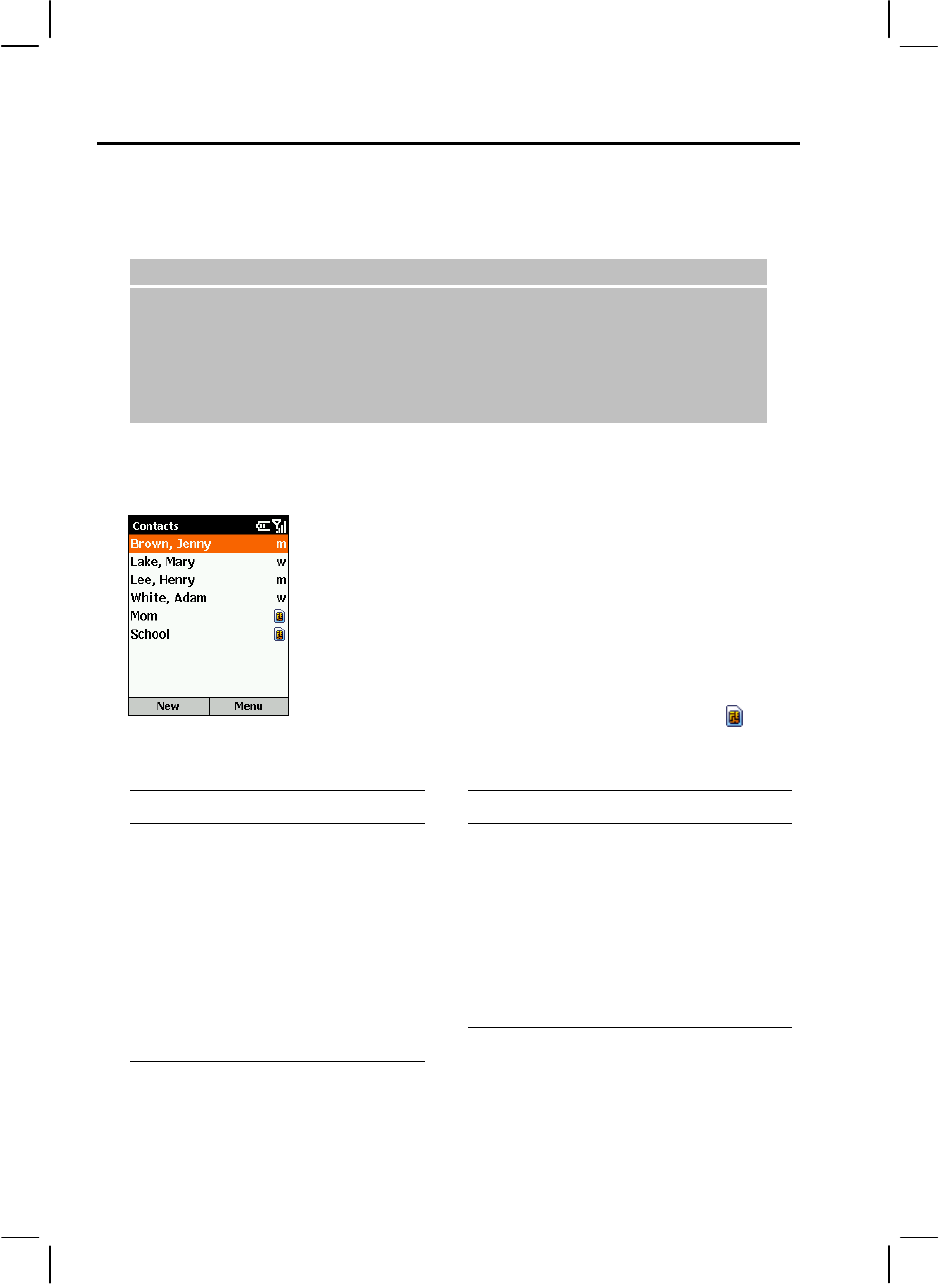
90
6.1 Contacts
You can think of Contacts as an address book, where you store information about people and
businesses with whom you communicate. You can specify a special ring tone for the
Smartphone to use when the contact calls. You can use Contacts to dial phone numbers and
compose e-mail and SMS messages directly from a contact card.
|NOTE}
On your Smartphone, there can be two kinds of independent contact lists. One
is stored in the Smartphone’s memory by Microsoft Contacts; the other is
stored in the SIM card.
Your Smartphone needs time to read the data stored in the SIM card.
Therefore, it may take 1 ~ 2 minutes for data refreshing to finish after the Home
screen displays when the Smartphone turns on or the SIM card unlocks.
Viewing Contacts
Contact List
On the Home screen, press the Start soft key and select Contacts
to access the contact list. If the right soft key is Contacts, you can
press the soft key to access the contact list.
The contact list displays the names of your contacts alphabetically.
Beside each name in the contact list is an abbreviation for the
default communication method, such as the person’s work phone
number (w) or home phone number (h). If the contact information
includes a work phone number, your Smartphone automatically set
it as the default number.
If there are phone numbers stored in your SIM card, the entries will
be displayed at the end of the list, with a SIM card icon
following the name.
The following table shows the possible abbreviations in the contact list and their meanings.
Abbreviation Meaning Abbreviation Meaning
w Work phone rdo Radio phone
w2 Second work phone e E-mail address
h Home phone e2 Second e-mail address
h2 Second home phone e3 Third e-mail address
m Mobile phone txt Text message number
pgr Pager
web Web page
car Car phone
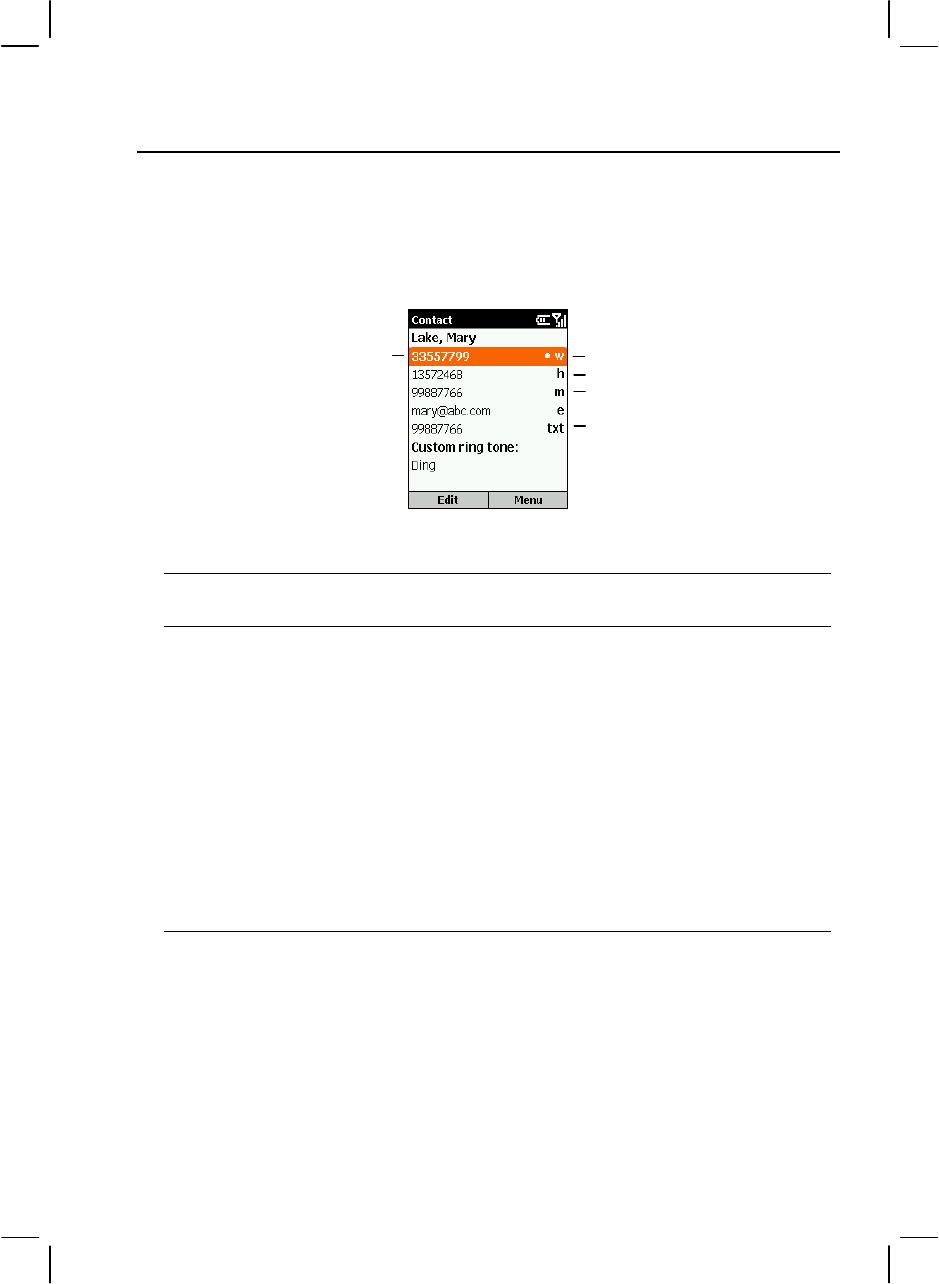
91
Contact Cards
When you scroll to a contact and press the Navigation stick, a contact card appears and
displays all of the information that you have entered for the contact, such as the name of the
person or business, phone numbers, e-mail addresses, and more.
From a contact card, press the Menu soft key to access the following commands:
Contact Card
Menu Description
Add Speed Dial Enables you to create a shortcut to a selected phone number or e-mail
address. (See section 3.6 for more information.)
Send Text
Message
Sends a text message to a selected phone number or e-mail address.
(See section 5.4 for more information.)
Save to SIM Saves a selected phone number to the SIM card.
Set as Default Makes the selected phone number or e-mail address the default
communication method for the contact.
Beam Contact Sends the contact card to another mobile device or a desktop computer
using infrared.
Delete Removes the contact card from the contact list.
Edit Enables you to modify information in the contact card.
Work number
Mobile number
E-mail address
Text message number
Number in bold denotes
default number.

92
Creating a New Contact
1. On the Home screen, press the Start soft key and select Contacts. If the right soft key on
the Home screen is Contacts, you can also press the soft key.
2. Do one of the following:
• To save the contact to your Smartphone as a regular contact, press the New soft key.
You can also press the Menu soft key and select New Contact
• To save the contact to your SIM card as a SIM contact, press the Menu soft key and
select New SIM Contact.
3. Enter the information for the new contact.
4. When completed, press the Done soft key.
|NOTE}
Unlike regular contact cards, you can store only one phone number for each
SIM contact.
When you create a new contact on your Smartphone, you can synchronize
Contacts with your desktop computer or a server to keep your contact
information up-to-date in all locations.
Deleting a Contact
1. On the Home screen, press the Start soft key and select Contacts. If the right soft key on
the Home screen is Contacts, you can also press the soft key.
2. Scroll to the contact to delete.
3. Press the Menu soft key and select Delete.
4. Press the Yes soft key.
Finding a Contact
1. On the Home screen, press the Start soft key and select Contacts. If the right soft key on
the Home screen is Contacts, you can also press the soft key.
2. Entering the name to search is a convenient method to find a contact. When you press the
number key to enter the letters, the matched contact will appear on the screen. If you have
set up the contact category, you can filter the contacts by pressing the Menu soft key, and
selecting Filter, then Business, Miscellaneous or Personal.

93
|NOTE}
While in the contact list, you can scroll up/down to a contact, but you cannot
scroll left/right to go to the previous/next page.
Editing a Contact
When you open a contact card, press the Edit soft key to edit the contact’s information. When
the editing is completed, press the Done soft key.
Selecting a Ring Tone for a Contact
You can select different ring tones for different contacts to easily identify the callers.
1. On the Home screen, press the Start soft key and select Contacts. If the right soft key on
the Home screen is Contacts, you can also press the soft key.
2. Select the contact for which to select a ring tone.
3. Press the Edit soft key.
4. Scroll to Custom ring tone, and push the Navigation stick left/right to select a ring tone.
You can also select from a full list by pressing the Navigation stick.
5. Press the Done soft key.
Copying Phone Numbers from SIM Card to Contacts
1. On the Home screen, press the Start soft key and select Contacts. If the right soft key on
the Home screen is Contacts, you can also press the soft key.
2. Scroll to the SIM card contact and press the Navigation stick to open the contact card.
3. Press the Menu soft key and select Save to Contacts. The contact list appears on the
screen with New Item highlighted. Press the Select soft key.
4. Scroll to the field to place your number (e.g. business phone, mobile phone, or home
phone). Press the Insert soft key to paste the number in the field.
5. Enter the information into the other fields as necessary.
6. Press the Done soft key, then the Back key to return to the contact list.

94
Copying Phone Numbers from Contacts to SIM Card
1. On the Home screen, press the Start soft key and select Contacts. If the right soft key on
the Home screen is Contacts, you can also press the soft key.
2. Scroll to the SIM card contact and press the Navigation stick to open the contact card.
3. Scroll to the phone number you want to copy.
4. Press the Menu soft key and select Save to SIM. The SIM Contact screen appears.
5. If necessary, modify the name of the contact.
6. Press the Done soft key, then the Back key to return to the contact list.
Calling a Contact
Using the Default Number
1. On the Home screen, press the Start soft key and select Contacts. If the right soft key on
the Home screen is Contacts, you can also press the soft key.
2. Select the contact to call.
3. Press the Talk key .
|NOTE}
If you have a long list of contacts and you don’t see the contact you want to call
on the first screen, enter the first few letters of the contact’s name. The
Smartphone will search through the entire contact list and display the name.
Using a Number Other Than the Default Number
1. On the Home screen, press the Start soft key and select Contacts. If the right soft key on
the Home screen is Contacts, you can also press the soft key.
2. Select the contact to call, and change the abbreviation for the number by pushing the
Navigation stick left/right.
3. Press the Talk key .
|NOTE}
Selecting another abbreviation changes the default number of this contact.

95
Calling a Contact from a Contact Card
When you open a contact card, select the phone number you want and press the Talk key
to dial the number.
Sending a Message from a Contact Card
When you open a contact card, select the e-mail address or text phone number you want and
press the Navigation stick to open Messaging for entering your message.
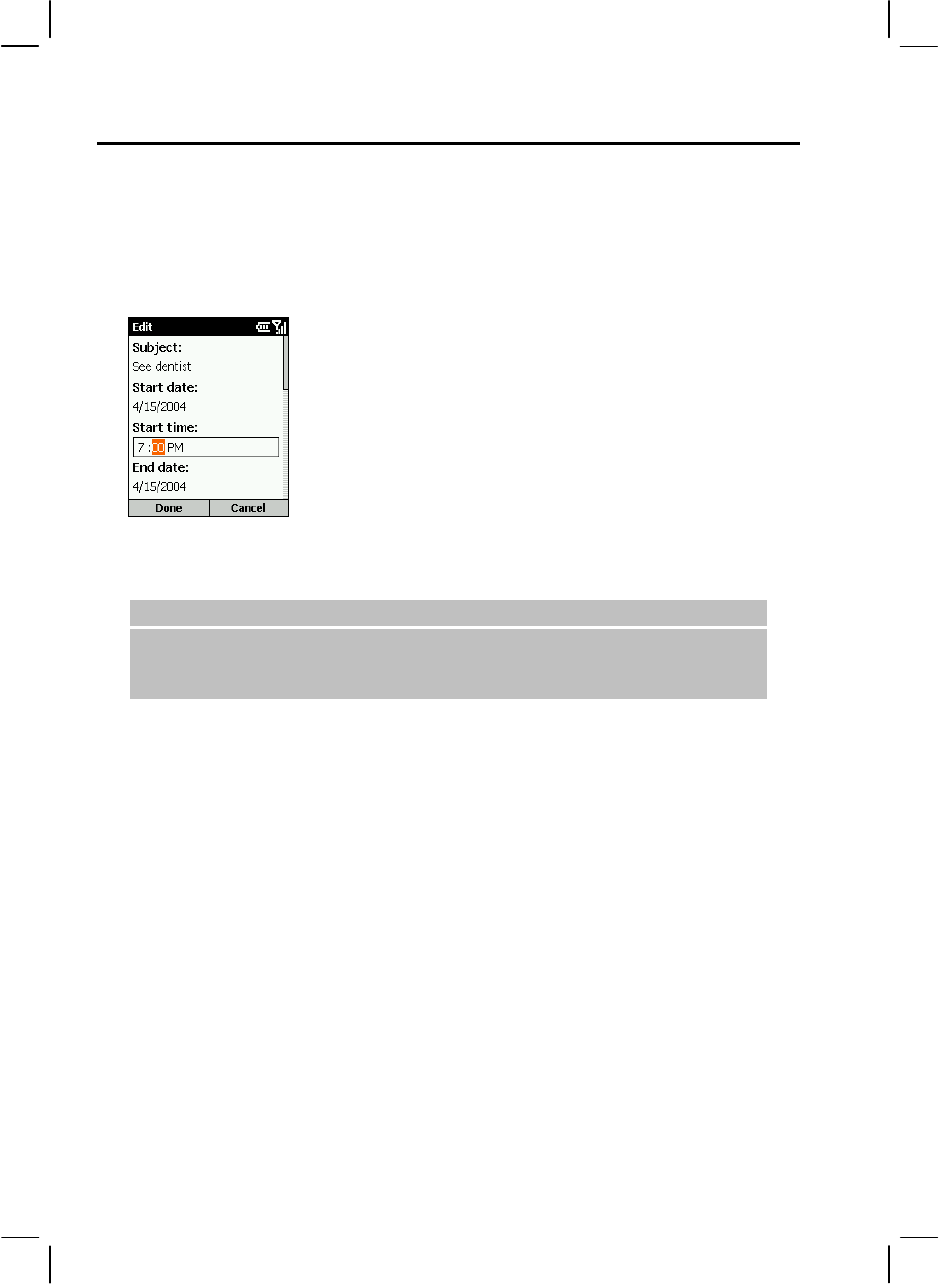
96
6.2 Calendar
Calendar is the scheduling program on your Smartphone, where you can create and view
appointments and view your calendar by day, week, or month. When you create and edit
appointments in Calendar, your changes are reflected in Outlook on your desktop computer
when you synchronize.
Creating a New Appointment
1. On the Home screen, press the Start soft key and select
Calendar.
2. Press the Menu soft key and select New.
3. Enter information in the fields displayed. (For information
on entering text, see section 2.3.)
4. To set a reminder for the appointment, under Reminder,
select the amount of time before the appointment that you
want the reminder to appear.
5. When completed, press the Done soft key.
|NOTE}
When you create a new appointment on your Smartphone, you can
synchronize Calendar with your desktop computer or a server to keep your
schedule information up-to-date in all locations.
Viewing an Appointment
1. On the Home screen, press the Start soft key and select Calendar.
2. Scroll to the appointment to open and press the Navigation stick. The screen displays the
appointment details.
Editing an Appointment
1. On the Home screen, press the Start soft key and select Calendar.
2. Select the appointment to edit.
3. Press the Edit soft key.
4. Make the changes, and press the Done soft key.
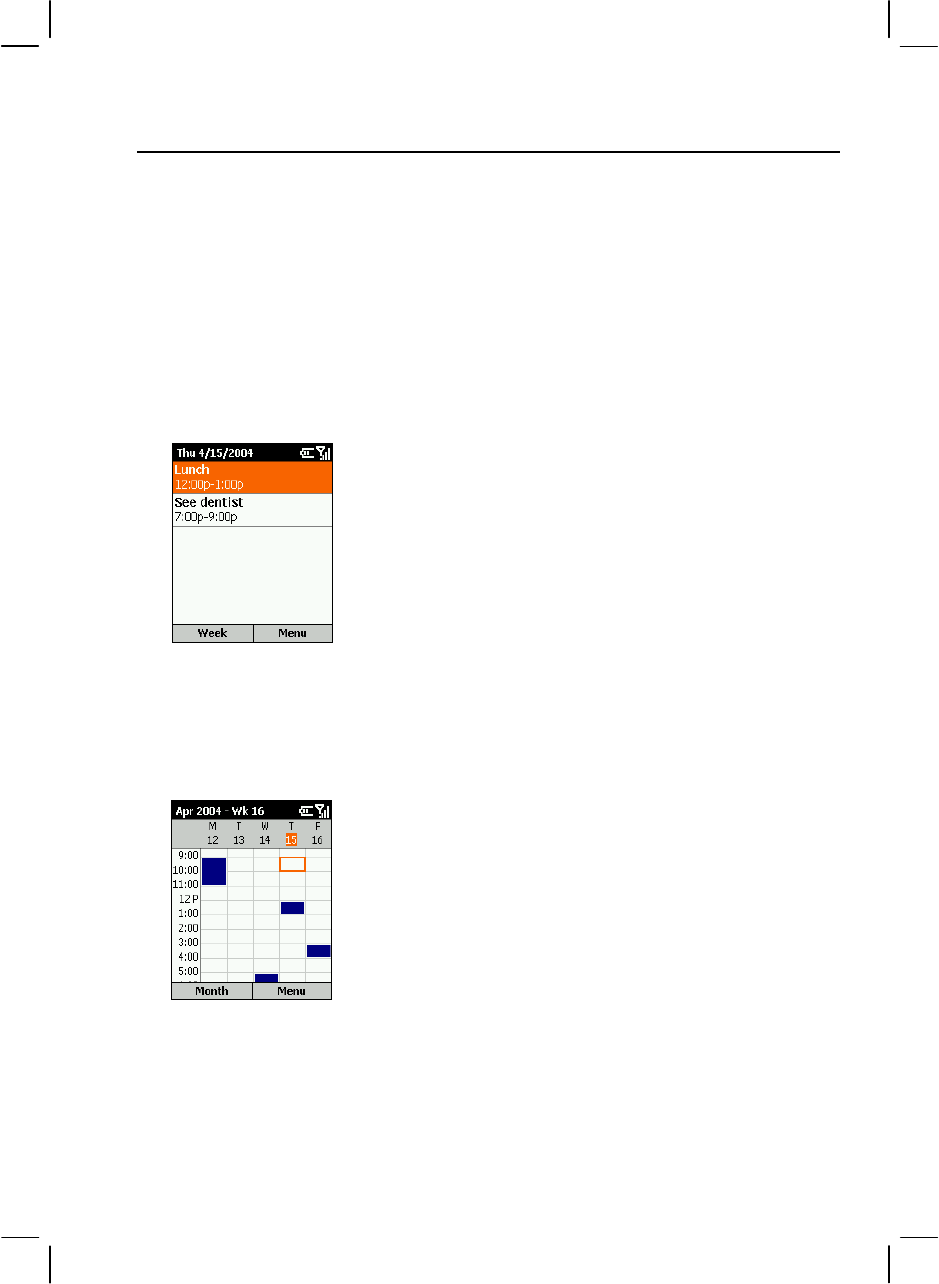
97
Deleting an Appointment
1. On the Home screen, press the Start soft key and select Calendar.
2. Scroll to the appointment to delete, press the Menu soft key, and select Delete.
Viewing Your Schedule
You can view your schedule using three different views: Agenda, Week, and Month.
Agenda View
The Agenda View in Calendar is the default view for calendar
information. To change to Agenda View from another view, press
the Menu soft key and select Agenda View.
This view displays meetings and appointments scheduled for the
current day. The appointments are shown in chronological order
according to start time. All-day appointments are shown as a
single line at the top of the Agenda view. Up to three all-day
events will be displayed.
To look at your agenda for previous or approaching dates, push
the Navigation stick left/right.
To view your agenda for a specific date, press the Menu soft key
and select Go to Date. Enter the date you want to view, and press
the Done soft key.
Week View
To view appointments for the week, press the Menu soft key and
select Week View.
The Week view shows your schedule for the specified week. This
view allows you to get a quick indication of your free and busy
time, and allows you to create an appointment at a selected time
easily.
The Week view displays the hours from 9:00 A.M. to 5:00 P.M.
in one-hour increments by default on the left side of the screen.
You can scroll up or down to show the hours before or after those
displayed.
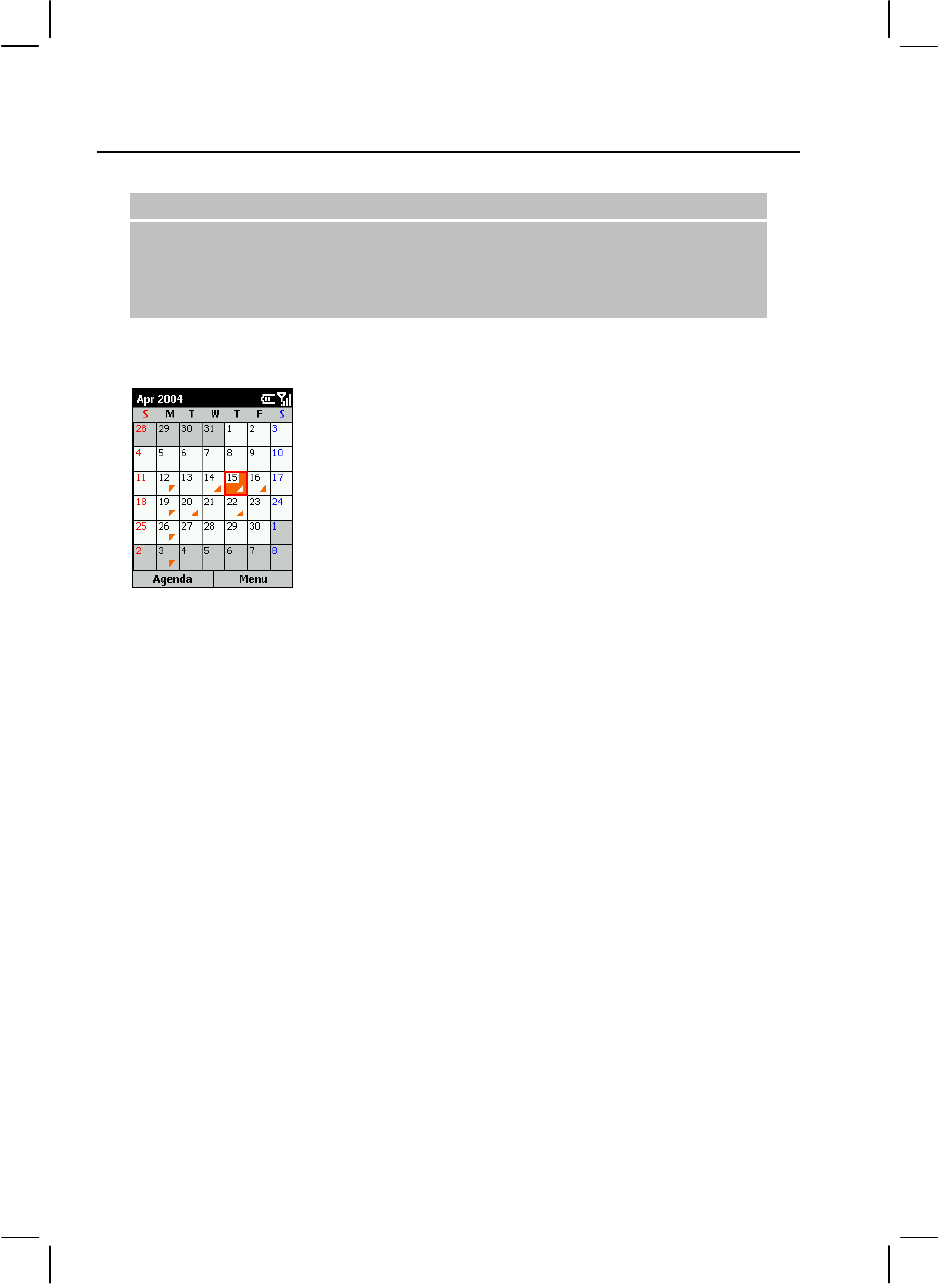
98
|NOTE}
If you scroll up/down and leave Week view, the hours last shown will be
displayed the next time you return to Week view.
To change settings for Week View, press the Menu soft key and select
Options.
Month View
To view your schedule for the month, press the Menu soft key
and select Month View.
The Month view provides an overview of your monthly schedule
with arrow indicators for morning and afternoon appointments.
The arrows pointing upward represent morning appointments,
and the arrows pointing downward represent afternoon
appointments. An all-day event is indicated by a box inside the
calendar day.
Importing Calendar Information
You can import calendar information from another calendar program if it uses the iCal or vCal
format. The calendar information can be imported from attachments in e-mail messages, links
in Microsoft® Pocket Internet Explorer, or by infrared.

99
6.3 Tasks
A task is a personal or work-related project, assignment, or errand
to track through completion. A task can occur once or repeatedly.
A recurring task can repeat at regular intervals or repeat based on
the date you mark the task complete. For example, you might
want to pay a bill on the last Friday of every month, or get a
haircut when one month has passed since your last haircut.
Creating a New Task
1. On the Home screen, press the Start soft key and select Tasks.
2. Scroll to the Enter new task here field and enter the task. (The input mode is
automatically switched to T9. For information on entering text, see section 2.3.)
3. When completed, press the Navigation stick.
|NOTE}
When you create a new task on your Smartphone, you can synchronize tasks
with your desktop computer to keep your Tasks list up-to-date in both
locations.
If you create a new task with a reminder on your desktop computer, you can
synchronize tasks with your Smartphone to hear the reminder on your
Smartphone.

100
Viewing the Task List
On the Home screen, press the Start soft key and select Tasks to view the task list.
The following table lists the available functions from the task list:
To… Do this…
Mark a task as complete Scroll to the task and press the Complete soft key. A check
mark appears to indicate that the task is completed.
Change a completed task to
incomplete
Scroll to the task and press the Activate soft key. The check
mark disappears to indicate that the task is not completed.
Delete a task from the task
list
Scroll to the task and press the Delete soft key.
|NOTE}
If you synchronize tasks with your desktop computer, completed tasks are
removed from your Smartphone during synchronization. They are then
displayed in gray with a strikethrough on your desktop computer.

101
6.4 Voice Notes
Voice Notes are used to create short voice recordings.
|NOTE}
Your Smartphone does not support recording during a call.
Creating a Voice Note
1. Do one of the following to open Voice Note:
• Press and hold the Volume Up key.
• On the Home screen, press the Start soft key and select Voice Notes.
2. Hold the Smartphone microphone near your mouth.
3. Press the Record soft key to begin recording your voice note.
4. Press the Stop soft key to stop recording your voice note.
5. The voice note is recorded and appears in the All Notes list of Voice Notes. The voice
notes are named consecutively (Recording 1, Recording 2, and so on).
|NOTE}
To rename a recording, press the Menu soft key and select Rename.
Listening to a Recording
1. Do one of the following to open Voice Note:
• Press and hold the Volume Up key.
• On the Home screen, press the Start soft key and select Voice Notes.
2. Scroll to the recording you want to listen to.
3. Press the Navigation stick. Or, press the Menu soft key and select Play.

102
6.5 Beaming Information
You can use the infrared port on your Smartphone to send and receive (beam) calendar
appointments and contact cards between your Smartphone and another mobile device or a
desktop computer that has an infrared port and supports VCards and VCal.
Beaming a Contact or an Appointment
1. Open the Contacts or Calendar program.
2. If you want to beam a contact’s information, scroll to the contact in the contact list. If you
want to beam an appointment, scroll to the appointment and press the Navigation stick.
3. Press the Menu soft key, and select Beam Contact or Beam Appointment.
4. Align the infrared ports so that they are unobstructed and within close range (5 ~ 30 cm)
of each other.
5. Press the Beam soft key to start transmitting. Status information will then be displayed,
indicating the name of the device your Smartphone is beaming to, and whether the
beaming process is pending, done, or has failed.
Receiving Beamed Information
1. On the Home screen, press the Start soft key and select Settings Beam.
2. Select Receive incoming beams and press the Done soft key.
3. Align the infrared ports so that they are unobstructed and within close range of each other.
4. Your Smartphone will search the device sending information. Press the Yes soft key to
start receiving information.
|NOTE}
Once you select Receive incoming beams, your device automatically
receives beams until you clear this check box.
Your Smartphone can receive beamed files of any type, but you may need to
copy some files to your desktop computer for viewing.

103
7 ActiveSync
This chapter introduces the basic features of Microsoft® ActiveSync® technology. It
describes how to use ActiveSync for synchronizing information on your Smartphone with
your desktop computer and/or a server running Microsoft® Exchange® Server.
For detailed information about using ActiveSync, see ActiveSync Help on your desktop
computer.

104
7.1 Understanding ActiveSync
ActiveSync synchronizes information stored on your Smartphone with Microsoft® Outlook®
information on your desktop computer or Microsoft Exchange Server. It also allows you to
share files between your Smartphone and your desktop computer.
When you synchronize, ActiveSync compares the information on your Smartphone with the
information on your desktop computer and/or Exchange Server and updates all locations with
the most recent information.
With ActiveSync, you can:
Synchronize Outlook e-mail, Contacts, Calendar, and Tasks information on your
Smartphone with your desktop computer.
Synchronize Outlook e-mail, Contacts, and Calendar on your Smartphone with the
Outlook information on a server running Microsoft Exchange Server so that you have the
latest information, even when your desktop computer is turned off. You can synchronize
with an Exchange server if your company or service provider is running Microsoft
Exchange Server with Exchange ActiveSync. You can synchronize Tasks information
with your desktop computer, but not with a server.
Copy (rather than synchronize) files between your Smartphone and your desktop
computer.
Synchronize on a schedule to control when synchronization occurs.
Select which types of information are synchronized and specify how much information is
synchronized. For example, you can choose how many weeks of past appointments to
synchronize.

105
7.2 Setting up ActiveSync
Creating a Partnership
|NOTE}
For information on installing ActiveSync, see section 1.5.
As soon as ActiveSync installation completes, the New Partnership Wizard automatically
starts. This wizard helps you set up a partnership between your Smartphone and your desktop
computer or with an Exchange server.
When you create a partnership, you specify your synchronization settings; for example, the
type of information to synchronize, whether or not to synchronize with both your desktop
computer and an Exchange server. Once a partnership is set up, ActiveSync on your desktop
computer recognizes your Smartphone when you connect it, and automatically applies the
synchronization settings you specified.
When you finish using the wizard, the first synchronization begins automatically. When
synchronization completes, you will notice that the information from your desktop computer
or Microsoft Exchange Server that you selected now appears on your Smartphone.
Configuring an Exchange Server Connection
You can use the New Partnership Wizard when you are first setting up a partnership with a
desktop computer to synchronize with an Exchange server. If you did not set up the
Smartphone to synchronize with an Exchange server when you set up your partnership, this
section describes how to configure wireless synchronization with an Exchange server on your
Smartphone.
If at some later time you want to synchronize with a server when the Smartphone is connected
to the desktop computer, you must then configure ActiveSync on the desktop computer as
described in “Synchronize with a server” in ActiveSync Help on the desktop computer.
You can edit the connection later to stop synchronizing a particular type of information or to
change how much information is synchronized. All of these settings can also be configured
using ActiveSync on the desktop computer when the Smartphone is connected to the desktop
computer by a USB or infrared connection.
To configure an Exchange server connection:
1. Obtain the following Exchange Server information from your service provider or system
administrator:
• The name of the server and the server domain name.
• Your Exchange user name and password to synchronize with an Exchange server.
2. If your Smartphone is connected to your desktop computer, disconnect it.
3. On the Home screen, select Start.

106
4. Select ActiveSync.
5. Select Menu and then Options.
6. Select Server Settings.
7. Select Connection.
8. In User name, enter your Microsoft Exchange user name.
9. In Password, enter your Microsoft Exchange password.
10. In Domain, enter the name of the domain of your Exchange server (if required).
11. If you want the Smartphone to save your password so that you need not enter it when
connecting, select Save password.
12. If configuring a Server Name, enter name of your Exchange server.
13. Select Done.
Changing ActiveSync Settings Later
To change ActiveSync settings for synchronizing with a desktop computer:
If you want to change ActiveSync settings for synchronizing with a desktop computer, use
ActiveSync on the desktop computer. For more information, see “Modifying the Amount of
Information Synchronized” in ActiveSync Help on the desktop computer.
To change ActiveSync settings for synchronizing with your Exchange server:
1. On the Smartphone Home screen, select Start.
2. Select ActiveSync.
3. Select Menu and then Options.
4. Select Server Settings.
5. Select the synchronization settings to edit: Calendar, Contacts, or Inbox.
6. Do one of the following:
• To start synchronizing Calendar, Contacts, or Inbox information, select Sync
[Information Type] with a server on the appropriate synchronization settings page.
• To stop synchronizing Calendar, Contacts, or Inbox information, clear the Sync
[Information Type] with a server check box on the appropriate synchronization
settings page.
• Change the amount of information to be synchronized.
7. Select Done.

107
|NOTE}
Before you change synchronization settings, disconnect the device from your
desktop computer.
Creating a Synchronization Schedule
To create a synchronization schedule with your desktop computer:
To set up a synchronization schedule with your desktop computer, you must use ActiveSync
on the desktop computer. For instructions, see “Change desktop synchronization schedule” in
ActiveSync Help on the desktop computer.
To create a synchronization schedule with an Exchange server:
To set up a synchronization schedule with an Exchange server, you must use ActiveSync on
your Smartphone. You can schedule synchronization of your device on two separate
schedules. Use the peak times schedule to synchronize during working hours or other times
you experience higher mail volumes. Use the off-peak schedule to synchronize during times
when you experience lower mail volumes. When you are roaming, you can synchronize
manually to reduce roaming charges, or you can synchronize using the mobile schedules.
1. On the Smartphone Home screen, select Start.
2. Select ActiveSync.
3. Select Menu and then Options.
4. Select Mobile Schedule.
• Select how often to synchronize in the Peak time sync list.
• Select how often to synchronize in the Off-peak time sync list.
• Select whether or not to synchronize on a schedule in the Roaming sync list.
• Select Sync outgoing items as they are sent to synchronize every time you send
e-mail.
5. Select Done.
|NOTE}
To edit schedule settings, your Smartphone must be disconnected from your
desktop computer.
If you create a schedule for synchronizing while connected to a desktop
computer as well as a schedule for synchronizing remotely (wirelessly), the
Smartphone synchronizes according to both schedules.

108
Synchronizing Automatically
With ActiveSync you can schedule automatic synchronization between your device and a
server every time an item arrives or is changed at the server. Your device is informed of that
event and synchronizes automatically to retrieve those items, making your device always
up-to-date. You must synchronize your device at least once (such as after creating a
partnership) before you can see and change the settings for synchronization as items arrive.
|NOTE}
You can synchronize as items arrive only if your company or service provider is
running Microsoft Exchange Server with Exchange ActiveSync.
To set up a schedule to synchronize automatically:
1. On the Smartphone Home screen, select Start.
2. Select ActiveSync.
3. Select Menu and then Options.
4. Select Mobile Schedule.
5. Set Peak time sync and/or Off-peak time sync to As items arrive.
6. Select Done.
To set up the device address:
1. On the Smartphone Home screen, select Start.
2. Select ActiveSync.
3. Select Menu and then Options.
4. Select Server Settings.
5. Select Connection.
6. Do one of the following:
• Scroll to Text Message Address and enter the address that identifies your device on
the network. This is the same address that other Internet users use to send text
messages to your device.
• If your company has instructed you to use a pre-defined service provider profile,
scroll to Service Provider, and select the service provider name. Then, enter your
device phone number, if necessary, in Device Phone Number. If you do not want to
use the provider profile, under Address device using, select Other. Then enter the
text message address for your device in Text Message Address.
7. Select Done twice.

109
|NOTE}
To edit settings on the Smartphone, disconnect it from your desktop computer.

110
7.3 Synchronizing Information
Starting and Stopping Synchronization
Once you have set up ActiveSync, you can synchronize information at any time by using
ActiveSync on the Smartphone.
1. On the Home screen, select Start.
2. Select ActiveSync.
3. To start synchronization, select Sync.
4. To stop synchronizing, select Stop.
Synchronization Methods
In addition to the USB connection already described in section 1.5, you have other options for
synchronizing your information. You can use:
Infrared connection
Remote synchronization
Synchronizing by Using an Infrared Connection
You can connect your Smartphone to another mobile device or your desktop computer by
using an infrared connection. This method is ideal for changing quickly between multiple
devices because there are no cables or adapters to connect.
For more information about synchronizing by using an infrared connection or other
connection types, see ActiveSync Help on your desktop computer.
Configuring Remote Synchronization
You can synchronize remotely with your desktop computer, or with an Exchange server.
Remote synchronization is when your device is synchronizing over a wireless connection
instead of using a direct local connection to a desktop computer. Synchronizing remotely with
your desktop computer may depend on your network configuration. For example, you may
need to set up a virtual private network (VPN) connection to your network.
To synchronize remotely you must configure your Smartphone as described in the following
procedure. You will also need to set up a connection. For information about setting up a
connection, see “Data Connections” in section 4.1. Then you will be ready to synchronize
your information.

111
To configure remote synchronization with a desktop computer:
1. On the Home screen, select Start.
2. Select ActiveSync.
3. Select Menu and then Options.
4. Select PC Settings.
5. In Use, scroll to the computer name.
6. Select or clear Use mobile schedule to sync with this PC.
7. Select or clear Sync with this PC during manual sync.
8. Select Done twice.
|NOTE}
To synchronize remotely with a desktop computer, the desktop computer must
be turned on.

112
7.4 Deciding Which Information to
Synchronize
By default, ActiveSync does not automatically synchronize all types of Outlook information.
You can use ActiveSync options to turn synchronization for specific information types on and
off. Items that you synchronize with Microsoft Exchange Server cannot also be synchronized
with Outlook on a desktop computer.
Synchronizing Outlook E-mail
When you select Inbox for synchronization in ActiveSync, e-mail messages are synchronized
as part of the general synchronization process. During synchronization, the following events
occur:
Messages are copied from the Outlook Inbox folder on your desktop computer, or from
Microsoft Exchange Server, to the Inbox folder of the Outlook E-mail account on your
Smartphone.
By default, when synchronizing your Outlook E-mail account with your desktop
computer or Microsoft Exchange Server, you receive only messages from the last three
days and the first 500 bytes of each new message.
The messages on your Smartphone and on your desktop computer are linked. When you
delete a message on your Smartphone, it is deleted from your desktop computer the next
time you synchronize, and vice versa.
Messages in subfolders of other Outlook e-mail folders are synchronized only if the
folders have been selected for synchronization in your Outlook E-mail account on your
Smartphone.
|NOTE}
Text messages are not received in Messaging through synchronization.
Instead, they are sent to your Smartphone by way of your service provider.
Synchronizing Calendar
Calendar items stored on your Smartphone can be synchronized with calendar items stored on
your desktop computer or on a Microsoft Exchange server. By default, Calendar items from
the last two weeks are synchronized.
Calendar items created on your Smartphone are copied to your desktop computer and/or
server during synchronization, and vice versa. Similarly, Calendar items that are deleted from
your Smartphone are deleted from your desktop computer and/or server during
synchronization, and vice versa.

113
Synchronizing Contacts
Contacts stored on your Smartphone can be synchronized with contacts stored on your
desktop computer or on a Microsoft Exchange server. By default, all of your contacts are
synchronized.
Contacts created on your Smartphone are copied to your desktop computer and/or server
during synchronization, and vice versa. Similarly, contacts that are deleted from your
Smartphone are deleted from your desktop computer and/or server during synchronization,
and vice versa.
Synchronizing Tasks
Tasks stored on your Smartphone can be synchronized with tasks stored on your desktop
computer. Task synchronization is automatically selected in ActiveSync. By default, all of
your incomplete tasks are synchronized.
Tasks created on your Smartphone are copied to your desktop computer during
synchronization, and vice versa. Similarly, tasks that are deleted from your Smartphone are
deleted from your desktop computer during synchronization, and vice versa.
|NOTE}
Tasks can be synchronized only with your desktop computer; they cannot be
synchronized with a server running Microsoft Exchange Server.

114
7.5 ActiveSync Error Messages
If your information cannot be successfully synchronized, you will see an error message on
your Smartphone. To help troubleshoot the problem, you can view more information about
the error.
When an error message is displayed, scroll to it and press the Navigation stick to view
information about the ActiveSync error.
|NOTE}
Some errors interfere with automatic synchronization. If you suspect that a
scheduled synchronization has not occurred, you should attempt to manually
synchronize your information. Successfully completing manual
synchronization resets automatic synchronization. For more information, see
“Synchronizing Information” in ActiveSync Help on your desktop computer.

115
8 Internet, Entertainment,
and More
This chapter explains how to browse the Web using Microsoft® Pocket Internet Explorer,
play audio and video files using Microsoft® Windows Media® Player, set up a modem link,
play Solitaire, and use Calculator.
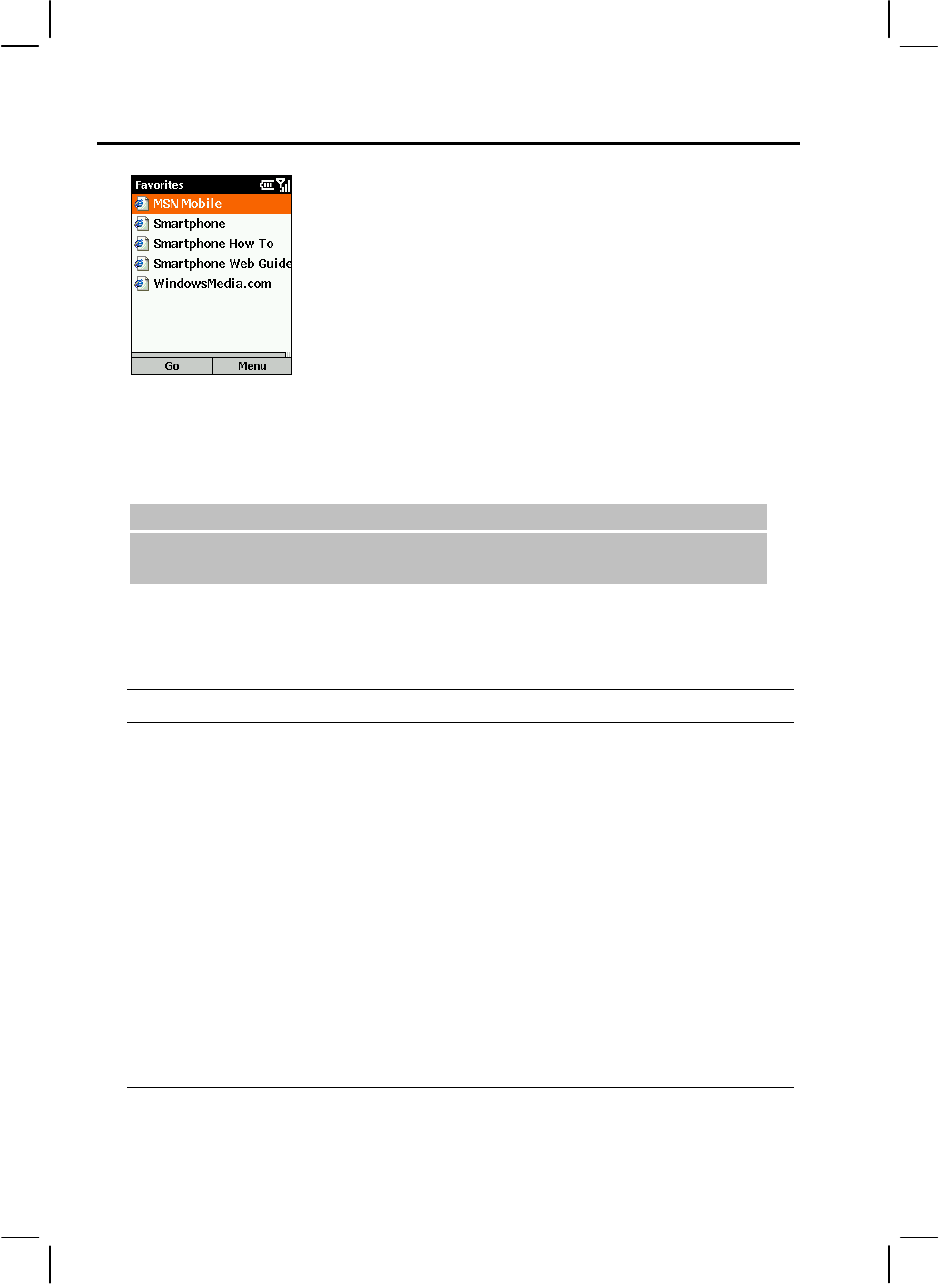
116
8.1 Internet Explorer
Using Pocket Internet Explorer, you can browse the Web on your
Smartphone. Pocket Internet Explorer on your Smartphone
supports HTML (Hypertext Markup Language), cHTML
(compact Hypertext Markup Language), and WAP (Wireless
Application Protocol). It also supports JScript, ActiveX controls,
and CSS (cascading style sheets). The browser supports images
and sounds, but it does not support frames on a Web page.
With Pocket Internet Explorer, the Favorites list is displayed as
the main screen instead of a home page, so you can easily go to
your favorite Web sites. You can add your own favorites to this
list for Web sites you frequently visit. You can view your
Favorites list from any Web page by selecting Favorites.
Browsing the Web
|NOTE}
Make sure that you have set up the Smartphone’s connection. (See “Data
Connections” in section 4.1.)
On the Home screen, press the Start soft key and select Internet Explorer to open Internet
Explorer.
After opening Internet Explorer, you can:
To… Do this…
View a favorite Select a favorite to view and press the Go soft key.
Go to a link Select a link. You can scroll vertically or horizontally to see
all available links.
Go to a Web page Press the Menu soft key and select Address Bar. Enter the
Web address and press the Go soft key.
Return to a Web page you
visited in the same session
On a Web page, press the Back key repeatedly until the
page appears.
View a list of
recently-visited Web pages
Press the Menu soft key and select Address Bar. Scroll to
View History and press the Go soft key.
Go to a Web page on the
History list
Press the Menu soft key and select Address Bar. Scroll to
View History and press the Go soft key. Scroll to the Web
page address and press the Go soft key.
Disconnect from the
Internet
Press the End key.
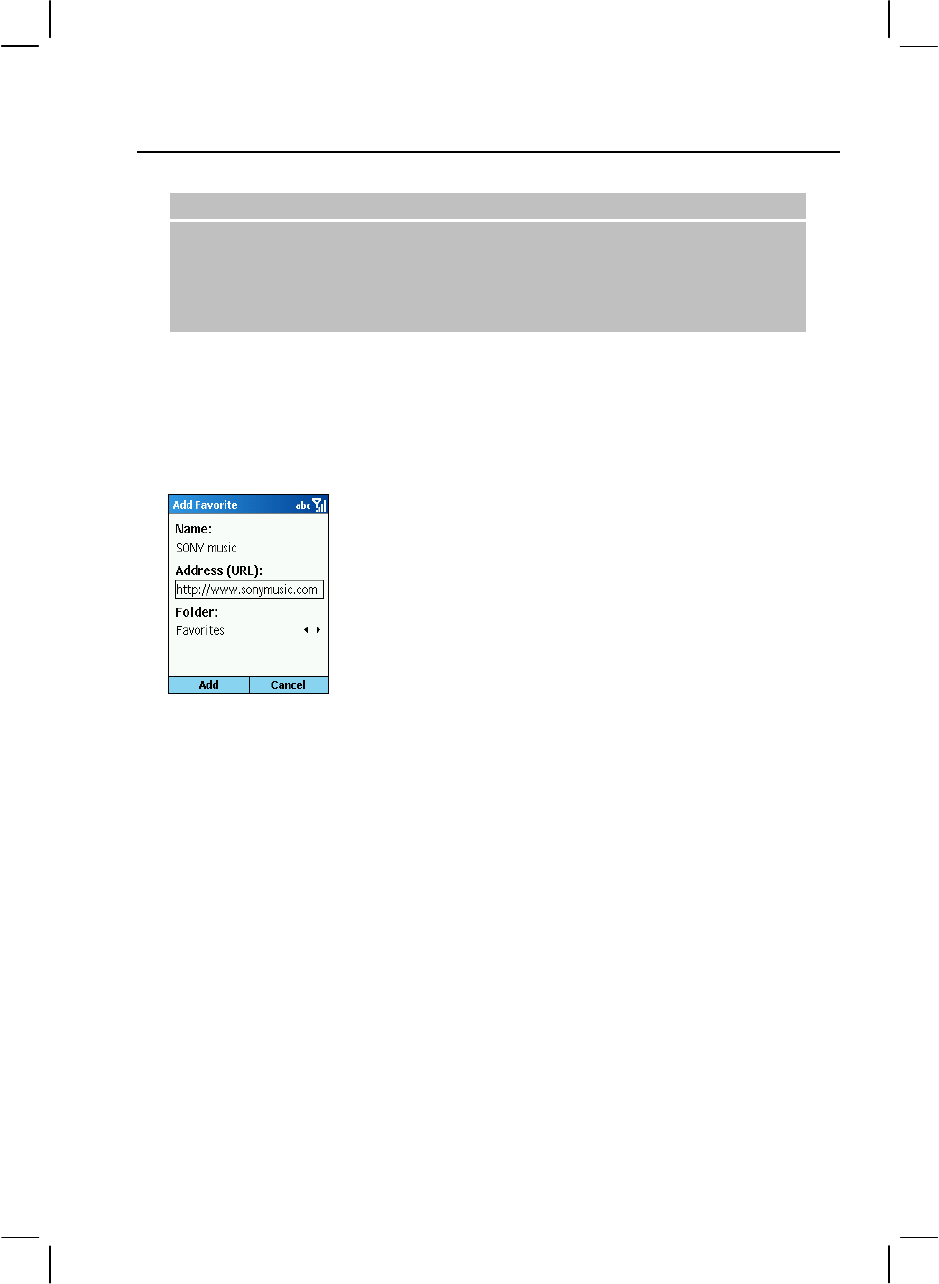
117
|NOTE}
While you are connected to the Internet, you can change between Pocket
Internet Explorer and other programs on your Smartphone by pressing the
Home key and navigating to the program you want. This does not close your
Internet connection. To return to the Web page you were viewing, press the
Back key.
Using the Favorites List
If you see a Web page you want to visit another time, mark it as a favorite. The next time you
want to visit that Web page, you can select it from your Favorites list.
To add a web page to your Favorites list:
1. Press the Menu soft key and select Add Favorite.
2. If you are already in the Web page you want, the name and
URL will appear on the screen.
If you are manually entering the information, enter the name
and URL in the input fields.
3. Press the Add soft key.
To create, delete and edit a folder in Favorites:
In Favorites, you can create, delete and edit a folder using the Menu commands.
Refreshing Web Pages
The Smartphone caches the Web pages that you view and stores them until the cache is full. It
then replaces the oldest pages with new pages. If you go to a page that is cached on your
Smartphone, you see the stored version unless you refresh the page to see the latest version.
Press the Menu soft key and select Refresh to see the latest Web content for that page.

118
Customizing Pocket Internet Explorer
You can customize Web browsing options, change the network to connect to, and make more
memory available on your Smartphone by clearing stored cookies and Web pages.
In Internet Explorer, press the Menu soft key and select Options. You can set up the
following options:
Pocket Internet
Explorer
Options
Sub Item Description
Show pictures To display graphics on Web pages
Play sounds To play sounds on Web pages
Warn when
changing to an
unsecure page
To warn when moving from a secure to a
non-secure Web page
Allow cookies To allow Web sites to download cookies to
your Smartphone
General
Language To select the alphabet to use
Automatically
detect settings
To automatically detect network settings Connections
Select network To select the network to which Internet
Explorer should connect if you did not select
Automatically detect settings.
Temporary Files To clear Web pages from the cache. (When you
do this, you will no longer be able to view these
cached Web pages offline. You will need to
connect to the Internet and go to the page. This
downloads a new file to the cache, so you can
again view the page offline.)
Cookies To clear stored cookies. This deletes personal
information about you that is stored for use by
various Web sites.
Memory
History To clear History files.
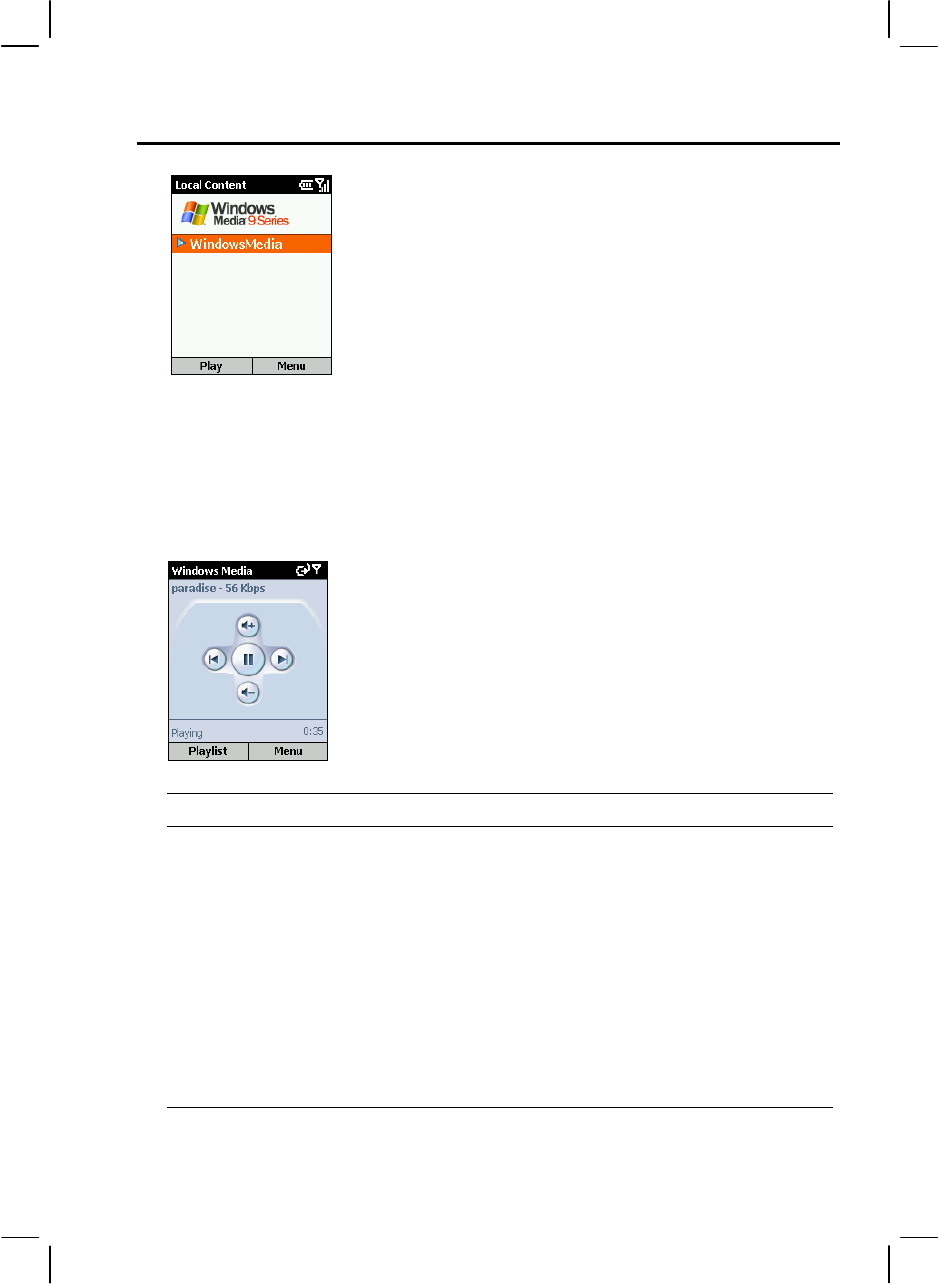
119
8.2 Media Player
Using Microsoft® Windows Media® Player, you can play
Windows Media Audio (WMA) files, Windows Media Video
(WMV) files, and MP3 audio files on your Smartphone. You can
also copy digital music and video directly from your desktop
computer to your Smartphone by using either Windows Media
Player or Microsoft® ActiveSync® technology.
For more information about copying files by using Windows
Media Player, see the topics on copying files to a portable device
in Windows Media Player Help on your desktop computer. For
more information about copying files by using ActiveSync, see
“Copying and Moving Files” in ActiveSync Help on your
desktop computer.
Windows Media Player is easy to use; the controls are similar to the buttons on a compact disc
player. You can play audio or video files, skip to another song or video, and increase or
decrease the volume.
Playing Video and Audio Files
1. On the Home screen, press the Start soft key and select
Windows Media. You will see the Local Content screen. If
you are operating in Playback mode, press the Playlist soft
key to go to Local Content screen.
2. If you have copied the files to the \Storage\My Documents
folder of your Smartphone, you will see a list of the files on
the screen. Select the file you want and press the Play soft
key to start playing.
3. You can do the following when playing a file.
To… Do this…
Play or pause the playback of the
current file
Press the Navigation stick.
Skip to the beginning of the current
file
Push the Navigation stick left.
Skip to the beginning of the previous
file on the current playlist
Push the Navigation stick left twice quickly.
Skip to the next file on the current
playlist
Push the Navigation stick right.
Adjust the volume Use the Volume control or push the Navigation
stick up or down to increase or decrease the
volume.
(To be continued)
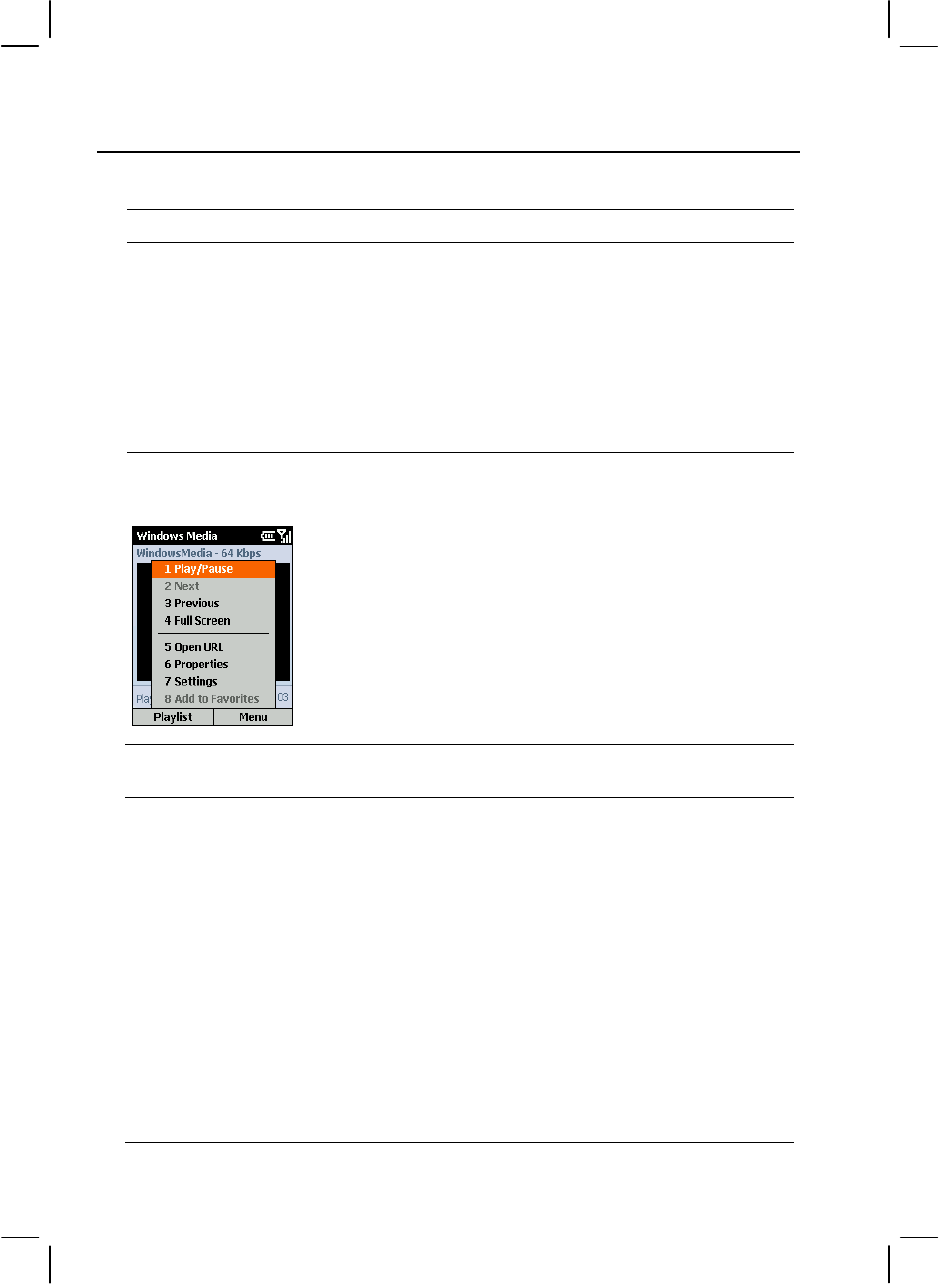
120
(Continued)
To… Do this…
Play a streaming media file on a
network
Press the Menu soft key and select Open URL.
Enter the Web URL and press the Play soft key.
Play files randomly Press the Menu soft key and select Settings. Select
Shuffle and press the Done soft key.
Play files repeatedly Press the Menu soft key and select Settings. Select
Repeat and press the Done soft key.
Stop playback while using another
program
Press the Menu soft key and select Settings. Select
Background play and press the Done soft key.
Using Menu Commands When Playing a File
When you are playing a file, you can use the menu commands to
start and pause playback, skip to the next or previous file, displa
y
information about a file, change volume and playback settings, o
r
add files to your Favorites.
Press the Menu soft key to access the menu commands. The
following table lists the menu commands and their functions that
are available when you play a file.
Menu When Playing
a File
Description
Play/Stop Plays or stops the playback of the current file.
Next Skips to the next file on the current playlist. This command is not
available if the last file is the current selection.
Previous Skips to the beginning of the current file on the current playlist. If
no file is playing, this command skips to the previous file on the
current playlist.
Open URL Plays a streaming media file on a network (for example, content
streamed from an Internet radio station).
Properties Displays information about the file that is playing.
Settings Displays the Settings options, which enable you to adjust the
volume and various playback options.
Add to Favorites Adds the streaming media file that is playing to the Favorites
playlist.

121
Using Media Player Favorites
You can play your favorite streaming media file on the Internet and add it to Favorites. The
next time you want to listen to the file, you can select it from Favorites.
To add a streaming media file to Favorites:
1. On the Home screen, press the Start soft key and select Windows Media.
2. Press the Menu soft key and select Open URL.
3. Enter the Web page address and press the Play soft key.
4. Press the Menu soft key and select Add to Favorites.
To play a Favorite:
1. On the Home screen, press the Start soft key and select Windows Media.
2. On the Local Content screen, press the Menu soft key and select Favorites.
3. Scroll to the file to play and press the Play soft key.
To delete a Favorite:
1. On the Home screen, press the Start soft key and select Windows Media.
2. On the Local Content screen, press the Menu soft key and select Favorites.
3. Scroll to the file to delete, press the Menu soft key, and select Delete.

122
Understanding Licenses
Some digital media content from the Internet, CD tracks, and videos have associated licenses
that protect them from being unlawfully distributed or shared.
Licenses are managed and created using digital rights management (DRM), which is the
technology for securing content and managing the rights for its access. Some licenses prevent
you from playing content that is copied to your Smartphone.
|NOTE}
To ensure that the license is copied with the content, use the Portable Device
(or Copy to CD or Device) feature in Windows Media Player 7.0 or later on
your desktop computer to copy content to your Smartphone. For more
information about copying content to your Smartphone and other portable
devices, see the Windows Media Player Help on your desktop computer.
Media Player Compatibility
Supported File Formats
Media Player supports the following types of file formats:
Windows Media format (*.asf, *.asx, *.wax, *.wm, *.wma, *.wmv, *.wmx, *.wvx)
Moving Picture Experts Group (MPEG) format (*.mp3)
Supported Audio and Video Codecs
Media Player can play files that have been compressed by using any of the following audio
and video codecs.
Audio codecs:
Microsoft Windows Media Audio codec version 2.0, 7, and 8
Microsoft Windows Media Audio 9 and Windows Media Audio 9 Voice codecs (the
Windows Media Audio 9 Professional and Windows Media Audio 9 Lossless codecs are
not supported)
Fraunhofer IIS-A MPEG-1 Audio Layer-3 (MP3) codec
Video codecs:
Microsoft Windows Media Video codec version 7 and 8
Microsoft Windows Media Video 9 and Windows Media Video 9 Image codecs (the
Windows Media Video 9 Screen codec is not supported)
Microsoft MPEG-4 video codec version 3.0

123
ISO MPEG-4 video codec version 1.0

124
8.3 Modem Link
Using Modem Link, you can use your Smartphone as an external modem for another device or
computer by using an infrared or USB connection.
|NOTE}
Your Smartphone does not support the COM connection.
Setting up an Infrared Connection
1. Make sure that your Smartphone is not connected to another device.
2. On the Home screen, press the Start soft key and select Accessories Modem Link.
3. Press the OK soft key on the message that appears.
4. Under Connection, select IrCOMM.
5. Press the Menu soft key and select Activate.
6. Align the Smartphone’s IR port to the device.
7. To deactivate the Modem link, press the Menu soft key and select Deactivate.
Setting up a USB Connection
|NOTE}
When using the USB connection as the modem link, your Smartphone
supports Windows 2000/XP only.
Before using your Smartphone as a USB modem, clear Allow USB
connection with this desktop computer in Connection Settings of
ActiveSync on your desktop computer to close the ActiveSync connection. To
use the ActiveSync connection again, you need to select Allow USB
connection with this desktop computer.
1. Make sure that you have set up the Smartphone’s connection. (See “Data Connections” in
section 4.1.)
2. Make sure that your Smartphone is not connected to another device.
3. On the Home screen, press the Start soft key and select Accessories Modem Link.
4. Press the OK soft key on the message that appears.
5. Under Connection, select USB.
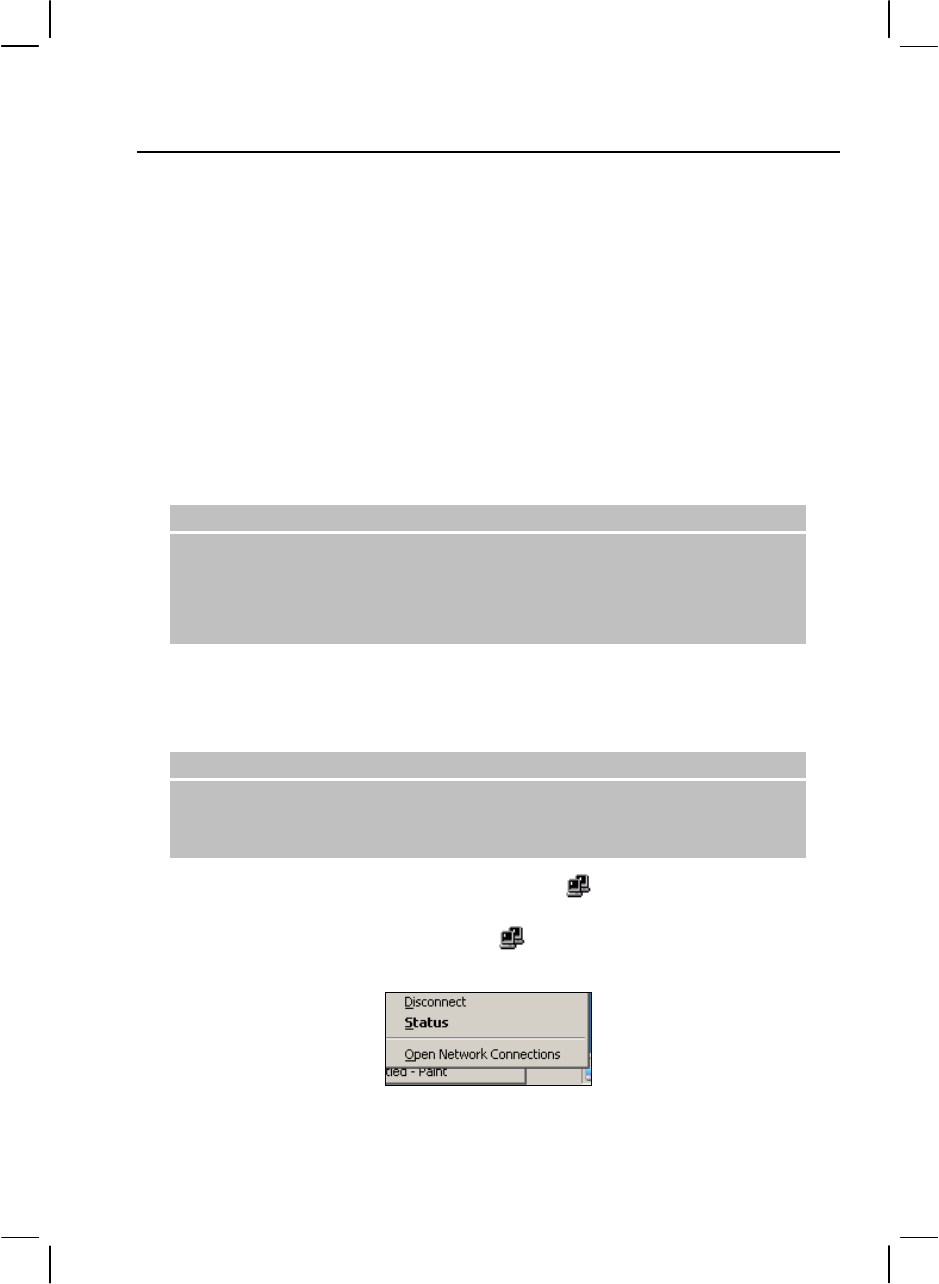
125
6. Press the Menu soft key and select Activate. Notice not to press any key to leave the
current screen.
7. Connect your Smartphone to the desktop computer, and insert the Companion CD into the
CD-ROM drive of the desktop computer.
8. The installation of the USB driver will start automatically. If needed, browse for the USB
driver on the Companion CD.
9. Open the Device Manager on the desktop computer by clicking Start Control Panel
System Hardware (for Windows 2000/XP/2003) Device Manager.
10. Open the Modem item, right-click on Mio DigiWalker SmartPhone USB Modem, and
select Properties.
11. Open the Advanced page, enter +CGDCONT=1,“IP”,“MMS” under Extra
initialization commands, and click OK.
|NOTE}
Depending on your service provider, the string for you to enter may not be
“MMS.” To make sure of the correct string to enter, on the Home screen press
the Start soft key Settings Data Connections the Menu soft key
Edit Connections GPRS Connections select your GPRS connection
the Menu soft key Edit Access point.
12. On your desktop computer, create a dial-up connection using your Smartphone as the
modem, enter *99# for the phone number and user name; you do not need to set up the
password.
|NOTE}
For information on creating a dial-up connection on the desktop computer, see
the documents that came with the operating system.
You are advised to set the baud rate to at least 115200.
13. Click Dial on your dial-up connection screen. The icon appears on the task bar after
the successful dial-up connection.
14. To end the connection, right-click on the icon on the desktop computer and select
Disconnect. Or, press the right soft key on the Smartphone Deactivate.

126
|NOTE}
Failing to deactivate the modem link when you are finished using it might result
in problems with using ActiveSync in the same session.
Disconnecting the ActiveSync cable will not completely stop the modem
connection on the Smartphone. You have to press the Menu soft key
Deactivate.
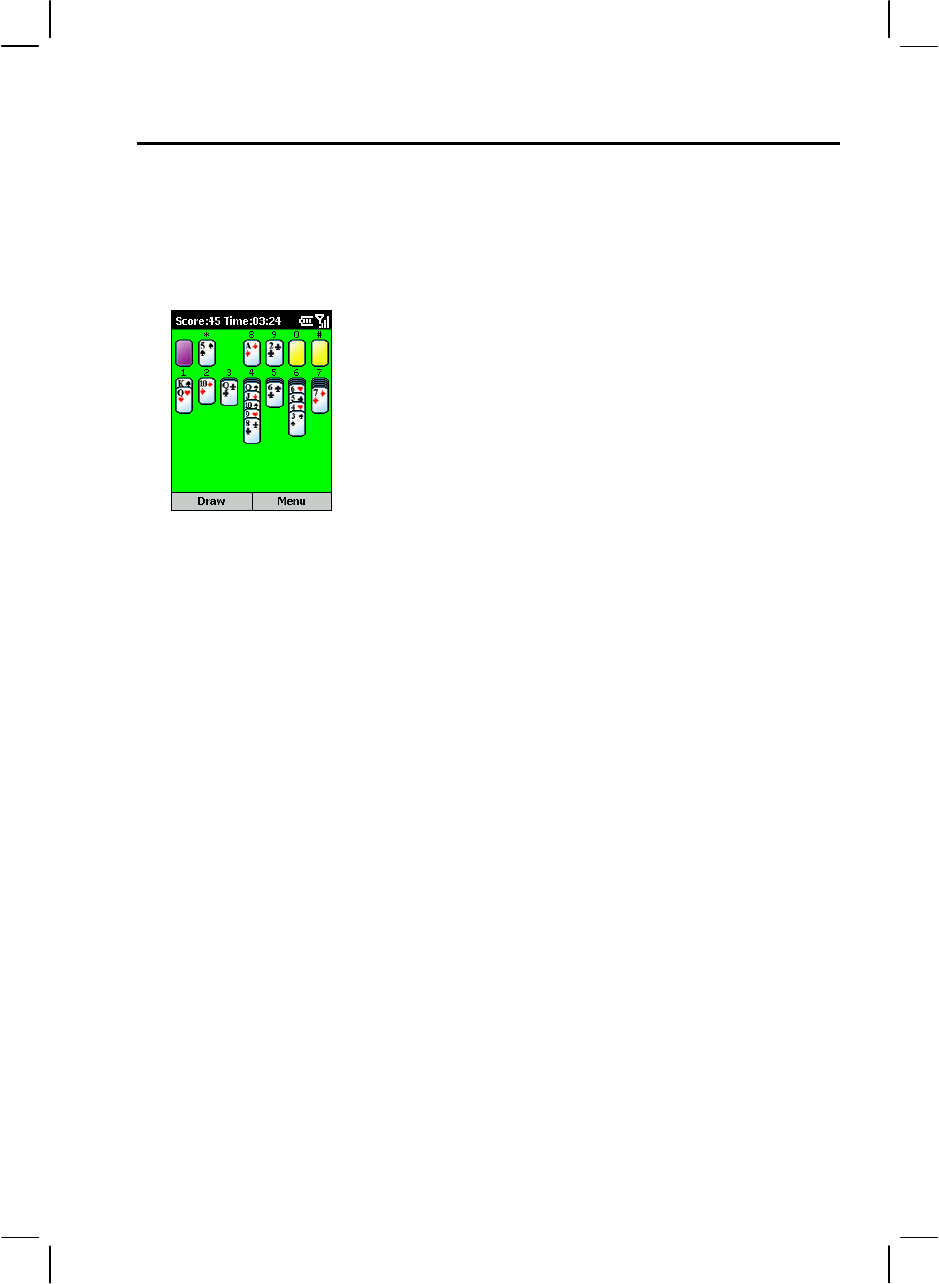
127
8.4 Games
Solitaire
The object of Solitaire is to use all the cards in the deck to build up the four suit stacks in
ascending order, beginning with the aces. You win the game when all cards are on the suit
stacks.
1. On the Home screen, press the Start soft key and select
Games Solitaire.
2. To start a new game of Solitaire, press the Menu soft key and
select New Game.
3. Press the number or character above the card stack displaying
the card you want to move, and then press the number or
character above the card stack to which you want to move the
card.
Pushing the Navigation stick up will move a card to one of the
four card stacks on the upper right corner of the screen if it
belongs there. For example, if you have an ace displayed in
one of the seven stacks, press the number above the ace, and
then push the Navigation stick up.
4. Move any aces on the seven stacks to the four card spaces at
the top of the screen, and then make any other available plays.
5. When you have made all available plays, press the Draw soft
key to turn over cards. The card that is face up on the deck is
always available for play.
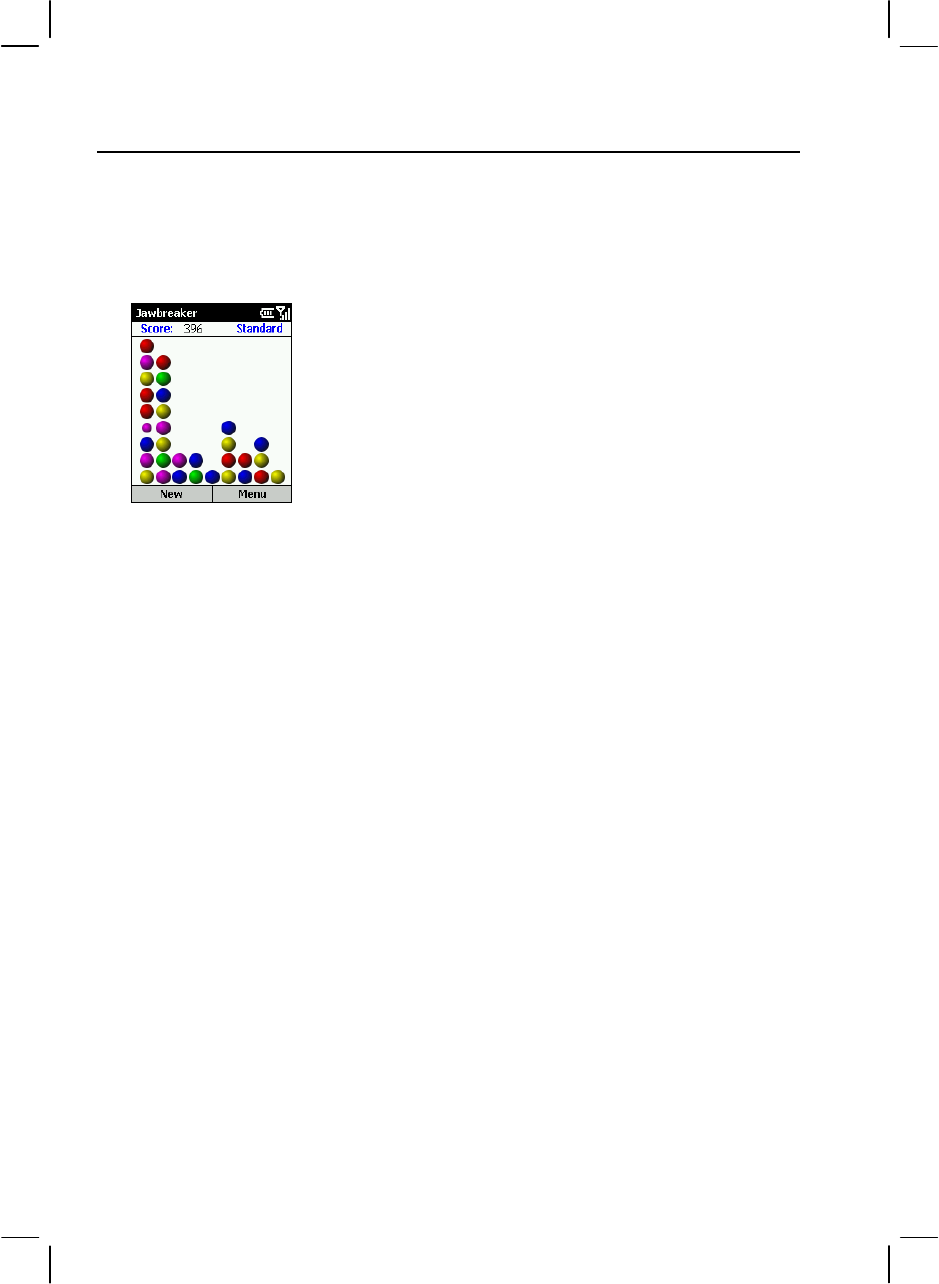
128
Jawbreaker
To play Jawbreaker, you need to eliminate as many adjacent balls of the same color as
possible.
1. On the Home screen, press the Start soft key and select
Games Jawbreaker.
2. To start a new game of Jawbreaker, press the New soft key.
3. The ball being selected will flash. To eliminate two (or more)
adjacent balls of the same color, scroll to select and press the
Navigation stick. The screen will display the score for
eliminating the selected balls. Press the Navigation stick
again to eliminate them.
To undo the elimination, press the Menu soft key and select
Undo. You can only undo once.
4. The game is over when all adjacent balls of the same color are
eliminated. The screen will then display the score.
Press the Menu soft key and select Statistics to view the number of games you have played,
the average score, the highest score, and the big burst for a single elimination. You can press
the Reset soft key to reset the statistics.
Press the Menu soft key and select Options to change the settings for playing sounds, game
style and the color of the balls (breakers).

129
8.5 Calculator
You can use Calculator to perform any of the standard operations for which you would
normally use a handheld calculator. Calculator performs basic arithmetic, such as addition,
subtraction, multiplication, and division.
To enter numbers and perform calculations:
1. On the Home screen, press Start soft key and select
Accessories Calculator.
2. Use the keypad to enter numbers and perform calculations.
Press the Asterisk (*) key to enter a decimal point.
3. To enter the mathematical symbols:
• Press the Pound (#) key to cycle through the available
mathematical symbols: the plus sign (+), the minus sign
(–), the multiplication sign (x), and the division sign (/).
• You can also use the menu commands to display the
available mathematical symbols.
• You can also use the navigation pad to display the
available mathematical symbols. Push the Navigation
stick upward for the plus sign (+), downward for the
minus sign (–), left for the division sign (/), and right for
the multiplication sign (x).
4. If you enter the wrong number, press the Back key to clear
the last digit entered in a multiple-digit entry. Note that the
divisor cannot be 0.
5. When you entered the calculation, press the Navigation stick
to obtain the answer. Or, you can obtain the answer using the
Equals of the menu commands.
6. To clear the current calculation and start a calculation again,
press the Clear soft key.

130
Part II
Software Manual

131
9 Using the Digital Camera
Your Smartphone features a built-in CMOS camera. You can take photos or record videos and
then directly view these photos or videos on your Smartphone. What’s more, you can
immediately share with others your photos and videos through the mobile network service.

132
9.1 Phone Camera
The Phone Camera program is your tool for taking photos and recording videos on your
Smartphone.
Taking Photos
1. If you want to save your photos in a storage card, insert the card.
2. On the Home screen, press the Start soft key and select Phone Camera.
3. By default, the camera is in Take Photo mode. If you are currently in Record Video mode,
press the Menu soft key and select Take Photo to change the mode.
4. Frame your target in the viewing window. You can rotate your Smartphone if necessary.
5. If you need to adjust the brightness or zoom in/out, follow this method:
• Push the Navigation stick up/down to adjust the brightness of the image (only when
the Brightness item in Settings is set to Manual).
• Push the Navigation stick left/right to zoom in/out (only when the Picture
Resolution item in Settings is set to 176x144).
A sliding bar appears at the bottom of the screen to indicate the adjustable range. It
disappears after three seconds of inactivity.

133
6. When you are ready to take the photo, press the Navigation stick.
7. The left soft key on the screen will display Save. Press the left soft key or the Navigation
stick to save the photo. If you do not respond in five seconds, the program will
automatically save it.
The photo is saved as a .jpg file in the storage card (if inserted) or in the memory of your
Smartphone.
8. To immediately view the saved photo, press the Viewer soft key to open Phone Viewer.
(For details on Phone Viewer, see section 9.2.)
|NOTE}
After shooting, you can press the Send soft key to create a new MMS message
containing the new photo.
If you do not want to save the photo after shooting, press the Back key within 5
seconds.
To configure the camera settings, press the Menu soft key and select
Settings. (For more information, see “Phone Camera Settings” later in this
chapter.)
Continuous Shots
Your camera features continuous shots. You can take a total of nine continuous shots at the
set interval (0.5 second by default).
1. While in the Take Photo mode, press the Menu soft key and select Continuous. The
icon appears on the top left corner of the screen to indicate that the Continuous mode is in
use.
2. Follow steps 4 to 6 as described in the previous section to take the photo. The Smartphone
will take nine continuous shots and then display the photos on the screen.
3. Press the Save soft key to save the nine photos or Cancel soft key to abandon the photos.

134
Recording Videos
1. If you want to save your videos in a storage card, insert the card.
2. On the Home screen, press the Start soft key and select Phone Camera.
3. By default, the camera is in the Take Photo mode. Press the Menu soft key and select
Record Video to change to Record Video mode.
4. Frame your target in the viewing window. You can rotate your Smartphone if necessary.
5. If you need to adjust the brightness or zoom in/out, follow this method:
• Push the Navigation stick up/down to adjust the brightness of the image (only when
the Brightness item in Settings is set to Manual).
• Push the Navigation stick left/right to zoom in/out.
A sliding bar appears at the bottom of the screen to indicate the adjustable range. It
disappears after three seconds of inactivity.
6. When you are ready to record the video, press the Navigation stick to start recording. To
stop the recording, press the Navigation stick again.
7. The left soft key on the screen will display Save. Press the left soft key or the Navigation
stick to save the video. If you do not respond in five seconds, the program will
automatically save it.
The video is saved as a .3gp file in the storage card (if inserted) or in the memory of your
Smartphone.
8. To immediately watch the saved video, press the Player soft key to open Video Player.
(For details on Video Player, see section 9.3.)

135
|NOTE}
When saving the video in your Smartphone, the maximum recording time
allowed is 15 seconds; when saving in a storage card, you can keep on
recording until the card runs out of space.
After recording, you can press the Cancel soft key in five seconds to abandon.
Phone Camera Settings
To configure Phone Camera, press the Menu soft key and select Settings on the Phone
Camera main screen. While in the Settings menu, scroll up/down to an item. To select an
option for the item, scroll left/right or press the Navigation stick to select from a submenu.
Phone Camera
Settings
Description
Timer Sets the time lag between releasing the shutter and shooting the
photo. This is helpful for avoiding blurring caused by vibration of
your Smartphone when you press a key. The options are 0~10
seconds (default is 0). For example, if you set the timer to 3, when
you press the key to shoot, the timer will start to count down and you
should keep the Smartphone steady until the time is up and the photo
is shot.
Mode Default setting is Normal Mode. When in a dark place, select
Twilight Mode for better result.
Picture Resolution Sets the resolution (pixels) of the photo. The options are 176x144
(default), 320x240 and 640x480.
The image resolution for videos is 176x144.
Video Quality Sets the video quality to High Quality or Normal Quality.
Storage Media Selects the storage location for the photos and videos to Storage or
SDMMC Disk.
Photos are stored in the \Storage\My Documents folder of your
Smartphone or \PhotoAlbum folder of the storage card.
Videos are stored in the \Storage\My Documents folder of your
Smartphone or \MovieAlbum folder of the storage card.
Brightness Sets the brightness control to Manual (default) or Auto.
Flicker Control When you use the camera indoors, you can select 50Hz or 60Hz to
match the local flicker frequency of the fluorescent lamp.
Continues Interval Sets the time interval (second) for taking continuous photos.
The options are 0.5s (default), 0.75s and 1s.

136
Notes on Using Phone Camera
To use Phone Camera, your Smartphone must have enough memory. If the memory is
inefficient, a warning message will appear on the screen. To solve the problem, you can
free the memory by:
• Deleting files you no longer need
• Stopping all other programs
• Turn off and then on the Smartphone
If you press the Volume Control button while in Phone Camera, the program will be
closed.
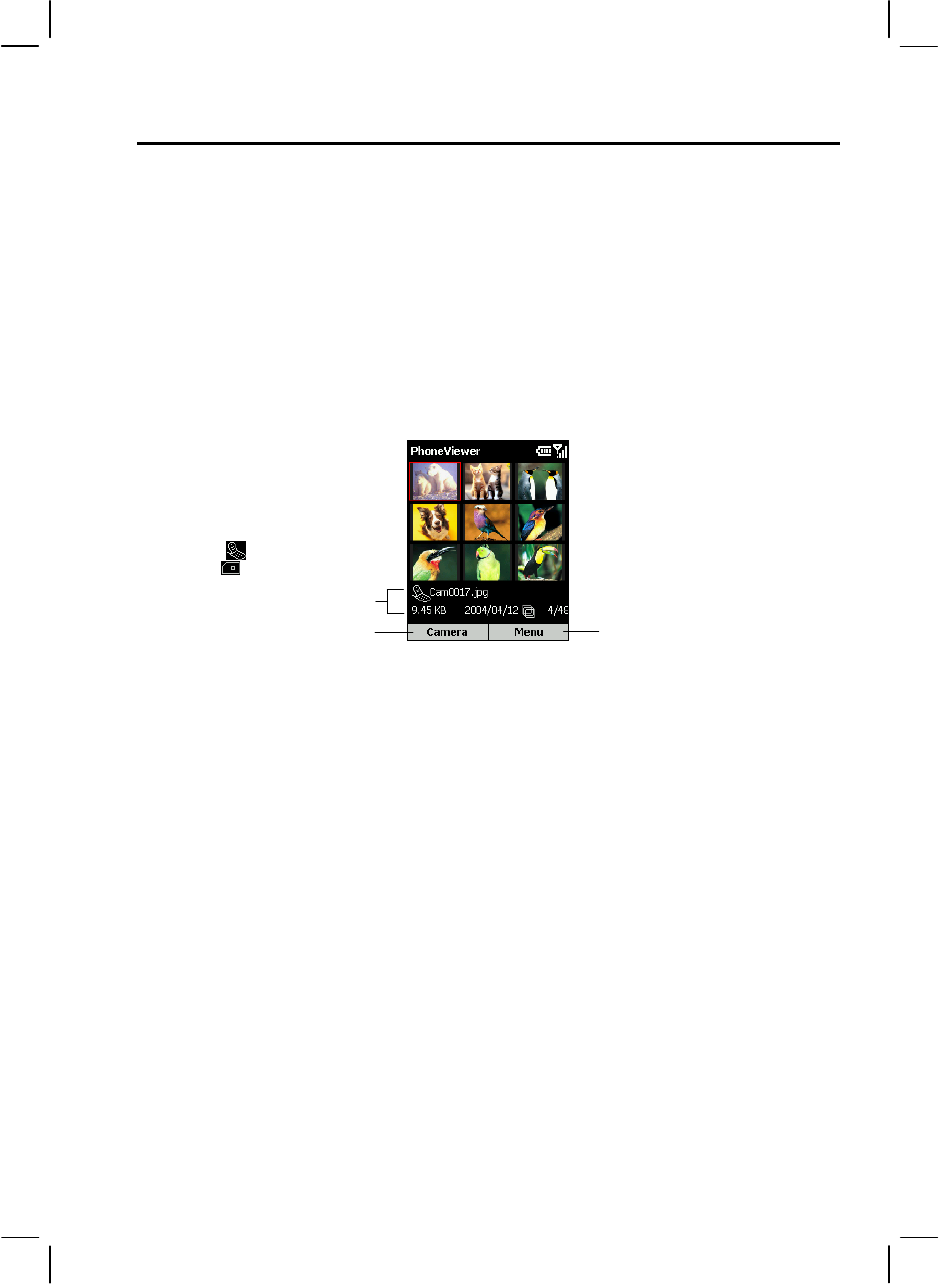
137
9.2 Phone Viewer
The Phone Viewer program allows you to view pictures in .jpg and .bmp formats, display a
slideshow of all the pictures, and edit the pictures.
Viewing Photos
Thumbnail View
1. On the Home screen, press the Start soft key and select Phone Viewer.
2. If a storage card is inserted, the program will display the files in the card. Otherwise, it
will display the .jpg and .bmp files in the Storage\My Documents folder and its subfolders
of your Smartphone. One screen displays a total of nine thumbnails.
3. When you scroll to a photo, you can do any of the followings:
• Press the Navigation stick to view the photo in full screen.
• Use the Menu soft key to perform various tasks such as sending and editing. (See
later instructions.)
Current number/total photo number
Switch to Phone Camera.
File location indicato
r
( for Smartphone and
for storage card) and
the file properties of the
selected photo

138
Full Screen View
When you open a photo in the thumbnail view, the photo displays in full screen.
After opening a photo in full screen, you can:
Press the Back soft key to return to the thumbnail view.
Use the Menu soft key to perform various tasks such as sending and editing. (See later
instructions.)
Push the Navigation stick up/down to switch to the previous/next photo in full screen.
Push the Navigation stick left/right to zoom in or out on the photo (25% ~ 200%).
If you zoom in on the photo, you can move the focus by selecting Menu Move and
then push the Navigation stick to move. Press the Navigation stick to go back to the
previous screen.

139
Adding a Theme to a Photo
You can add a theme to your photo to make it fancier. Phone Viewer provides 12 themes for
you to select.
1. In full screen view or thumbnail view, press the Menu soft key and select Edit Add
Theme to add a theme to the selected photo.
2. Scroll left/right to select a theme and press the Select soft key or the Navigation stick.
3. Press the Save soft key. The photo with a theme will be saved as a new photo in the album.
Adding a Memo to a Photo
You can add a text and/or voice notes to a photo.
1. In full screen view or thumbnail view, press the Menu soft key and select Memo to add a
memo to the selected photo.
2. To add a text note, type the text in the text field at the bottom of the screen. You can type
for up to 100 characters. Or, you can press the Navigation stick to change to full screen
mode and type or read the text. Press the Done soft key to save the text and return to the
previous screen.
Enter the text here.
Full screen
Press to accept the
selected theme.
Press to cancel the operation.
Scroll left/right to select.
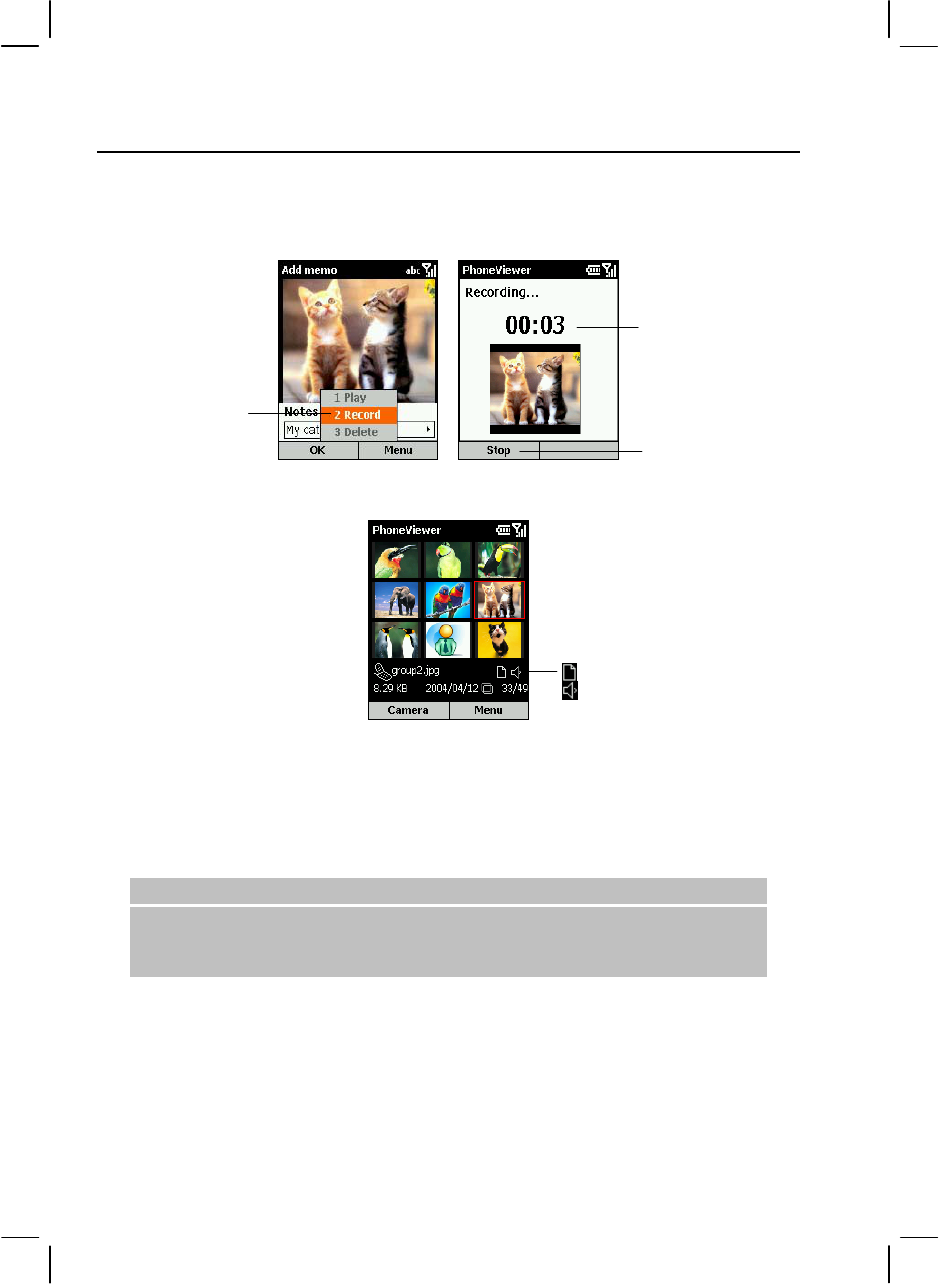
140
3. To add a voice note, press the Menu soft key and select Record to start recording voice.
Press the Stop soft key or the Navigation stick to stop. You can add only one voice
recording to a photo, meaning a second recording will replace the old one.
4. Press the OK soft key. In the thumbnail view, you will see text and voice note indicators.
When you select Memo from the menu commands next time, you will see the text note. To
play the recording, press the Menu soft key and select Play.
For your Smartphone to play the voice note automatically when you open the photo next time,
in the thumbnail view, press the Menu soft key, select Settings, select Play audio, and then
press OK soft key.
|NOTE}
To delete the text note of a selected photo, erase all characters in the text input
field with the Back key. To delete the voice note of a selected photo, press the
Menu soft key and select Delete.
Select to start
recording.
Recording progress
Press to stop recording.
Text note
Voice note

141
Renaming a Photo
1. In full screen view or thumbnail view, press the Menu soft key and select Edit
Rename to rename the current selected photo.
2. Enter the new name in the text field.
3. Press the Save soft key.
Adding a Special Effect to a Photo
1. In full screen view or thumbnail view, press the Menu soft key and select Edit Effect
to apply an effect to the selected photo.
2. Scroll left/right to select an effect such as grayscale, negative, duotone, and rotate.
3. Press the Save soft key to save the changed photo as a new file.

142
Cropping a Photo
1. In full screen view or thumbnail view, press the Menu soft key and select Edit Crop
for sub display to crop the current selected photo.
2. A square appears on the screen. Push the Navigation stick to move the sqare to the area
you want to crop.
3. Press the Save soft key or Navigation stick to save the cropped photo as a new file.
Slide Show
You can display a slide show of your photos.
1. If you want to specify he location of the photos, press the Menu soft key and select Select
Folder.
2. To change the default settings of the slide show, press the Menu soft key and select
Settings. You can customize the following options. When completed, press the OK soft
key.
• Time setting sets the interval between displaying one photo and the next one. The
options range from 1 to 9 seconds (default is 2).
• Slide show view is Best Fit (default) or Full Screen.
• Slide show sequence is Forward (default) or Backward.
• Play audio sets if the voice notes (if added to the photos) are played during the slide
show.
3. To start the slide show, press the Menu soft key and select Slide show.
4. All photos will be displayed one after another in the way as specified above until you
press the OK soft key to stop.

143
Phone Viewer Menu Commands
Either in the thumbnail view or full screen view, press the Menu soft key to access the menu
commands as described below:
Thumbnail View
Menu
Full Screen
View Menu Description
Send via Send via Sends the selected photo via MMS or infrared.
Edit Edit Edits the selected photo. The available commands are
Add theme, Memo, Rename, Effect, and Crop for
sub display (See the previous sections for
instructions.)
Select Folder − Specifies the location of the photos:
My Device displays the photos stored in the
Storage\My Documents folder of your
Smartphone.
Storage Card displays the photos stored in the
storage card, if inserted.
Delete Delete Deletes the selected photo.
− Move Activates the Move function (available only when
you have zoomed in on the photo).
− Full screen Displays only the photo on the screen (no top title bar
and bottom soft key commands).
To end the full screen display, press the Back key or
Navigation stick.
Slide show − Displays a slideshow of the photos (as described in
“Slide Show” earlier).
Wallpaper Wallpaper Sets the selected photo as wallpaper of the Home
screen.
Settings − The first item sets the total number of photos
displayed in the thumbnail view. The options are 6, 9
(default), and 12.
The remaining items configure the settings for a
slideshow (as described in “Slide Show” earlier).
Exit − Closes the program.
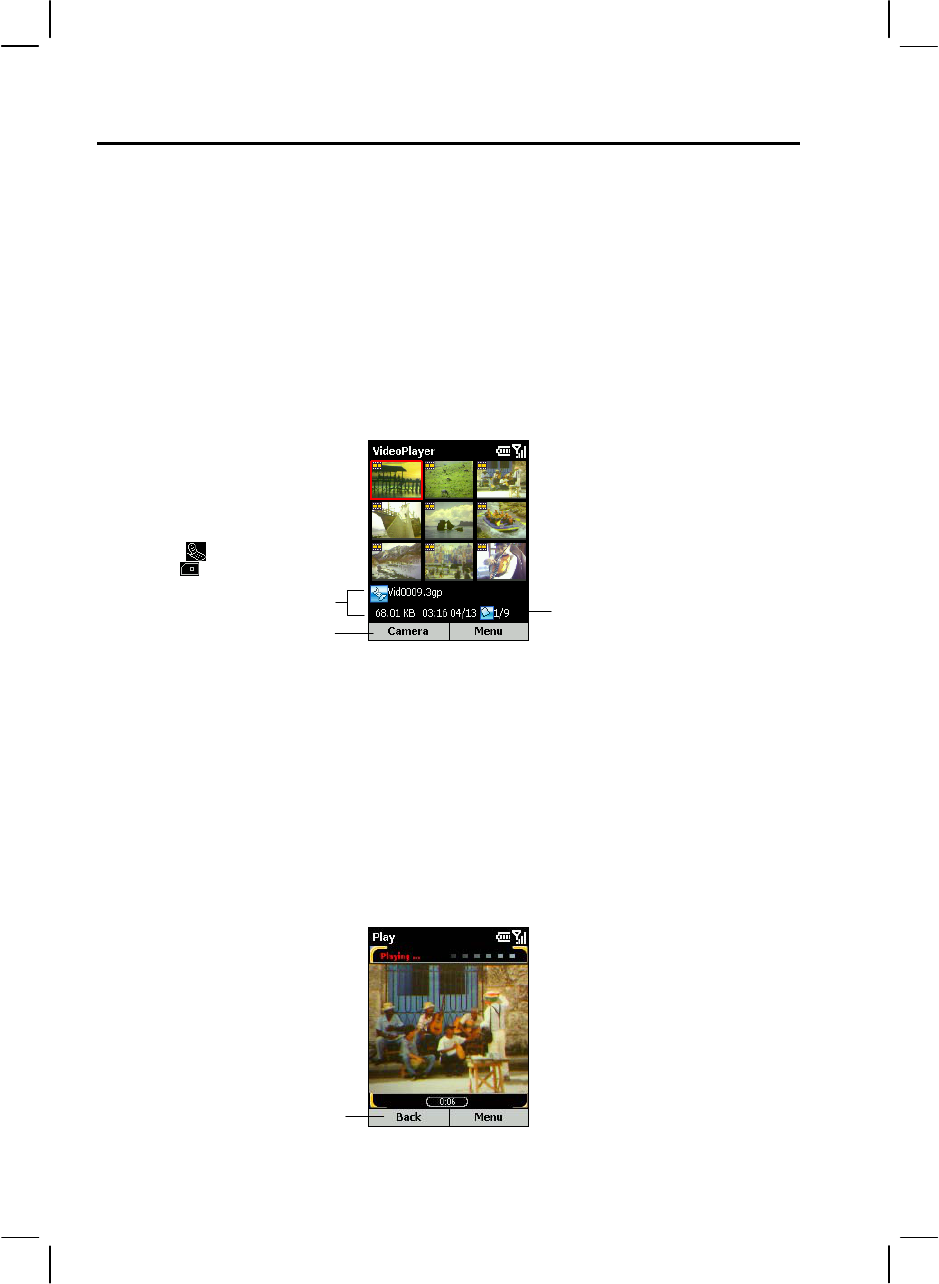
144
9.3 Video Player
Video Player allows you to play the videos (.3gp format) you have recorded using Phone
Camera.
Playing Videos
Thumbnail View
1. On the Home screen, press the Start soft key and select Video Player.
2. If a storage card is inserted, the program will display the videos in the card; otherwise, it
will display the videos in the Storage\My Documents folder and its subfolders of your
Smartphone. One screen displays a total of nine thumbnails.
3. To play a video, scroll to select and then press the Navigation stick to watch the video in
full screen.
Full Screen View
When you open a video in the thumbnail view, the video plays in full screen.
During the playback, the progress bar appears at the bottom of the screen to indicate the
elapsed time (mm:ss). Press the Navigation stick to pause, and press the button again to
resume.
After opening a video, you can press the Menu soft key to control the playback such as pause,
stop, or delete. Press the Back soft key to return to the thumbnail view.
Return to the
thumbnail view.
Switch to Phone Camera.
Current number/Total video number
File location indicato
r
( for Smartphone and
for storage card) and
the file properties of the
selected video

145
Video Player Menu Commands
In the thumbnail view, press the Menu soft key to access the menu commands as described
below:
Menu Description
Play Plays the selected video in full screen.
Delete Deletes the selected video.
Rename Renames the selected video.
MMS Sends the selected video via MMS.
Select Folder Specifies the location of the videos:
My Device displays the photos stored in the Storage\My
Documents folder of your Smartphone.
Storage Card displays the photos stored in the storage card, if
inserted.
Settings Sets the total number of videos displayed in the thumbnail view.
The options are 6, 9 (default), and 12.
Exit Closes the program.

147
10 More Programs
In addition to Microsoft core programs, several programs are built into your Smartphone so
you can take full advantage of your Smartphone.
Three camera-related programs are described in the previous chapter. This chapter describes
the remaining programs.

148
10.1 Photo ID
Use Photo ID to assign photos to your contacts. When a contact calls you, his/her photo
appears on the screen.
You can also use Photo ID to manage the phone book stored in your Smartphone and in your
SIM card. For example, you can add, delete, or edit a contact, and make a call from here.
On the Home screen, press the Start soft key and select Photo ID to open Photo ID. By
default, the program will load the phone book of the SIM card and the Smartphone’s Contacts.
After the loading finishes, the contact list (Photo ID main screen) is displayed in the
alphabetic order of contact names.
|NOTE}
On your Smartphone, there can be two kinds of independent contact lists. One
is stored in the Smartphone’s memory; the other is stored in the SIM card.
You can use both Contacts and Photo ID to load the contact information stored
in the Smartphone’s memory and SIM card. You can use either program to add
or delete data; the changes you make will be valid in both programs.
For information on using Contacts, see section 6.1.
To refresh the contact data, press the Menu soft key on the Photo ID main
screen and select Refresh.
Assigning a Photo ID to a Contact
Your Smartphone provides several photo templates for you to use. You can also have a unique
photo ready by:
Taking a photo using your Smartphone’s camera
Copy the image file to the Storage\My Documents folder of the Smartphone via
ActiveSync, infrared, or Internet
|NOTE}
The photo must be a .jpg file of 176x144 resolution for the Photo ID function to
work.
The photo ID will not appear if the caller disables his caller ID feature on his
phone.
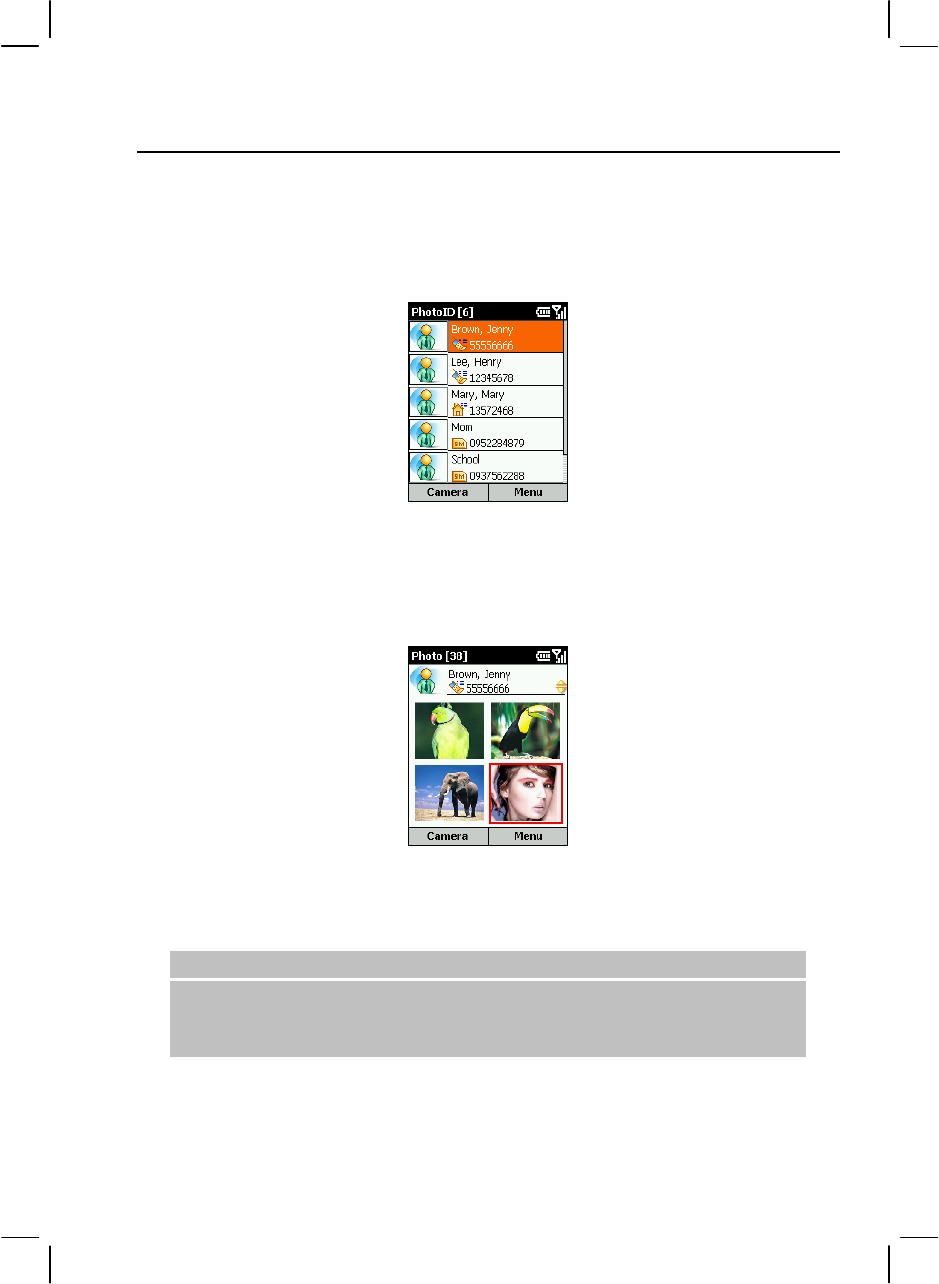
149
To assign a photo to a contact:
1. On the Home screen, press the Start soft key and select Photo ID.
The contact list appears on the screen. Default photo IDs are assigned to all contacts
unless you change the settings.
2. Scroll to the desired contact entry.
3. To assign a photo for the contact, do one of the following:
To select from the existing photos, press the Menu soft key, and select Edit Assign
Photo. Scroll to select the desired photo.
If you want to immediately take a photo to be assigned to the selected contact, press
the Camera soft key. Frame your target in the viewing window, and press the Shutter
soft key to take the photo. Press the Save soft key.
|NOTE}
You can also assign a photo after opening the contact card. (See “Editing a
Contact” later in this chapter.)
For detailed information on taking a photo, see section 9.1.
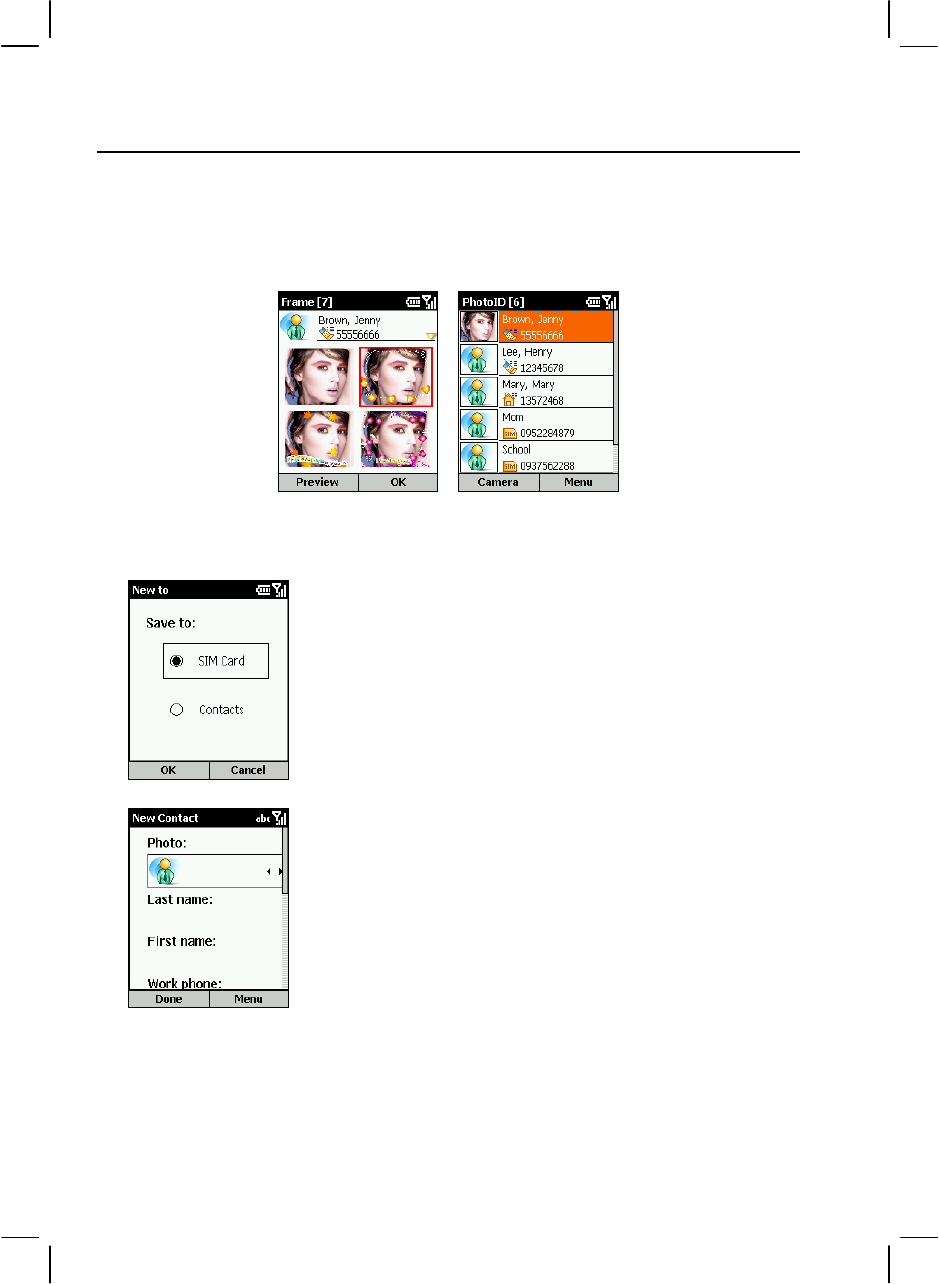
150
4. After selecting a photo, the Frame screen appears. Scroll to select the desired flashing
frames or the normal photo without a frame. You can also press the Preview soft key to
preview the photo with the selected frame.
The photo you assigned for the contact now appears on the Photo ID main screen.
Adding a Contact Using Photo ID
1. On the Home screen, press the Start soft key and select
Photo ID.
2. On the Photo ID main screen, press the Menu soft key and
select Edit New.
3. Scroll to SIM Card or Contacts as the location to save this
contact, and press the OK soft key.
4. In Photo, scroll left/right to select a photo or press the
Navigation stick to select from the full list.
5. Enter related information and phone numbers in the other
input fields.
6. If you are adding a contact to Contacts, in Custom ring
tone, scroll left/right to select a ring tone or press the
Navigation stick to select from the full list.
7. If you want to assign the contact to a group, in Group, scroll
left/right to select a contact group or press the Navigation
stick to select from the full list.
8. If you are adding a contact to Contacts, you can press the
Menu soft key and select Edit More to enter more
information. Then press the Done soft key.
9. Press the Done soft key. The contact is now in your contact
list.
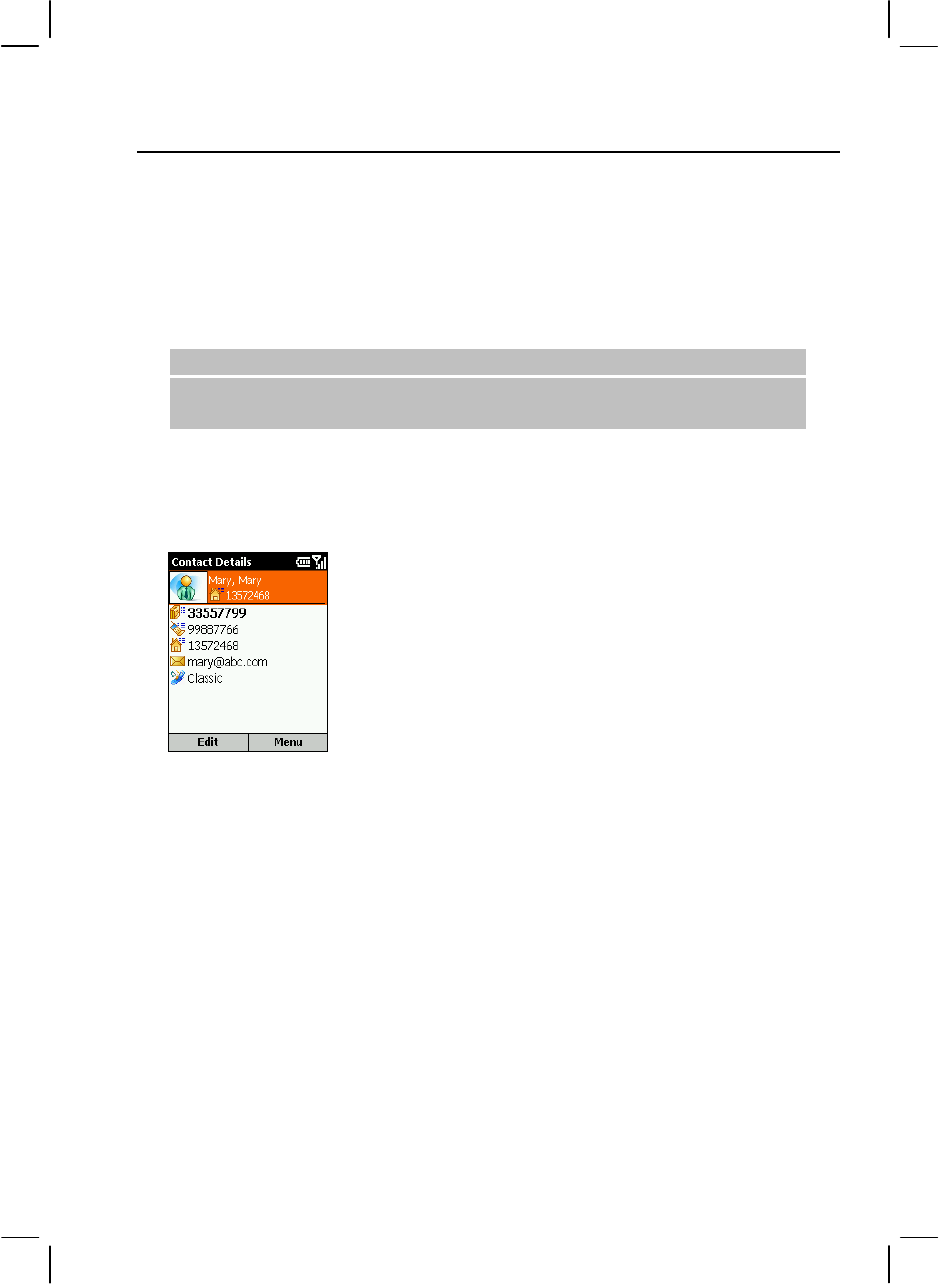
151
Deleting a Contact
1. On the Home screen, press the Start soft key and select Photo ID.
2. On the Photo ID main screen, scroll to a contact to delete.
3. Press the Menu soft key and select Edit Delete.
|NOTE}
If you already open the contact card of the contact, press the Menu soft key
and select Delete.
4. Press the OK soft key.
Editing a Contact
1. On the Home screen, press the Start soft key and select
Photo ID.
2. Scroll to the contact to edit and press the Navigation stick to
open the contact card.
3. Scroll to the entry that you want to edit.
4. Press the Edit soft key; or, press the Menu soft key and select
Edit.
5. Make the changes and press the Done soft key.
Viewing Modes
Photo ID provides four viewing modes for you to view the contact information.
To change the viewing mode, press the Menu soft key on the Photo ID main screen and select
View Mode, then your desired mode.

152
All Contacts [Detail]
By default, the screen displays the All Contacts [Detail] mode
when you open Photo ID.
In this mode, the left column of the screen displays the default or
assigned photos, and the right column the names and phone
numbers of the contacts. If the contact is stored in the SIM card,
the phone number is preceded by the icon. If the contact is
stored in your Smartphone, the phone number is preceded by the
photo indicator such as .
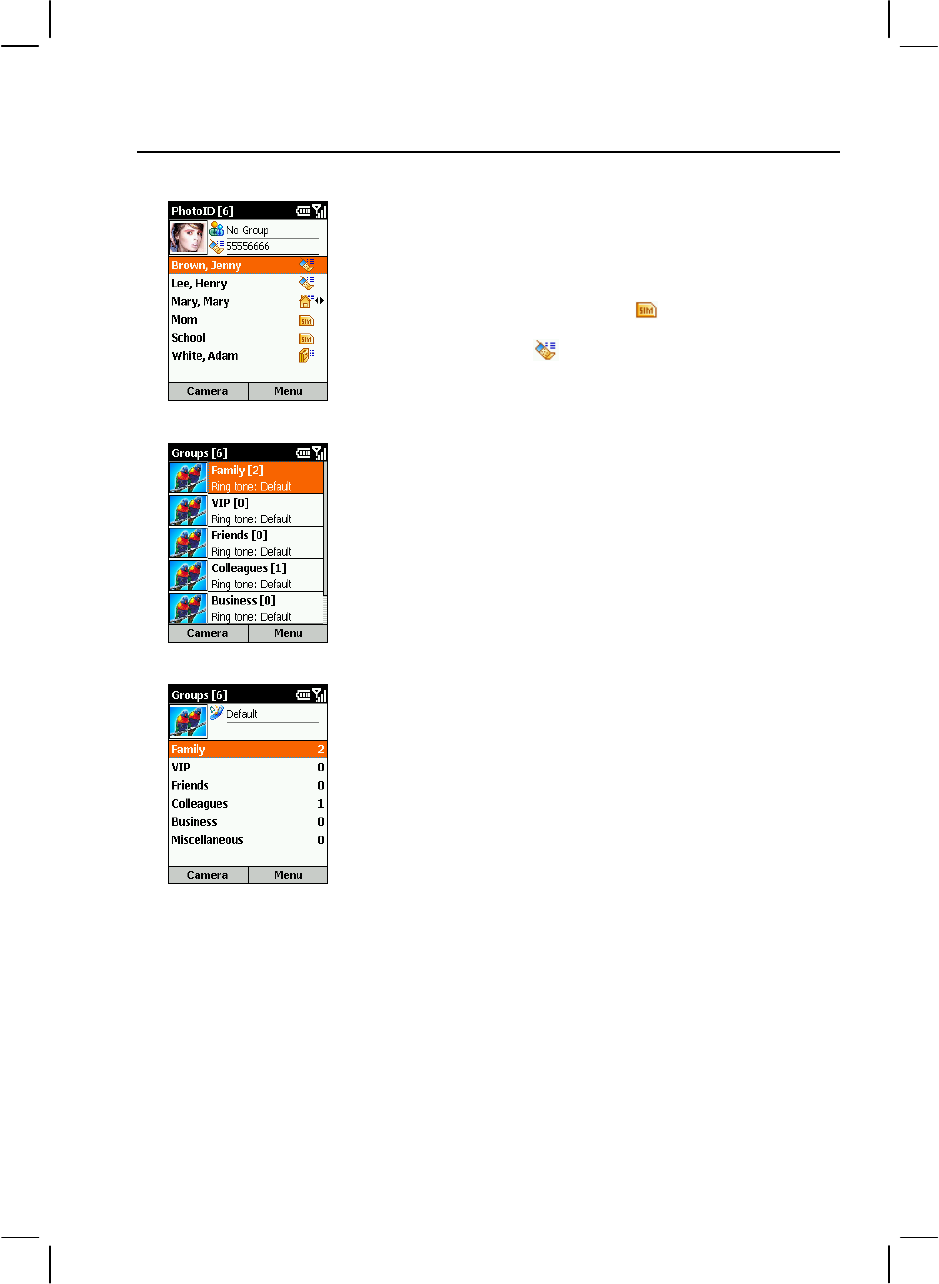
153
All Contacts [List]
In this mode, the top of the screen displays the information of the
selected contact. The middle of the screen displays the contact list
with names and locations. If the contact is stored in the SIM card,
the phone number is preceded by the icon. If the contact is
stored in your Smartphone, the phone number is preceded by the
photo indicator such as
Group Only [Detail]
In this mode, the screen displays the list of contact groups. (For
information on groups, see the next section.)
The left column of the screen displays the photos of the contact
groups, and the right column the group name, number of contacts
in the group and ring tone.
Group Only [List]
In this mode, the top of the screen displays the information of the
selected contact group. The middle of the screen displays the
contact group list with group names and number of contacts in the
group.

154
Managing Contact Groups
You can assign your contacts to different contact groups for efficient management. By
default, Photo ID provides six contact groups, including Family, VIP, Friends, Colleagues,
Business and Miscellaneous.
Assigning Group Members
You can assign a contact group when adding or editing a contact. You can also assign group
members by the following procedure:
1. On the Photo ID main screen, press the Menu soft key and select Manage Group.
2. In the contact group list, scroll to the group to assign members.
3. Press the Menu soft key and select Assign Members.
4. Select the contacts as the members of the selected group and press the Done soft key.
Assigning a Group Photo
1. On the Photo ID main screen, press the Menu soft key and select Manage Group.
2. In the contact group list, scroll to the group to assign a photo.
3. Press the Menu soft key and select Assign Photo.
4. To assign a photo, follow the same procedures for assigning a photo to a contact as
described previously.
5. Press the OK soft key. The photo you assign for the selected group is now on the screen.
When a contact in the group calls you and this contact does not have a personal photo
assigned, the photo assigned to the group appears on the screen.
Assigning a Group Ring Tone
1. On the Photo ID main screen, press the Menu soft key and select Manage Group.
2. In the contact group list, scroll to the group to assign a ring tone.
3. Press the Menu soft key and select Ring Tone.
4. Scroll to the ring tone you want and press the Done soft key.
When a contact in the group calls you and this contact does not have a personal ring tone
assigned, the ring tone assigned to the group plays.
|NOTE}
Custom ring tone does not work for SIM card contacts.

155
Adding a Group
1. On the Photo ID main screen, press the Menu soft key and select Manage Group.
2. Press the New soft key.
3. Enter the name of the new contact group.
4. Press the OK soft key. The new group has been added to the bottom of the group list.
|NOTE}
To rename a group, press the Menu soft key and select Rename.
Deleting a Group
1. On the Photo ID main screen, press the Menu soft key and select Manage Group.
2. In the contact group list, scroll to the group to delete.
3. Press the Menu soft key and select Delete.
4. Press the OK soft key to delete the selected group.
Photo ID Settings
To configure Photo ID, on the Photo ID main screen, press the Menu soft key and select
Settings.
Photo ID Settings Description
Load from Sets the location of data to be loaded. The options are SIM card
& Contacts (default), SIM card, and Contacts.
Define left key
function
Defines the function of the left soft key in Photo ID. The options
are New, Assign Photo, and Camera (default).
Show photo for
incoming call
Uncheck the box if you want to use the default Microsoft
incoming call screen instead of Photo ID.

156
10.2 Orange Programs
Orange Backup
No source information.
Orange Update
No source information.

157
10.3 Java Game
The Java program allows you to play Java games on the Smartphone.
Opening Java
On the Home screen, press the Start soft key and select Java.
You can use the following methods to install Java games:
Run JAR files on the Smartphone.
Use Internet Explorer to connect to the Internet and download JAD files through HTTP
(WAP not supported).
Your Smartphone is preinstalled with the Java game Burning Rush.
|NOTE}
You can also press the Start soft key on the Home screen and select Games
Burning Rush.
Your Smartphone does not support the installation of Java games through the
mobile phone network.
Burning Rush
1. On the Home screen, press the Start soft key and select Java.
2. Scroll to Burning Rush and press the Launch soft key or
Navigation stick.
3. Press the OK soft key on the Start screen.
4. Scroll to NEW GAME and press the Select soft key or
Navigation stick to begin.
5. Use the control keys as described below to play the game.
Burning Rush Control
Keys Function
Push the Navigation stick
up/down/left/right or
press number key 2/8/4/6
Control the movement.
Press the Navigation stick
or number key 5
Shoot.
Press number key 7/9 Use the hoe to destroy the obstacles.

159
Part III
References

161
11 References
This chapter provides the reference information.

162
11.1 Product Specification
Component Specification
CPU Intel PXA 262 200MHz
Operating System Windows Mobile™ for Smartphone
Memory − 32MB ROM (The available space for the end user is
approximately 15MB. The available space depends on the
programs installed.)
− 32MB SDRAM
Display 2.2-inch Transflective color LCD display,65K color, 176x220
resolution, with backlight
AC Adapter 100∼240V, 1A
Battery 1050mAH
Standby Time Up to 100 hours
Talk Time Up to 3 to 4 hours
WAN Function − GSM900, supports GSM, 1800 (DCS), 1900 (PCS)
− GPRS Class B device
− SMS/MMS over GPRS
I/O Function − Microphone
− Speaker
− USB 1.1 slave (for ActiveSync)
− IrDA (SIR 1.2, 115.2kbps)
− SD/MMC card slot
Camera Fixed CMOS camera, 300K pixel, VGA
Dimension (W x H x L) 49.5 x 20.8 x 109.8 mm
Weight 120 g
|NOTE}
The specifications are subject to change without notice.
The standby and talk time may vary according to different situations.

163
11.2 Frequently-asked Questions
Problem Solution
Power doesn’t turn
on.
The remaining battery power may be too low to start up
your Smartphone.
If you use the external AC power, make sure that the AC
adapter is firmly and correctly connected.
Remove the battery and replace it. Then turn on the
Smartphone again.
Cannot make a call. Make sure that the phone function is turned on.
Make sure that you are within the range of the mobile
phone network service.
Make sure that the keypad lock is disabled.
Make sure that you dial the correct number.
No ring tone Check the sound volume.
Make sure that your Smartphone is not muted.
Poor signal quality If you are inside a building, move near a window or go
outside.
If you are in a reinforced structure, such as an elevator or
parking garage, wait until you are outside to try your call.
Memory Problems If a warning message of insufficient memory appears, try
to remove programs you no longer need.
If the running programs are occupying large memory, reset
the Smartphone or stop the other programs using
TaskManager. (See section 12.2.)

164
11.3 Restoring Factory Default State
|NOTE}
You are recommended to ask your local dealer for service. Avoid restoring
factory default state by yourself.
In some cases, you may need to restore your Smartphone to the factory default state by
clearing the memory (RAM) from your Smartphone. For example, you should clear the
memory:
When your Smartphone cannot be turned on.
When you forget your password.
When you want to remove the add-on software.
When you wish to return, dispose of, or sell your Smartphone.
Clearing the memory means all data you have entered in RAM, including all files, system
settings and additional programs you have installed, will be erased.
Follow this procedure to clear the memory from your Smartphone:
1. To keep the data stored in your Smartphone, back up your data to your desktop computer
using ActiveSync, and restore it after the memory is cleared.
2. Connect the AC adapter, and disconnect all other cables.
3. Make sure that your Smartphone is turned off.
4. Press and hold the Volume control. When holding it, press and hold the End key for
four seconds to turn on your Smartphone, and then let go of the End key .
5. After the Smartphone vibrates twice, you can let go of the Volume control.
6. Your Smartphone will turn on after about two minutes.
7. Re-install the add-on software, if necessary.
8. Restore your backup, if necessary.

165
11.4 Regulatory Information
|NOTE}
Marking labels located on the exterior of your device indicate the regulations
that your model complies with. Please check the marking labels on your device
and refer to the corresponding statements in this chapter. Some notices apply
to specific models only.
European Notice
Products with the CE marking comply with the Radio & Telecommunication Terminal
Equipment Directive (1999/5/EEC), the Electromagnetic Compatibility Directive
(89/336/EEC) and the Low Voltage Directive (73/23/EEC) – as amended by Directive
93/68/ECC - issued by the Commission of the European Community.
Compliance with these directives implies conformity to the following European Standards:
1999/5/EEC Radio & Telecommunication Terminal Equipment Directive (R&TTE)
EN 301 511
Specific Absorption Rate (SAR)
Standard: EN 50360, EN 50361
73/23/EEC Low Voltage Directive (LVD)
Standard: EN 60950:2000
89/336/EEC Electromagnetic Compatibility (EMC-Directive)
Standard: EN 301489-1/7
The manufacturer cannot be held responsible for modifications made by the User and the
consequences thereof, which may alter the conformity of the product with the CE Marking.

166
FCC Notice:
This device complies with part 15 of the FCC Rules. Operation is subject to the condition
that this device does not cause harmful interference.
This device complies with Part 15 of the FCC Rules. Operation is subject to the following
two conditions:(1) this device may not cause harmful interference, and (2) this device must
accept any interference received, including interference that may cause undesired operation.
This equipment has been tested and found to comply with the limits for a Class B digital
device, pursuant to Part 15 of the FCC Rules. These limits are designed to provide reasonable
protection against harmful interference in a residential installation. This equipment generates,
uses and can radiated radio frequency energy and, if not installed and used in accordance with
the instructions, may cause harmful interference to radio communications. However, there is
no guarantee that interference will not occur in a particular installation If this equipment does
cause harmful interference to radio or television reception, which can be determined by
turning the equipment off and on, the user is encouraged to try to correct the interference by
one or more of the following measures:
-Reorient or relocate the receiving antenna.
-Increase the separation between the equipment and receiver.
-Connect the equipment into an outlet on a circuit different from that to which the receiver is
connected.
-Consult the dealer or an experienced radio/TV technician for help.
Changes or modifications not expressly approved by the party responsible for compliance
could void the user‘s authority to operate the equipment.
The antenna(s) used for this transmitter must not be co-located or operating in conjunction
with any other antenna or transmitter.
This EUT is incompliance with SAR for general population /uncontrolled exposure limits
in ANSI/IEEE C95.1-1999 and had been tested in accordance with the measurement methods
and procedures specified in OET Bulletin 65 Supplement C.

167
4RF Exposure Information (SAR)
This model phone meets the government’s requirements for exposure to radio waves.
This phone is designed and manufactured not to exceed the emission limits for exposure to
radio frequency (RF) energy set by the Federal Communications Commission of the U.S.
Government.
The exposure standard for wireless mobile phones employs a unit of measurement known as
the Specific Absorption Rate, or SAR. The SAR limit set by the FCC is 1.6W/kg. Tests for
SAR are conducted using standard operating positions accepted by the FCC with the phone
transmitting at its highest certified power level in all tested frequency bands. Although the
SAR is determined at the highest certified power level, the actual SAR level of the phone
while operating can be well below the maximum value. This is because the phone is designed
to operate at multiple power levels so as to use only the poser required to reach the network.
In general, the closer you are to a wireless base station antenna, the lower the power output.
The highest SAR value for the model phone as reported to the FCC when tested for use at the
ear is 0.512 W/kg and when worn on the body, as described in this user guide, is 0.472 W/kg.
(Body-worn measurements differ among phone models, depending upon available
enhancements and FCC requirements.)
While there may be differences between the SAR levels of various phones and at various
positions, they all meet the government requirement.
The FCC has granted an Equipment Authorization for this model phone with all reported SAR
levels evaluated as in compliance with the FCC RF exposure guidelines. SAR information on
this model phone is on file with the FCC and can be found under the Display Grant section of
http://www.fcc.gov/oet/fccid after searching on FCC ID: M9H95S2004
.
For body worn operation, this phone has been tested and meets the FCC RF exposure
guidelines for use with an accessory that contains no metal and the positions the handset a
minimum of 1.5 cm from the body. Use of other enhancements may not ensure compliance
with FCC RF exposure guidelines. If you do not use a body-worn accessory and are not
holding the phone at the ear, position the handset a minimum of 1.5 cm from your body when
the phone is switched on.

169
12 Index
A
About
Setting, 52
Accessibility
Setting, 53
Accessories, 12
ActiveSync
Connector, 6
Installing, 10
Alarm setting, 60
Answering a call, 33
Second call, 34
Appointment. See Calendar
Audio
Playing files, 119
B
Back key, 4, 16
Backlight time-out, 61
battery
Installing, 7
Battery, 5
Beam
Setting, 53
Beaming information, 100
C
Calculator, 129
Calendar
Agenda view, 95
Deleting appointment, 95
Editing appointment, 94
Importing, 96
Month view, 96
New appointment, 94
Viewing appointment, 94
Week view, 95
Call Barring settings, 45
Call Forwarding settings, 45
Call Options settings, 46
Call Waiting settings, 46
Caller ID settings, 46
Certificate, 55
Channels settings, 47
Charging, 8
Conference, call, 35
Connecting
To desktop computer, 11
Connection
Dial-up, 57
GPRS, 55
Proxy, 59
VPN, 58
Contacts, 88
Calling, 92
Card, 89
Deleting, 90
Editing, 91
Finding, 90
List, 88

170
New contact, 90
Sending message, 93
converter, 8
Currency
Format, 61
D
Data connection
Setting, 55
Date
Format, 61
Setting, 60
Device lock, 26
Dial-up connection, 57
DRM, 123
E
Earpiece, 4
E-mail
Downloading attachment, 81
Downloading complete message, 80
Inserting signature, 74
Inserting voice recording, 73
End key, 4
End, call, 35
F
Favorites
Internet Explorer, 117
Media Player, 122
Fixed Dialing settings, 47
G
Game
Jawbreaker, 128
Solitaire, 127
GPRS connection, 55
H
Headphone
Connector, 6
Headset
Hands-free, 12
Hold, call, 35
Home key, 4, 16
Home screen, 18
Setting, 51
I
Incoming call
Rejecting, 33
Rejecting the second call, 34
Input
Number, 23
Symbol, 24
Inserting text, 72
Editing, 73
In Inbox, 72
Internet
Connection, 55
Internet Explorer
Customizing, 118
IR. See IR port
IR port, 6
Beaming information, 100
J
Java game, 156
K
Keypad
Locking, 25
Unlocking, 25

171
L
Language setting, 61
License, 123
Locking
Device, 26
Keypad, 25
SIM card, 27
M
Making a call
Call History, 32
Conference, 34
Contacts, 31
Hyperlink, 32
Recently dialed number, 31
Second call, 34
Speed Dial, 32
Swapping, 34
Troubleshooting, 161
Media Player
Compatibility, 123
Favorites, 122
Memory, 160
Problem, 161
Memory card. See Storage card
MMC card, 13. See Storage card
Inserting, 13
Removing, 13
Mobile phone, 29
Modem link, 124
Infrared, 124
USB, 124
MP3 files, 119
MSN Messenger, 85
MultiMediaCard. See MMC card
Mute, call, 35
N
Navigation stick, 4, 16
Network settings, 47
Notification indicator, 4
Number
Format, 61
Numeric keypad, 4, 17
O
Owner information
Setting, 61
P
Password, 162
Phone, 29
Setting, 44, 45
Settings, 54
Phone headset, 12
PhoneCamera, 132
Continues, 133
Continues interval, 135
Recording videos, 134
Taking photos, 132
Timer, 135
Twilight mode, 135
PhoneViewer, 137
PhonoViewer
Adding notes, 139
PhotoID
Adding a contact, 150
PIN, 27
Power management
Setting, 61
Power Management, 9
Private, call, 35
Profile
Changing, 51
Editing, 51
Setting, 50
Program
Removing, 62
Proxy, 59

172
Q
Quick List, 21
R
Recording
Voice note, 99
Region
Setting, 61
Removing program, 62
Restoring factory default state, 162
Ring tone
Setting, 48
Troubleshooting, 161
S
Screen, 4
Backlight time-out, 61
SD card, 13. See Storage card
Inserting, 13
Removing, 13
Secure Digital. See SD card
Security
Setting, 62
Security settings, 25
Settings, 44, 54
Signature
In e-mail, 74
SIM card
Importing SMS, 76
Inserting, 7
Lockings, 27
PIN, 27
SMS
Importing from SIM card, 76
Receiving, 76
Soft key, 4, 17
Sound
Setting, 48
Speakerphone, 35
Speakerphone, call, 35
Specification, 160
speed dial, 37
Standby time, 160
Start list, 20
Status indicator, 19
STK, 20
Storage card
Slot, 5
Using, 13
Streaming media file
Playing, 119
To Favorites, 122
Swap, call, 35
T
T9 mode, 22
Talk key, 4
Tasks, 97
New task, 97
Viewing, 98
Time
Setting, 60
Turning off, 9
Turning on, 9
Troubleshooting, 161
U
Unlocking
Keypad, 25
V
VideoPlayer, 145
Voice mail, 39
Checking, 39
Phone number, 39
Voice Notes, 99
Voice recording
In e-mail, 73
Volume control, 5

173
VPN, 58
W
Windows Media Player. See Media Player